Physical Address
304 North Cardinal St.
Dorchester Center, MA 02124
Acknowledgments: The author wishes to acknowledge and thank the late Dr. Joe Slade, Dr. David Slutsky, and Dr. William Geissler. Their efforts in the previous editions of this text provided the foundation for this chapter. I would also like to express my sincere thanks and acknowledgment to the following colleagues who have been contributing to the building of experience, technique, concept, and knowledge over the past decades, as well as the content of this chapter: Dr. Wing-lim Tse, Dr. Jeffrey Justin Siu-cheong Koo, Dr. Michael Chu-kay Mak, Dr. Clara Wing-yee Wong, Dr. Esther Ching-san Chow, Dr. Sally Hi-shan Cheng, and Professor Leung-kim Hung.
Wrist arthroscopy is a relatively new technique. Although the clinical application could be traced back to 1979 when YC Chen reported the result of arthroscopic examination of wrist and finger joints in 90 patients, the technique did not gain popularity until 1986 when a formal wrist arthroscopy workshop was organized in the United States by Gary Poehling, Terry Whipple, and James Roth. Over the past 30 years, wrist arthroscopy has become a well-established diagnostic modality in the investigation of wrist problems, especially in soft tissue lesions. A properly performed wrist arthroscopy helps to delineate the actual extent of the lesions and to differentiate subtle changes of intraarticular structures. Its diagnostic accuracy has been shown to be superior to wrist arthrography, cineradiography, computed tomography, and magnetic resonance imaging. Many regard arthroscopy as the gold standard against which other investigatory tools may be compared. , However, it must be emphasized that wrist arthroscopy can never replace a carefully and thoughtfully conducted clinical examination, from which most diagnoses can be made. In addition to its diagnostic capability, specific therapeutic measures can be carried out concomitantly to tackle the underlying pathology. New innovative procedures continue to evolve. Arthroscopic wrist surgery has emerged from the stage of ablative surgery to reparative surgery toward the realm of reconstructive surgery. The tremendous development in the past three decades has significantly altered the management algorithm of a lot of clinical conditions of the wrist. The current diagnostic and theraputic indications for wrist arthroscopy are summarized in Box 17.1 and Box 17.2 .
Evaluation of chronic wrist pain of uncertain etiology with more than 3 months interval, unresponsive to conservative treatment.
Assessment of acute ligamentous injuries
Scapholunate ligament injury
Lunotriquetral ligament injury
TFCC injury
Other extrinsic and intrinsic ligament injury
Evaluation of carpal instability
Assessment of chondral lesions
Evaluation of associated soft tissue injury in fracture conditions
Distal radius fracture
Scaphoid fracture
Ulnar styloid fracture
Other carpal bone fracture
Assessment of scaphoid healing in delayed union and nonunion
Staging of posttraumatic arthritis
Scapholunate advanced collapse (SLAC)
Scaphoid nonunion advanced collapse (SNAC)
Distal radius fractures
Evaluation of monoarticular arthritis and synovial biopsy
Evaluation of Kienböck disease
Ablative Procedures
Soft tissue
TFCC debridement
Debridement of ligament tears
Scapholunate ligament injury
Lunotriquetral ligament injury
Extrinsic or intrinsic ligament injury
Synovectomy
Inflammatory arthritis
Septic arthritis
Gouty arthritis
Posttraumatic synovitis
Wrist ganglionectomy
Dorsal
Volar
Removal of loose body
Capsulotomy/capsulectomy
Lavage
Arthrolysis
Bone
Scaphoidectomy
Radial styloidectomy
Wafer procedure
Proximal row carpectomy
Proximal hamate excision
Cartilage
Debridement of chondral and osteochondral lesions
Reparative Procedures
Soft tissue
Peripheral TFCC tear
TFCC foveal avulsion
Scapholunate ligament injury
Lunotriquetral ligament injury
Bony tissue
Arthroscopic-assisted reduction and internal fixation (ARIF)
Distal radius fracture
Scaphoid fracture
Cartilage
Drill/abrasion chondroplasty
Reconstructive Procedures
Soft tissue
Arthroscopic TFCC reconstruction with tendon graft
Arthroscopic-assisted scapholunate ligament reconstruction with tendon graft
Bone
Arthroscopic bone grafting
Scaphoid nonunion
Limited carpal fusion
Intraosseous bone cyst
Intraosseous ganglion
Cartilage tissue
Osteochondral grafting
The patient is positioned supine on the operating table ( Fig. 17.1 ). A traction device is applied to distract the wrist joint. Two commonly used methods are the overhead traction boom or a dedicated sterilizable wrist traction device. Traction force of 10 to 12 lb is applied through plastic finger traps over the index and middle fingers, or more preferably, the middle three fingers ( eFig. 17.1 ). Overdistraction, or use of wire finger traps may cause postoperative finger joint pain or localized contusion to soft tissue or digital nerves. The nylon finger traps are more comfortable and atraumatic to the patient, especially in awake cases. For arthroscopy over the scaphotrapeziotrapezoid joint, an additional trap and traction can be put on the thumb. When overhead traction boom is employed, countertraction is provided by securing the arm to the hand table, and the operated limb is draped free up to the elbow level. When a dedicated wrist traction device is being used, the limb is draped up to the axilla level and the lower arm is wrapped to the basal plate of the device close to the elbow level. A traction device should be sterilizable and allow flexible positioning of the wrist intraoperatively in varying degrees of extension, flexion, and radial and ulnar deviation. Tourniquet use is optional and is often unnecessary, especially for diagnostic and uncomplicated therapeutic procedures performed under local anesthesia without sedation (see next section). Under such circumstances, it is preferred to position the TV monitor in such way that the patient can opt to watch through the procedure and communicate with the surgeon.
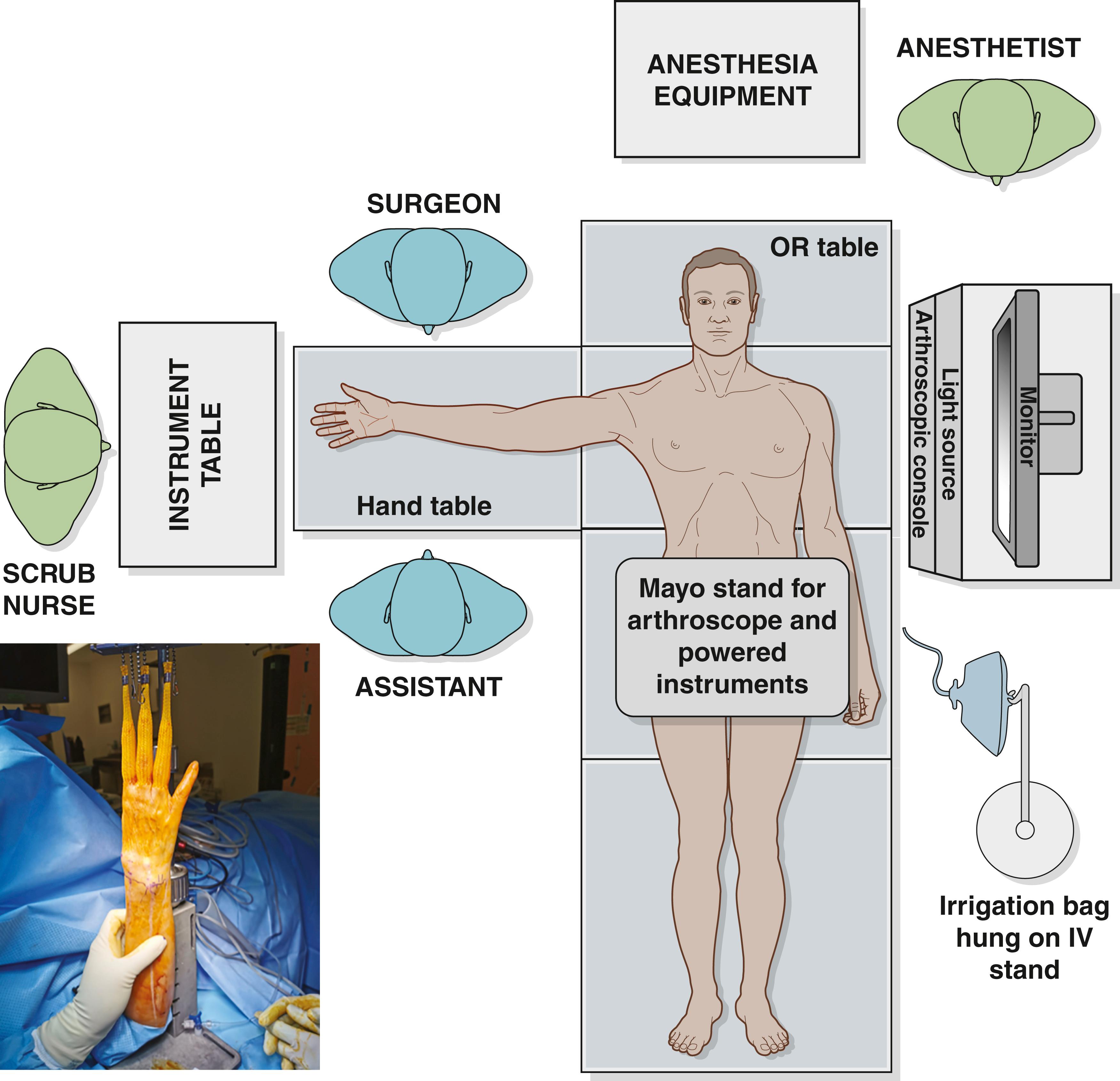
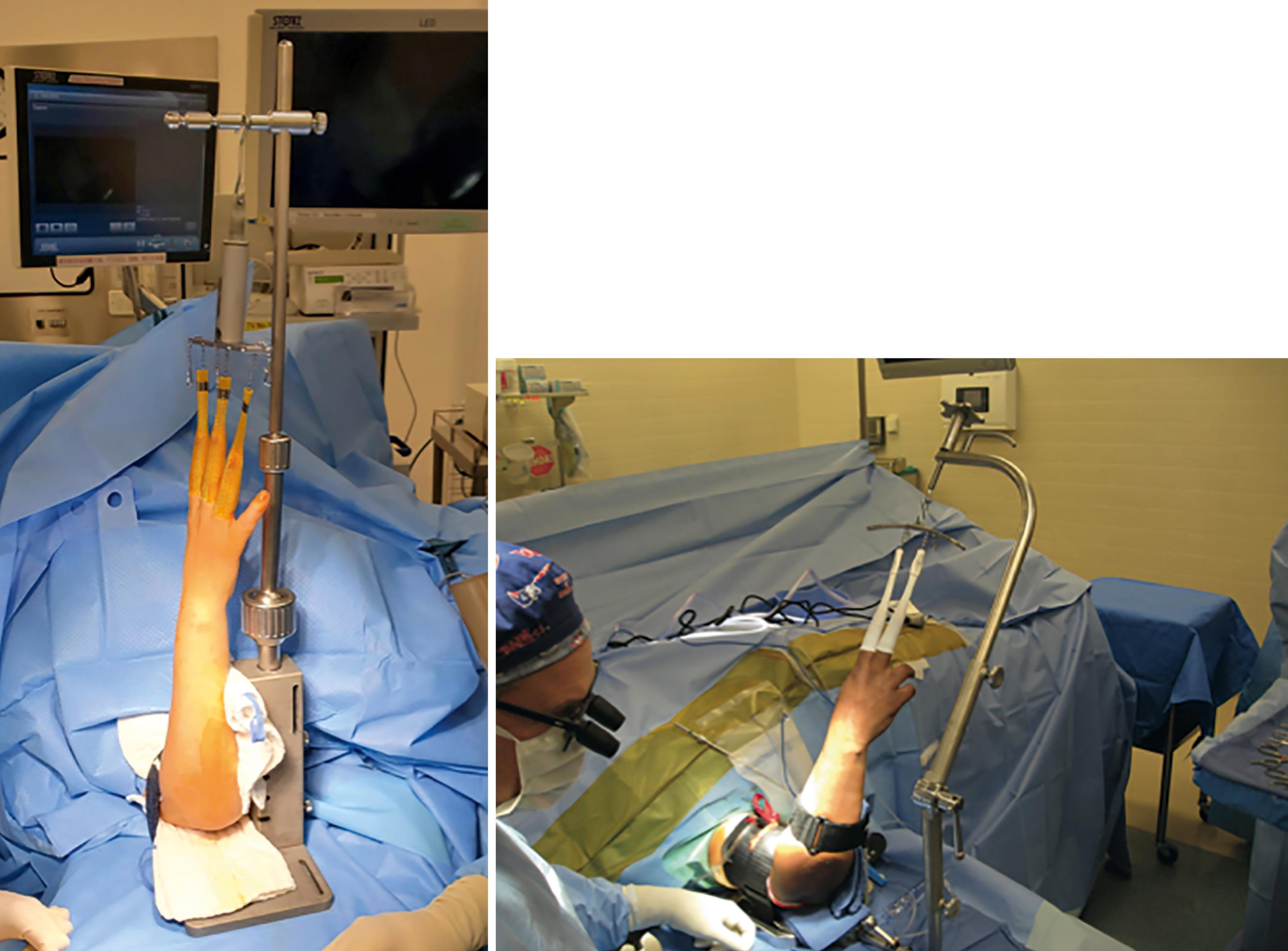
Joint visibility is maintained by saline inflow. In contrast to the knee or shoulder joint where fluid irrigation is essential in distending the joint, the small volume of the wrist makes fluid distention rather impractical. Instead the main maneuver in creating the working space is the controlled traction. The role of saline is to maintain a clear view by removing intraarticular debris through the outflow portal. The hydrostatic pressure generated also serves a hemostatic role when arthroscopy is performed without tourniquet. Continuous irrigation is achieved with a 3 L bag of normal saline suspended 1.5 m above the patient and instilled under gravity. Gentle manual pumping is used occasionally such as in acute fracture treatment for removal of blood clots. Caution should be used to avoid extravasation of fluid that may lead to compartment syndrome. A pressure control device is not essential.
Dry arthroscopy has recently gained popularity because of the perceived advantages of improved visualization and avoidance of fluid extravasation problem. , An initial washing of the joint with 10 to 20 mL of saline through a syringe attached to the side hole of the arthroscopic sheath may be useful for evacuating hematoma or debris, especially if the procedure is used for the evaluation and reduction of articular fractures. To improve visualization, the tip of the arthroscope can be immersed in warm water before putting into the joint to prevent condensation and fogging. The arthroscope can then be dried with small surgical padding inserted through a separate portal. It is important to keep the side valve on the cannula open to air so that suction does not collapse the joint capsule. Suction should be used sparingly as it will stir up the contents of the joint like debris, clot, and saline fluid and blur the vision. The limitations of dry arthroscopy include mandatory use of tourniquet to maintain a bloodless field, preclusion of use of thermal or laser energy application, and visual blurring problems. There is possibility of thermal damage inside the joint by the optical lens, as well as during the use of full-radius resector and bur, which may produce local heat by friction of the rotation mechanism of the instruments, especially if they are being used for prolonged time. This overheating can be overcome by flushing the joint with saline periodically.
A video-arthroscope of 2.3 to 2.7 mm diameter and 30-degree forward oblique viewing angle is most commonly used. Smaller arthroscope of 1.7 to 1.9 mm is usually reserved for the small and tight wrist, carpometacarpal joint, and distal radioulnar joint assessment ( eFig. 17.2 ). Nevertheless, many experienced surgeons use exclusively the 1.9 mm arthroscope because of its small size and versatility to adapt to any joint around the hand and wrist. Extreme care in handling is cautioned as such a delicate arthroscope is vulnerable to breakage. Both blunt and taper-end trocars are used to develop the arthroscopic portals. The latter is especially useful for developing the midcarpal joint portals as this conforms to the configuration of carpal bones better. Extreme care and patience should be exercised to avoid iatrogenic injury to articular cartilage. Sharp-end trocars should be avoided entirely.
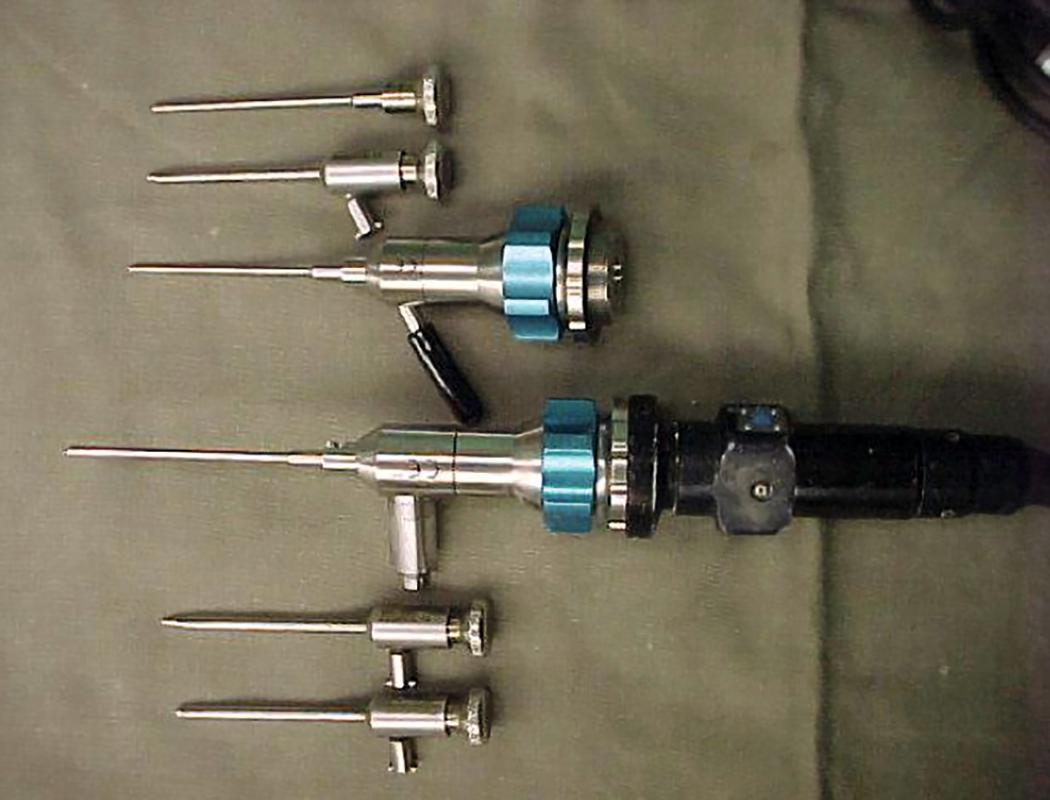
There is a wide array of arthroscopic instruments commonly used for wrist arthroscopy. The newer developments allow expanded indications for therapeutic arthroscopy. The following instruments are considered essential:
Probe with angled tip for palpation of intraarticular structures, assessment of carpal stability, and measurement of chondral defects.
A 16- to 18-gauge needle for outflow portal and for intraarticular palpation
A 2.5-mm suction punch with rounded jaws for joint debridement ( eFig. 17.3 ). The cannulated design allows simultaneous suction to be applied during the debridement procedure so that the synovium or joint debris can be sucked into the jaws of the punch for efficient cutting. The debrided tissue will then be sucked away from within the joint. The rounded design of the jaw adapts well to the configuration of the carpal bone and minimizes iatrogenic scuffing of the articular cartilage.
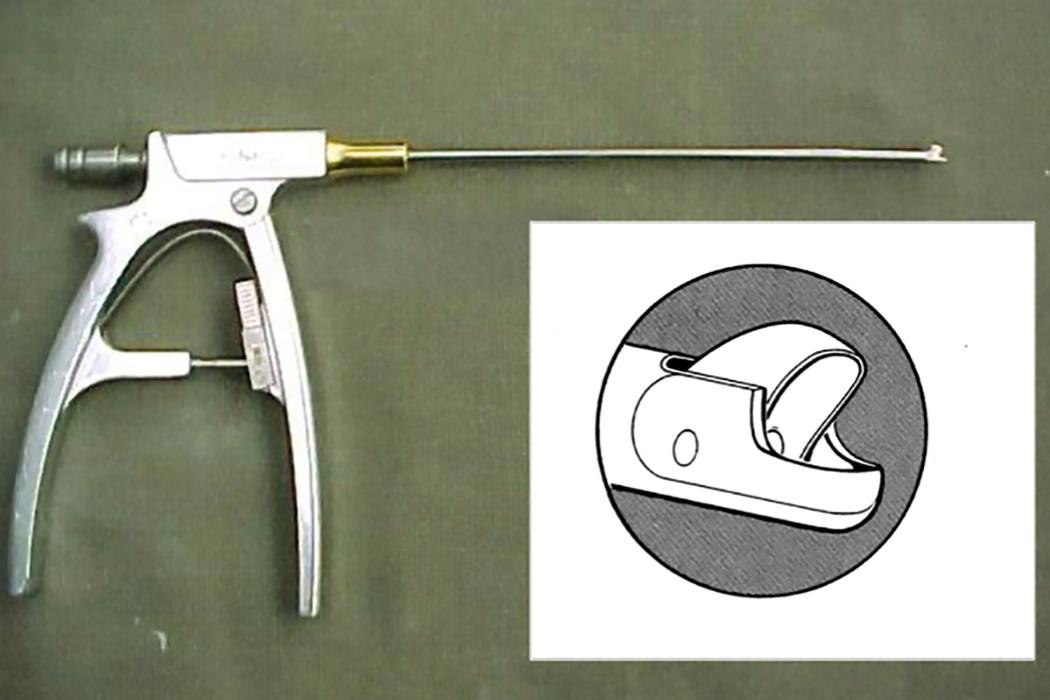
A 2.0- to 2.5-mm fine-tooth mosquito grasping forceps, both straight and angled for removal of debris and loose bodies.
A 2.0- to 2.9-mm cupped-jaw arthroscopic grasping forceps for removal of larger loose bodies and tissue fragments.
Arthroscopic banana and retrograde hook knife for partial excision of triangular fibrocartilage complex (TFCC) tear and loose chondral flap ( eFig. 17.4 ).
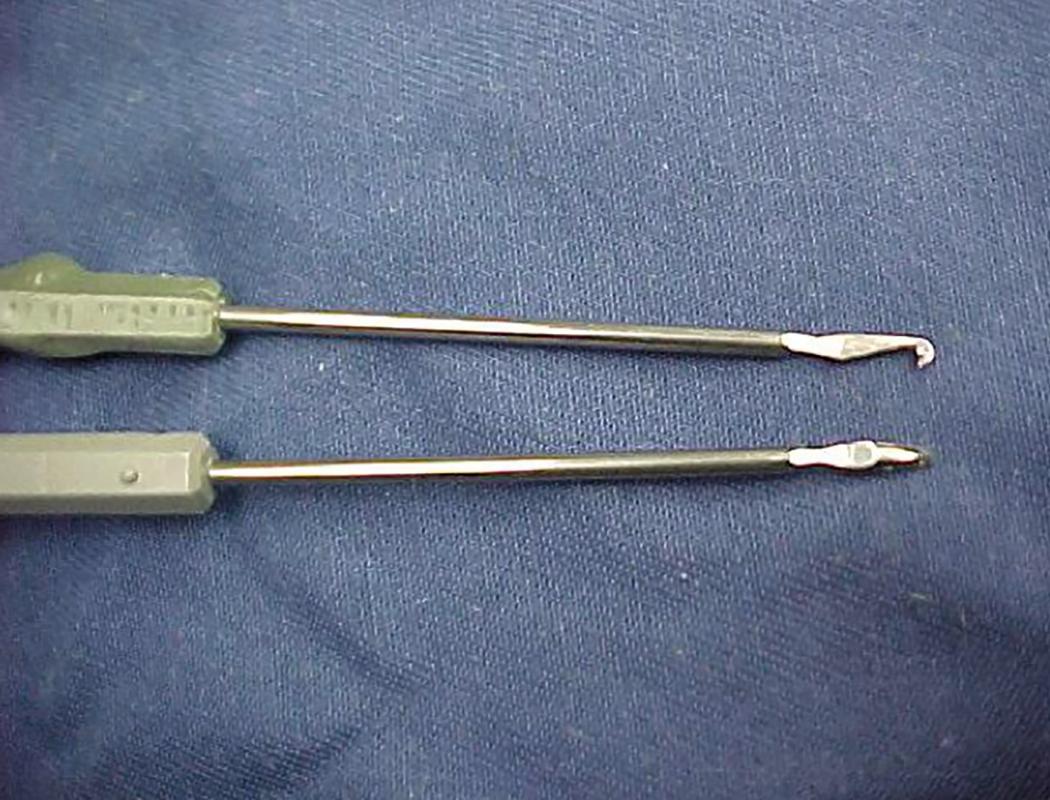
Motorized full-radius shaver and bur system of diameters ranging from 2.0 to 3.0 mm with built-in suction. The hand piece of power instruments should be of light and balanced weight to reduce surgeon’s fatigue and allow more precision control and maneuverability. A foot control device is preferred to hand control for the same reason ( eFig. 17.5 ).
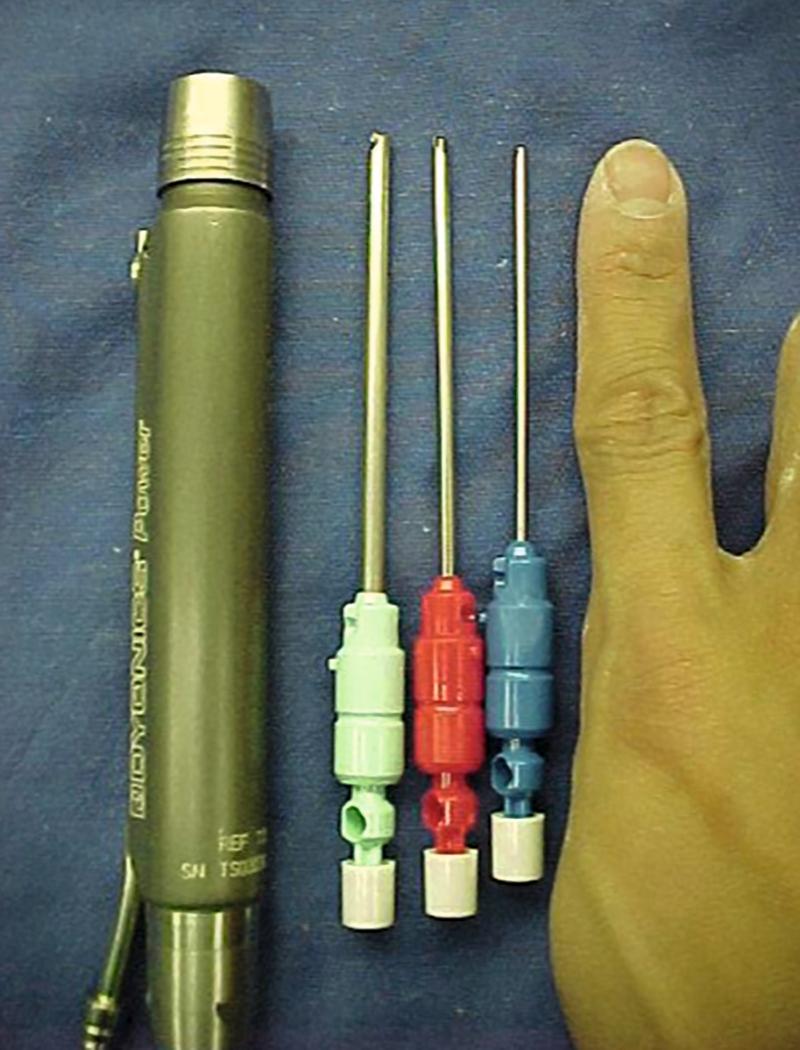
An 18- to 20-gauge epidural needle and TFCC repair kit (INTEQ; Linvatec, Largo, FL) for TFCC repair.
Radiofrequency apparatus with fine probes for intraarticular debridement, partial resection of TFCC, synovectomy, and thermal shrinkage of capsular structures.
Various other electrosurgical and laser instrumentation have been used with variable success. A few procedure-specific instruments such as arthroscopic-assisted scaphoid fracture reduction and TFCC targeting guide have also evolved. ,
There are 11 standard portals for the wrist, including 5 for the radiocarpal joint, 4 for the midcarpal joint, and 2 for the distal radioulnar joint ( eFig. 17.6 ). The techniques, portal landmarks, and naming were first described by Whipple in 1986 in his historic report “Techniques of Wrist Arthroscopy.” Conventional portals are placed dorsally because of their relative lack of important neurovascular structures and easier articular access. However, the extensor tendons and cutaneous nerves are at risk. The lateral portals are in general closer to the major dorsal cutaneous nerves. Abrams found that branches to the superficial radial nerve (SRN) and the radial artery pass within 3 mm of the 1-2 portal. In contrast the nerve is at a mean distance of 16 mm from the 3-4 portal and further remote from the 4-5 portal. Branches of SRN were found radial to the midcarpal radial portal at a mean of 7.2 mm. In a cadaveric study by Shyamalan et al., the posterior interosseous nerve was found to be at risk at the 3-4 and 4-5 portals with mean distances of 4.4 mm and 12.6 mm, respectively. The dorsal cutaneous branch of the ulnar nerve passes within 2.5 mm from the 6R portal and 17.5 mm from the distal radioulnar joint (DRUJ) portal. Uerpairojkit et al. dissected 44 wrists and noted that the areas located proximal and palmar to the tip of the ulnar styloid, corresponding to the 6U portal, had a very high density of dorsal cutaneous branches of the ulnar nerve. They were unable to establish a safe zone ( eFig. 17.7 ). Thus a thorough knowledge on the surface anatomy is mandatory, and soft tissue dissection has to be meticulous when developing the portals, in order to avoid these possible nerve complications.
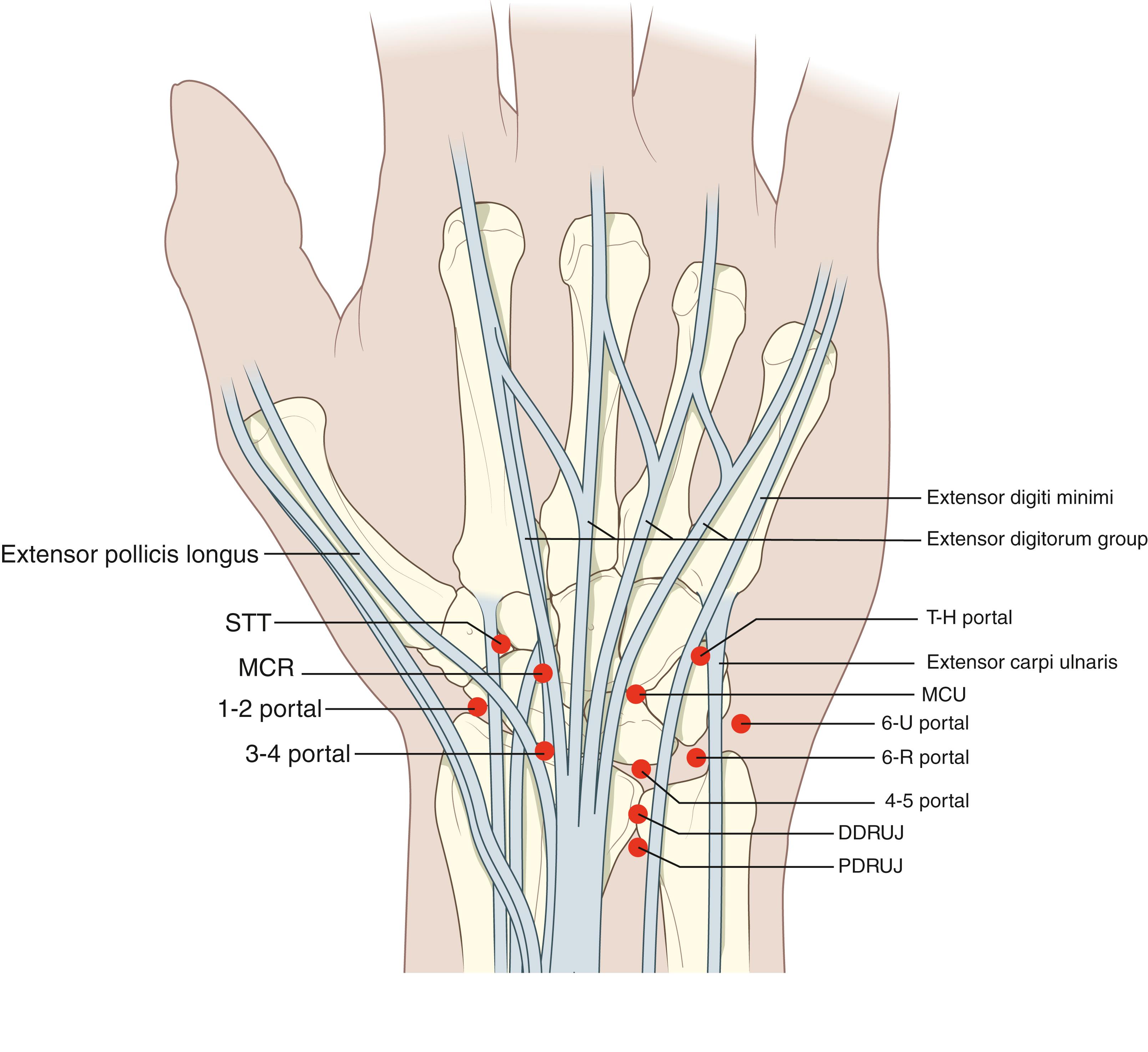
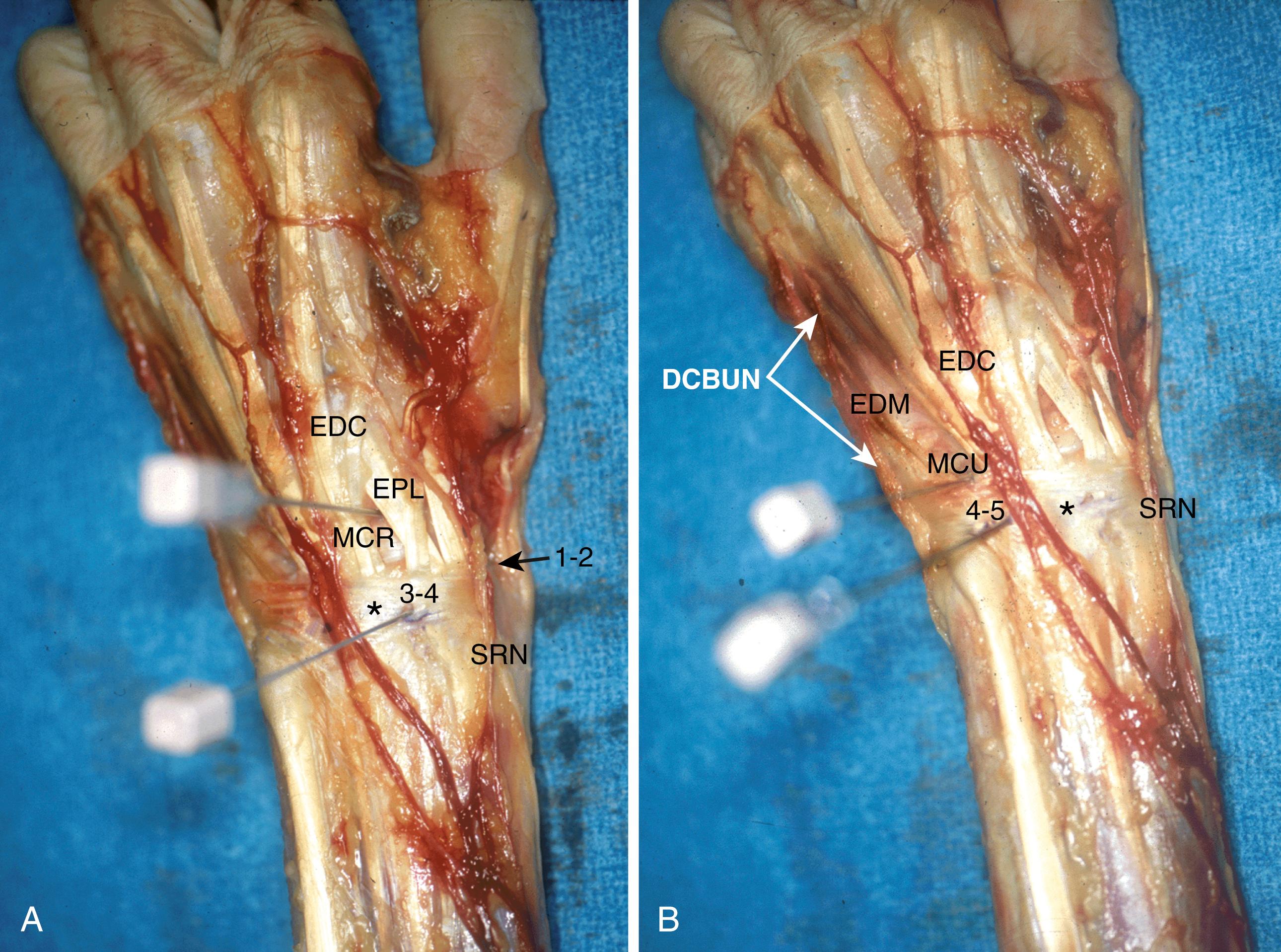
The portals are named after the corresponding extensor tendon compartments and their relationship.
The portal is situated just radial to the extensor carpi radialis longus (ECRL) tendon and just distal to the radius articular rim. The proximity to the radial artery and SRN at the anatomic snuffbox makes it a more risky portal to develop, and hence, it is uncommonly used. , The trick to avoid complications is to develop the portal as close to the wrist extensor tendon as possible but always radial to the EPL tendon. Active thumb extension in an awake patient under local anesthesia facilitates the identification of the portal. At the rim of distal radius, the extensor pollicis longus (EPL) tendon intersects with the ECRL tendon and can be easily identified when the patient actively extends the thumb. The portal is useful in dorsal or volar ganglionectomy, introduction of epidural needle in peripheral TFCC repair, Kirschner wire stabilization in scapholunate instability, and radial styloidectomy.
This fundamental entry portal is situated between the EPL and extensor digiti communis (EDC) tendon compartment just distal to the Lister tubercle. In developing the portal, the trocar should aim at about 10 to 15 degrees palmar inclination to accommodate the natural tilt of the articular surface. Due to the inclination of the distal radius articular surface, the portal is located more proximal than the 1-2 portal. The portal should view directly over the scapholunate junction. The landmark structure is the ligament of Testut, or otherwise described as the “intraarticular fat-pad” by Whipple. This is the most commonly used and convenient portal as it can reach almost any area of the radiocarpal joint except the far ulnar-sided structure such as the lunotriquetral ligament.
The portal is situated between the EDC and extensor digiti minimi (EDM) compartments. Palpation of this portal is the least precise of the various portals in the radiocarpal joint as it may be obscured by the thick extensor tendons. The clue to its localization is to define the DRUJ first by rotating the forearm. The portal can then be found as a depression just distal to the DRUJ. This is a favorable working portal for the author as the arthroscopic instruments can easily reach both radial and ulnar sides of the radiocarpal joint. In developing the portal, one should pay attention to the overlying dorsal vein, which is consistently present. Inadvertent puncture of the vein will cause troublesome portal bleeding; the vein can usually be easily visualized and avoided when a tourniquet is not used.
The 6R portal is situated just radial to the sixth dorsal compartment, the extensor carpi ulnaris (ECU) tendon. It can be easily identified by palpating the confluence point between the tendon and the triquetrum. The surgeon should not place the portal too close to the ulnar head as one may go into the DRUJ inadvertently underneath the TFCC. By using the thumbnail for palpation, one can delineate the proximal curvature of the triquetral bone and the joint space can then be well defined just proximal to it. Care should be taken to avoid injury to the dorsal sensory branch of ulnar nerve (DSBUN) and the TFCC. A safer way of establishing this portal and the 4-5 portal is to make them under direct vision after the arthroscope is advanced from the 3-4 portal to illuminate the ulnar side of the joint. The 6R portal provides an excellent view of the TFCC, lunotriquetral ligament, and the pisotriquetral orifice, which is known to be present in 82% to 88% of subjects. , As this portal potentially traverses the ECU subsheath, which is part of the TFCC, the author does not routinely create this portal as well as the 4-5 portal until a full diagnostic inspection of the ulnocarpal joint including the dorsal part of the TFCC is accomplished to avoid confusion of diagnosing a dorsal TFCC tear. The portal provides an excellent and direct access for the instruments to work on TFCC lesions such as in TFCC debridement. It is also used routinely as the entry portal for dorsal ganglionectomy.
The portal is established just ulnar and volar to the ECU tendon at the ulnar snuffbox. The portal points to the prestyloid recess and is used commonly as the outflow portal ( eFig. 17.8 ). It is also used to facilitate arthroscopic repair of type 1b TFCC peripheral tears. Precaution has to be taken to avoid injuring the DSBUN during portal development.
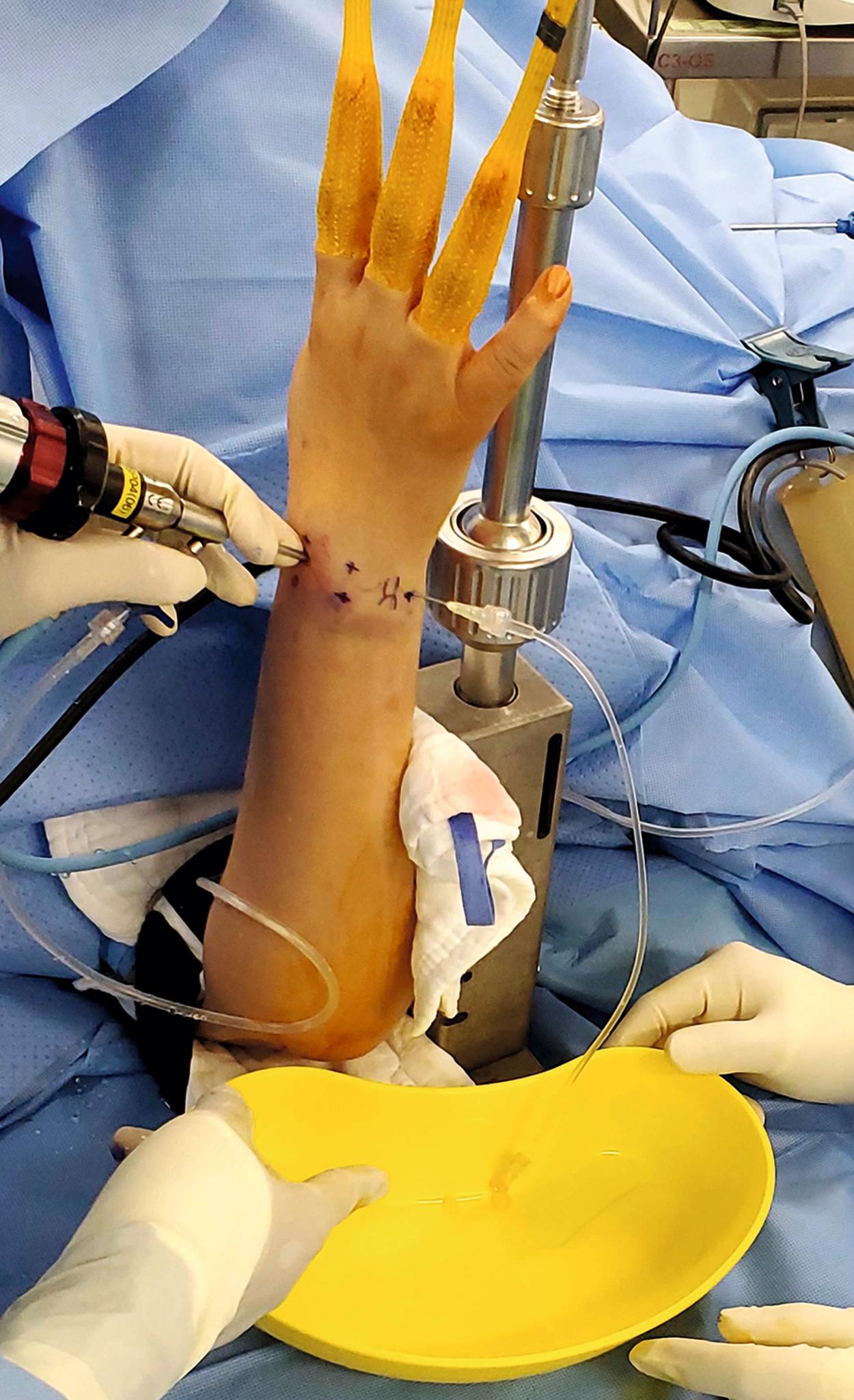
The midcarpal joint portals are named after their joint positions and include the following:
The midcarpal radial (MCR) portal is situated 1 cm distal to the 3-4 portal in line with the radial border of the third metacarpal. The soft depression corresponds to the junction between the concave surface of scapholunate joint and the convex head of capitate in the midcarpal joint. Another useful trick is to locate the base of the second metacarpal and the Lister tubercle by palpation. The portal just lies midway between these two landmarks. In contrast to the 3-4 portal, the direction of the trocar should be straight dorsal to palmar and should point slightly toward the midline. This aims to insert the trocar into the more spacious area between the proximal scaphoid, lunate, and capitate instead of the space between the scaphoid waist and capitate to diminish the chance of iatrogenic injury to the articular cartilage. A trocar with a tapered end is preferred due to the carpal bone configuration and relatively smaller space. Extreme gentleness should be exercised in developing the portals in the midcarpal joint. This is the most commonly used entry portal for diagnostic examination of the midcarpal joint. In arthroscopic bone grafting, it is the ideal working portal for carrying out the grafting procedure especially in the proximal third location.
The midcarpal ulnar (MCU) portal is located 1 cm distal to the 4-5 portal in line with the fourth metacarpal. This is situated at the junction between the four-corner bones: lunate, triquetral, hamate, and capitate. This soft depression may not be easily identified for an inexperienced surgeon. One trick is that it invariably lies at the same level of the MCR portal distal to the 4-5 portal. This portal is a very useful portal in a stiff wrist condition such as posttraumatic or rheumatoid arthritis, as the ulnar side of midcarpal joint tends to be less involved and is often more spacious. The portal is normally used for probing and instrumentation.
The scaphotrapeziotrapezoid (STT) portal, or STT-u portal, is situated about 1 cm radial and slightly distal to the MCR portal just ulnar to the EPL tendon. The portal is located at the junction between the scaphoid, capitate, and trapezoid. Care should be taken to avoid injury to the radial artery, which is radial to the EPL tendon. It is useful as an outflow portal and in the management of scaphoid injuries. This is also a convenient portal for introducing a needle to evacuate bubbles within the midcarpal joint as these bubbles tend to be trapped in the more distal STT joint area. When the thumb is put under traction, it is possible to advance an arthroscope of small caliber anteriorly into the trapezoid-trapezial area. However, visualization of the most anterior palmer ligament is usually not possible. Additional portals in the STT joint are required. The STT-R portal as described by Carro et al. in 2003 is located at the same level as the STT joint but radial to the abductor pollicis longus (APL) tendon. Baré et al. also described a palmar (STT-p) portal in a cadaveric study. The portal can be established 3 mm ulnar palmar to the APL tendon, 6 mm radial to the scaphoid tubercle, and midway between the radial styloid and the base of the first metacarpal. These portals may be made in conjunction with the standard STT portal for resection of the distal portion of the scaphoid or in resection of ganglion arising from the STT joint.
The triquetrohamate (TH) portal described by Viegas in 1994 is seldom used for entry or working portal due to its natural tightness. It can be located by palpating the dorsal aspect of the ECU tendon and moving distally until the palpating thumb reaches the hamate bone. The portal is then located at the axilla between the ECU tendon and the hamate. It is an accessory portal reserved for outflow use. It corresponds to the level of triquetral-hamate joint.
Arthroscopy of the DRUJ was first described by Whipple in 1994. DRUJ arthroscopy is not commonly performed because of the intrinsic difficulty and a limit on what can be done therapeutically. Usually a smaller size of arthroscope such as 1.9 mm diameter is required to establish the portal. However, in rheumatoid arthritis, the portal tends to be easier to develop as the capsule is distended by the synovitis process. Similarly, if the TFCC is avulsed from the foveal region, the space distal to the ulnar head will also become more spacious. Portal location is best defined by direct palpation of the DRUJ with the forearm in fully supinated position with traction reduced. Two portals exist. The proximal DRUJ (PDRUJ) portal is located at the axilla between sigmoid notch and the ulnar head. The distal DRUJ (DDRUJ) portal is identified just proximal to the taut structure of the dorsal radioulnar ligament at the distal end of the DRUJ. It also lies slightly proximal to the 4-5 portal. In patients with perforated TFCC, the working portal for the DRUJ can be gained through the 4-5 or 6R portal, visualizing through the perforation.
The volar portals are not standard portals commonly used by wrist arthroscopic surgeons. Most of the wrist joint areas can be reached using the dorsal portals. Nevertheless, these relatively newer portals provide visualization on specific areas of the wrist that are not easily accessible with the conventional dorsal portals and thus serve good complementary roles. Bain et al. described the possibility of having viewing and working portals that encircle the wrist as the “box concept.”
Two volar portals have been described in the radiocarpal joint to view the dorsal structures and the volar aspect of the interosseous ligaments.
The volar radial (VR) portal first described by Jantea et al. is made between the interval of the radioscaphocapitate (RSC) ligament and the long radiolunate (LRL) ligament. , This portal is most easily made by placing the arthroscope directly through that interligamentous interval with the scope in the 3-4 portal. The scope is removed from the cannula, and a blunt trocar or switching stick is then inserted into the cannula and gently passed through the volar capsule, tenting the skin on the volar aspect of the wrist near the radial artery. A small incision is then made in the skin, and the switching stick is bluntly eased through the skin incision. The cannula is removed from the dorsal portal and reinserted around the switching stick into the joint through the volar portal. Abe et al. reported the use of volar portal in 230 patients in Japan from 1992 to 2001. The portal was developed by an outside-in approach, just radial to the flexor carpi radialis (FCR) tendon at the level of proximal wrist flexion wrist ( eFig. 17.9 ). The radial artery and venae comitantes were retracted radially and the FCR tendon and median nerve retracted ulnarly. The volar capsule was exposed through the tendon sheath of FCR and a small 3-mm incision was made parallel to the capsular fibers. The portal was then opened between the LRL and RSC ligaments. This approach provided access to dorsal rim fragment of intraarticular fracture of distal radius, dorsal synovial proliferation of the rheumatoid wrist, and volar segment tear of the scapholunate and lunotriquetral ligaments. A similar approach was used by Verhellen and Bain in arthroscopic release for cases of capsular contracture.
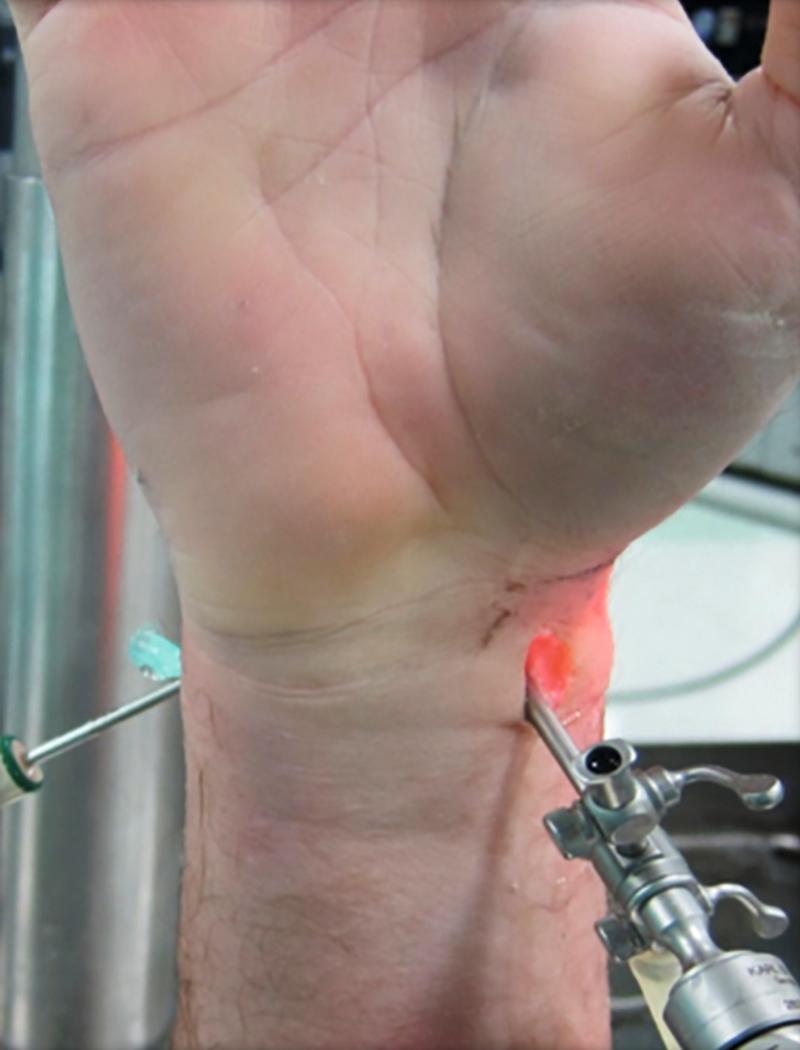
The volar ulnar (VU) portal described by Slutsky is established via a 2-cm longitudinal or zigzag incision centered just proximal to the wrist crease along the ulnar edge of the finger flexor tendons. These tendons are retracted to the radial side and the flexor carpi ulnaris (FCU) tendon and ulnar neurovascular bundle retracted to the ulnar side. Just distal to the pronator quadratus, the radiocarpal joint space is identified and pierced with a 22-gauge needle. Blunt tenotomy scissors are used to pierce the volar capsule, followed by insertion of the trocar/cannula, then the arthroscope. The ulnar nerve is protected by use of the cannula. The median nerve is protected by the adjacent flexor tendons. This portal penetrates between the ulnolunate (UL) and ulnotriquetral (UT) ligaments adjacent to the radial insertion of the TFCC. The palmar region of the lunotriquetral ligament can usually be seen slightly distal and radial to the portal. Alternatively, the VU portal can be made by an inside-out technique with the arthroscope in the 3-4 portal. A blunt trocar is inserted through the 6U portal and pushed anteriorly through the ulnar carpal joint complex between the UL and UT ligaments exiting the floor of the flexor tendons. It is important to remember that the ulnar artery and nerve are located 5 mm ulnar to the trocar, and the median nerve is protected by the flexor tendons. This portal provides a view of the dorsal articular surface of the radius and the dorsal extrinsic ligaments.
For the midcarpal joint, Slutsky also described a volar midcarpal (VM) portal. To make the VM portal, a skin incision is made similar to the outside-in technique for the VR portal. The volar aspect of the midcarpal joint is identified with a needle at an average of 11 mm distal to the entry of the VR portal. The joint is enlarged with a hemostat and blunt trocar. This portal may be useful for assessing the palmar aspect of the capitate and hamate.
In the DRUJ, two volar portals have been described. The volar DRUJ (V-DRUJ) portal uses the same landmarks as previously described for the VU portal. After a skin incision has been made, the flexor tendons are retracted radially and the FCU tendon and ulnar neurovascular bundle are retracted ulnarly to expose the joint capsule. The portal is located with a needle and then enlarged.
Lastly the direct fovea (DF) portal , as described by Atzei et al., is located 1 cm proximal to the standard 6U portal. To make the portal, the forearm is held in full supination. This produces dorsal displacement of the ulnar styloid and the ECU tendon and uncovers the palmar aspect of the distal ulna. This portal is bound by the ECU tendon dorsally and the FCU tendon volarly. Care should be taken to dissect and protect the DSBUN with a vessiloop. This portal is generally used as a working portal for possible repair of the articular disk to the ulnar fovea with suture anchor technique or for debridement.
For radiocarpal joint examination, the author routinely uses the 3-4 portal as the universal viewing portal since the arthroscope can reach virtually all aspects of the radiocarpal joint. The 4-5 portal is preferred over the 6R portal as the portal for probing and instrumentation. The more central location of the 4-5 portal enables the surgeon to reach both radial and ulnar side of the wrist freely. Moreover, there is higher risk of injury to the TFCC and DSBUN at the 6R portal. The 6U portal is reserved for outflow using an 18-gauge needle. When performing wrist arthroscopy to evaluate the cause of chronic ulnar wrist pain, the 4-5 portal should be developed only after the ulnar side of the wrist is being visualized through the arthroscope inserted at the 3-4 portal. Otherwise the synovial protrusion induced by the portal creation may confuse with the pathology on the ulnocarpal joint. In general there is limited role for the volar portals, as even pathology over the dorsal side of the wrist joint such as synovitis, dorsal ligament, or capsular anomalies can be visualised via the dorsal portals over the lateral aspect of the wrist such as the 6R or 1-2 portals. By rotating the arthroscopic lens clockwise to the 4 or 5 o’clock position, or counterclockwise to the 7 or 8 o’clock position, most of the dorsal structures can be seen fairly well.
For midcarpal examination, the MCR portal is the universal portal to start with in most cases, as the arthroscope can reach freely the SST joint on the radial side to the triquetrum-hamate joint ulnarly. It also has a better visualization to evaluate scapholunate joint stepping and gapping. However, the scaphocapitate joint interval may become excessively tight in radial sided pathology such as chronic scaphoid nonunion and scapholunate advanced collapse (SLAC). Under these circumstances, or whenever difficulty is encountered in developing the MCR portal, one shouldn’t hesitate to switch to the MCU portal. The STT portal is not routinely used, unless specific pathology is noted at the STT joint. VM portal is seldom required.
DRUJ arthroscopy is seldom performed in isolation. Often in patients with ulnar wrist pain, the DRUJ structures, including the ulnar head, part of the sigmoid notch, and synovial lining of the DRUJ capsule, can be assessed via the perforation of the TFCC from the radiocarpal joint. In patients with foveal avulsion injury of the TFCC, the fovea part of the radioulnar ligament can be assessed through the frequently torn ulnar capsule and the prestyloid recess with the arthroscope positioned at the 4-5 or 6R portal. Nevertheless, the visualization of the foveal origin of the radioulnar ligaments is still better at the DRUJ portals. Therefore DRUJ arthroscopy should be considered in patients with foveal avulsion of TFCC and painful DRUJ instability if the assessment at the radiocarpal joint does not generate all the required information to make a surgical decision.
It is worldwide practice that wrist arthroscopy is performed under general or regional anesthesia with the aid of tourniquet to maintain bloodless field. Since the late 1970s, local anesthesia using intraarticular infiltration has been advocated for both diagnostic and therapeutic procedure in knee and ankle arthroscopy with good results. , Nevertheless the large volume of anesthetic solution required for an effective procedure carries potential risk. Rolf et al. described the technique of injecting anesthetic solution into the portal sites alone and reported satisfactory results in knee arthroscopy. We have been using portal site local anesthesia (PSLA) without tourniquet in performing wrist arthroscopic procedures since 1998 with promising results.
Typically no sedation is required. The patient is widely awake and can observe the procedure through the monitor. Thus the patient’s comfort during the procedure is of utmost importance. The patient is positioned supine and the affected upper limb is abducted at shoulder level and supported on a hand table. The shoulder should not be abducted 80 degrees or more, as excessive shoulder abduction in addition to forearm supination can cause patient discomfort. Moreover, if subsequent imaging or manipulation for other procedures requiring the hand to be placed back on the hand table, overabduction of the shoulder will cause difficulty and patient discomfort in properly pronating the forearm and hand to obtain adequate imaging views. The hand is subjected to digital traction through finger traps by using a wrist traction tower. A plastic trap is preferred over a metal one as the latter is poorly tolerated by the patient. Three finger traps are used for the index, middle, and ring fingers for a more even distribution of the traction force. The arm and forearm of the patient is well padded and connected to the traction tower. Excessive traction must be avoided and usually 10 to 12 pounds of force suffices.
Under traction, the various standard portals for arthroscopy are marked on the skin through thumb tip palpation. The surgeon injects 2% lidocaine with 1:200,000 adrenaline through a 25-gauge needle into the various standard portals, starting from the joint capsule and then withdrawn slowly to reach the subcutaneous layer and skin. Intraarticular infiltration is not necessary, and each portal site receives 1 to 2 mL of the solution ( eFig. 17.10 ). The anesthetic mixture also provides effective local hemostasis in the joint capsule and synovium, therefore obviating the routine use of a tourniquet. The action of the 2% lidocaine usually works within 30 to 60 seconds. The radiocarpal joint is then distended by injecting 3 to 5 mL of saline at the 3-4 portal. Any swelling developing over the dorsal DRUJ during this action should alert the surgeon on the possibility of TFCC injury as the saline leaks into DRUJ through the torn TFCC. Skin incision is performed using a #15T surgical blade (Swann-Morton, Sheffield, England). We prefer transverse incision along skin crease to longitudinal one for better scar healing and cosmetic appearance. To avoid injuries to the underlying important cutaneous nerve and tendinous structures, we recommend stretching and stabilizing the skin with the surgeon’s left thumb and index finger, while making the incision with the right hand using a 15T blade only onto the skin, followed by gentle soft tissue spreading using a fine curved mosquito hemostat to dilate the portal and spread out the underlying structures ( Fig. 17.2 ). Egress of saline fluid is noted when the capsule is perforated, confirming the intraarticular location. An arthroscopic cannula with blunt- or tapered-end trocar is inserted gently through the portal. Extreme care is exercised to avoid inadvertent injury to the articular cartilage or ligamentous structures. The trocar is removed and the arthroscope is inserted to the joint through the cannula. The cannula is then connected by long tubing to a 3 L saline bag hung 1.5 meters above the patient using a drip post or similar device. Continuous saline irrigation with the aid of gravity is provided for maintaining a clear arthroscopic view. An infusion pump is not used as this may produce tension discomfort of the joint.
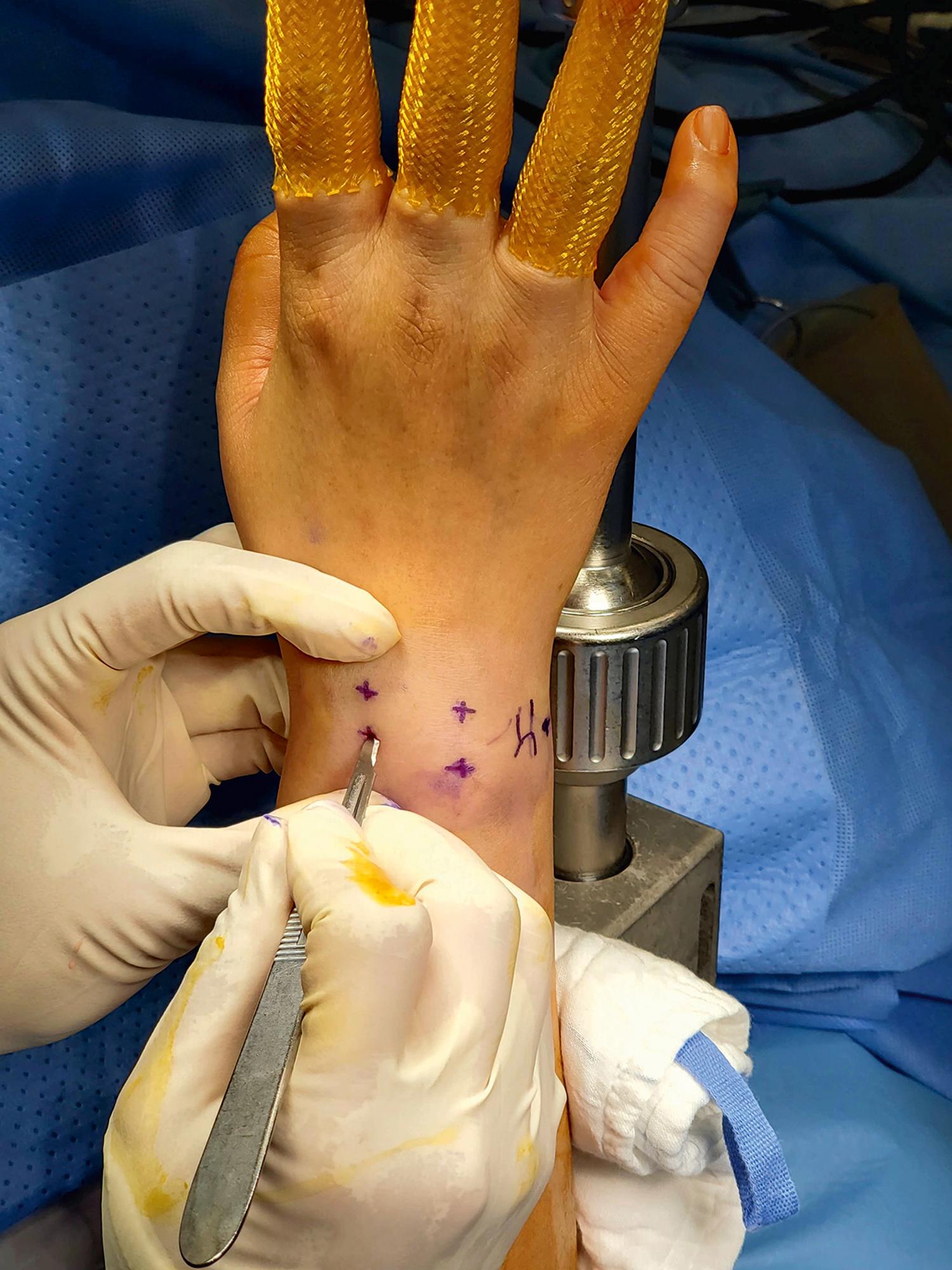
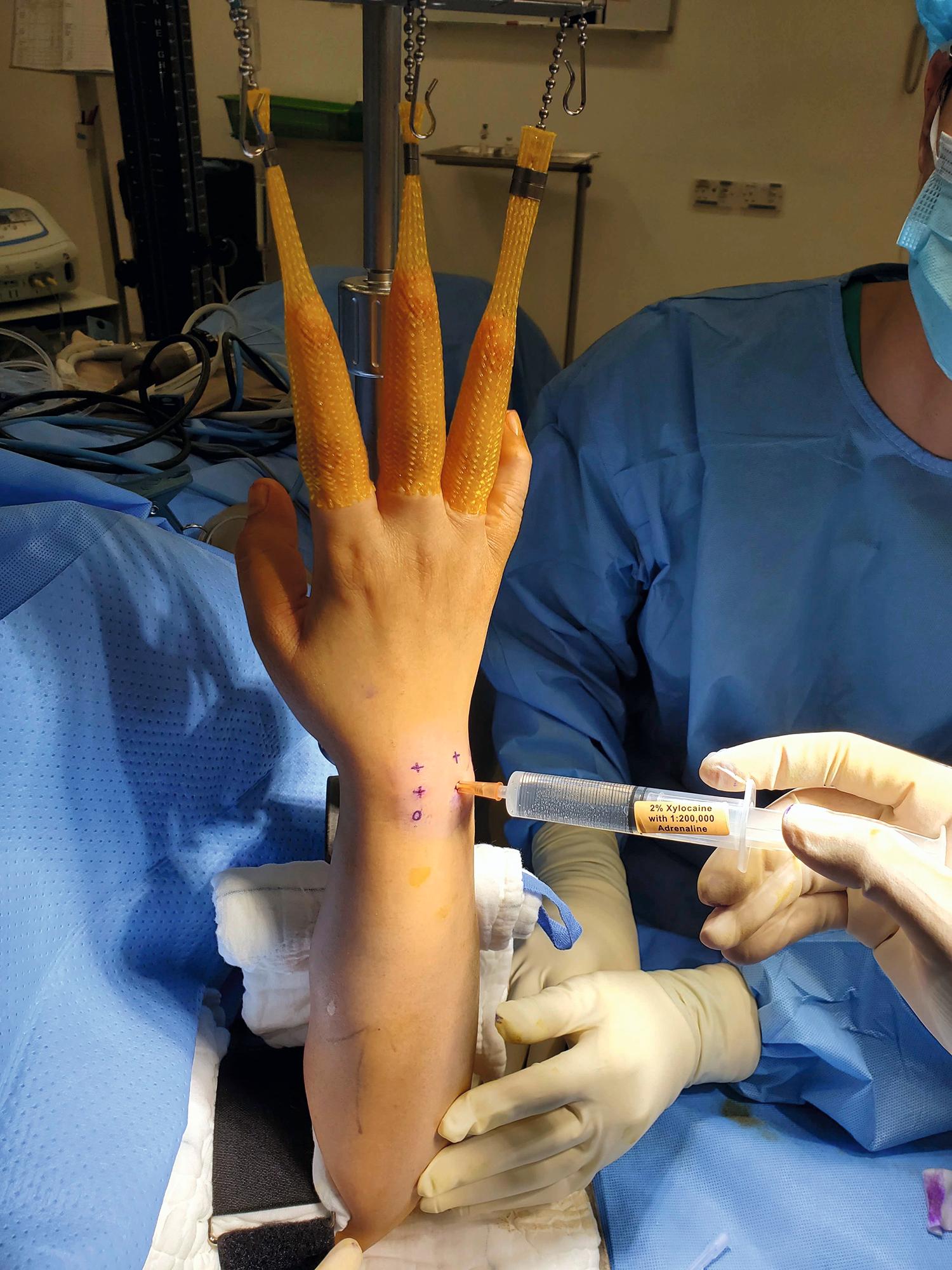
The patient is monitored during the operation for any discomfort or pain. When difficulty is encountered during portal establishment or intraarticular manipulation, it is generally due to the patient’s anxiety or muscular tension rather than inadequate anesthesia. A useful trick is to look at the posture of the fingers of the patient. An extended position of the thumb or fingers that are not included in the traction device generally indicates heightened anxiety ( Fig. 17.3 ). Under such situations, the patient should be calmed and taught to relax until the thumb and little finger assume a semiflexed relaxing posture. This is usually an effective way to solve the joint tightness problem with immediate effect. A complete diagnostic examination of both radiocarpal and midcarpal joints is performed and therapeutic procedures can be done at the same setting as needed ( ![]() ). Standard arthroscopic instruments and equipment are employed.
). Standard arthroscopic instruments and equipment are employed.
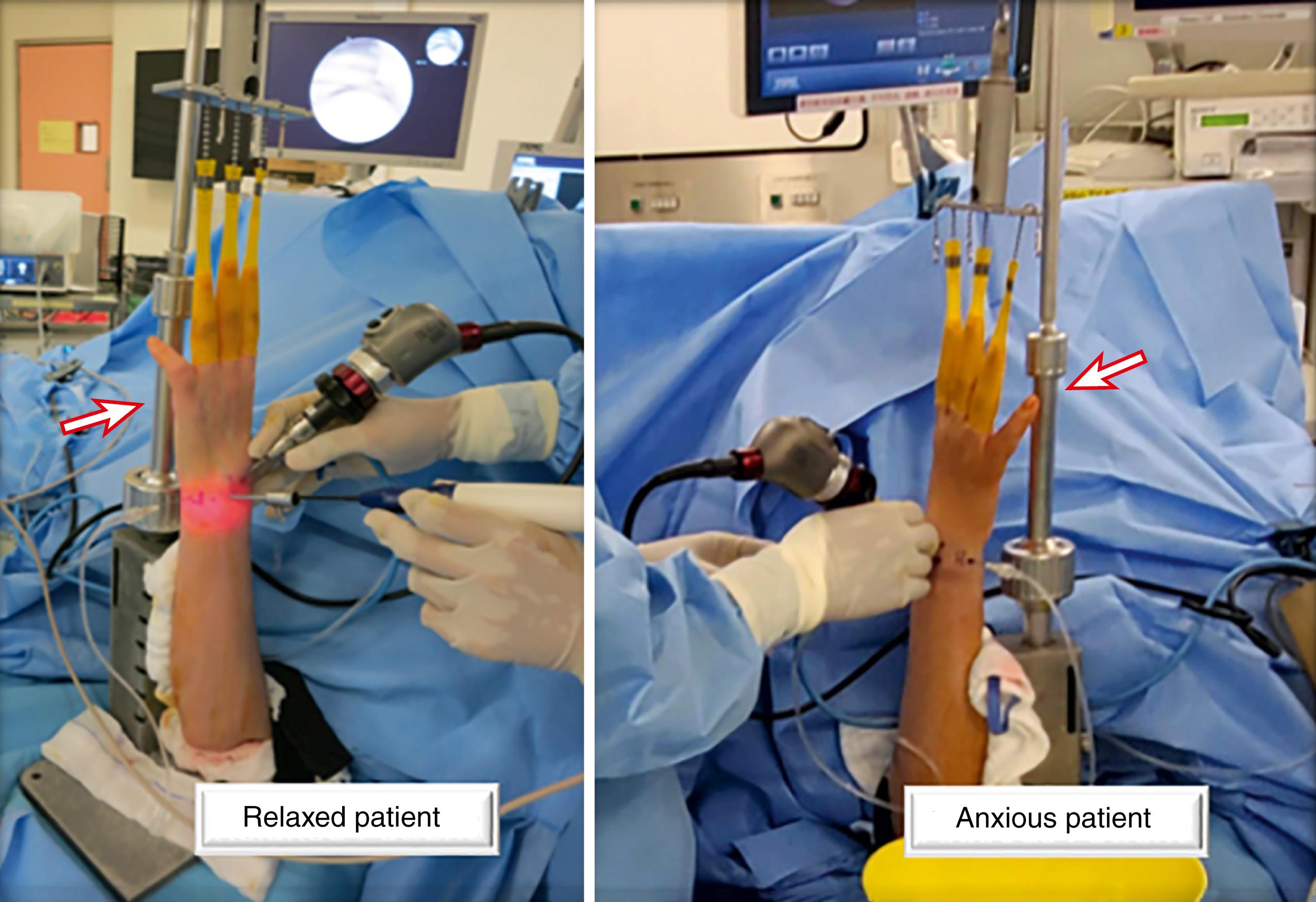
Ong and Ho reported the result of the technique in 111 consecutive cases of wrist arthroscopy. The therapeutic procedures included synovectomy, synovial biopsy, thermal shrinkage, ganglionectomy, TFCC repair, radial styloidectomy, partial ulnar osteotomy, and distal scaphoidectomy. Satisfactory level of comfort was reported in 88% of patients. When local anesthesia is used without sedation, it is possible for the surgeon to communicate with the patient directly and to engage the patient actively in decision making during the procedure. The patient would also have a clearer understanding of his or her own pathology and the treatment rationale, which is beneficial for prognosis and in the subsequent rehabilitation process. It is also possible to check active tendon motion and peripheral nerve function intermittently, during, and immediately after the therapeutic procedures, thus providing safety reassurance ( ![]() ).
).
It is recommended that a complete wrist arthroscopic examination includes both the radiocarpal and midcarpal joints. The usual sequence is the radiocarpal joint followed by the midcarpal joint. However, the choice should depend on the clinical site of suspicion. In the author’s experience, the findings in the midcarpal joint are often normal or insignificant when the pathology in the radiocarpal joint is clearly identified and fully accountable for the clinical signs and symptoms. A typical example is a complete peripheral tear of the TFCC in the case of chronic ulnar wrist pain, especially when all the preoperative physical signs point to a TFCC problem. In these cases, midcarpal joint examination may not be obligatory. However, the decision should be influenced by the surgeon’s own experience and clinical judgment.
A typical radiocarpal joint examination starts at the 3-4 portal as the viewing portal. The 6U portal is commonly employed for outflow using an 18-gauge needle or plastic angiocatheter. It is important to adopt a systematic approach in evaluating all the major intraarticular capsuloligamentous structures and the articular surfaces. Typically from the 3-4 portal, the first structure being seen is the ligament of Testut, or the radioscapholunate ligament ( eFig. 17.11 ). This ligament originates at the volar margin of the intercondylar ridge of the distal radius and inserts on either side of the volar scapholunate (SL) ligament. It is an important landmark of the radiocarpal joint, though biomechanically it is not a true ligament but contains some fibrovascular tissue providing minor blood supply to the proximal scaphoid. Moving toward the radial styloid, the intracapsular LRL ligament and RSC ligaments are identified. The RSC ligament is the most radial extrinsic ligament that can be easily viewed. The LRL ligament is just ulnar to the RSC ligament and may be two to three times the width of the RSC ligament. , There is a clear sulcus between the two extrinsic ligaments ( eFig. 17.12 ). Following the proximal scaphoid and orientating the arthroscope dorsoradially along the curvature of the scaphoid, it is possible to reach the dorsal ridge of the scaphoid at the waist portion where capsular reflection is attached at the anatomical snuffbox region ( eFig. 17.13 ). Then returning the scope to the radiocarpal joint and looking downward, the articular cartilage of the radial styloid, proximal scaphoid, and distal radius scaphoid fossa are visible. The radial styloid should be examined for any sign of chondromalacia or synovitis, which is commonly seen in SLAC wrists ( eFig. 17.14 ). Part of the dorsal and proximal membranous portion of SL ligament between the scaphoid and the lunate is visualized when arthroscope is moved back to the dorsocentral part of radiocarpal joint ( eFig. 17.15 ). It should have a normal concave appearance between the two carpal bones ( eFig. 17.16 ). Loss of normal concave appearance of the SL ligament with hemorrhage can be seen in acute Geissler grade I and II tears and a torn ligament with a gap between scaphoid and lunate in Geissler grade III and IV tears. Tophaceous deposits on the SL ligament may help in the differential diagnosis of gout in patients presenting with acute wrist pain and inflammation, which can mimic traumatic disruption ( ![]() ). In chronic injury, the normal concavity of the SL ligament may become a convex redundant mass of soft tissue due to tissue attenuation. It can also present as a complete disruption of the ligament with retracted fibrotic stumps that are not amendable for repair. Moving ulnarly, the proximal articular surface of the scaphoid fossa and lunate fossa of the distal radius, the interfacet ridge ( eFig. 17.17 ), and the corresponding articulating surface of proximal scaphoid and lunate can be seen. On the volar side of the lunate fossa, and often partly obscured by the radioscapholunate ligament, the short radiolunate (SRL) ligament may be identified with a rich synovial lining on the inside of the ligament facing the joint ( eFig. 17.18 ). This synovium-rich ligament explains the frequent observation of early bony erosion and destruction of the radiolunate joint in rheumatoid arthritis.
). In chronic injury, the normal concavity of the SL ligament may become a convex redundant mass of soft tissue due to tissue attenuation. It can also present as a complete disruption of the ligament with retracted fibrotic stumps that are not amendable for repair. Moving ulnarly, the proximal articular surface of the scaphoid fossa and lunate fossa of the distal radius, the interfacet ridge ( eFig. 17.17 ), and the corresponding articulating surface of proximal scaphoid and lunate can be seen. On the volar side of the lunate fossa, and often partly obscured by the radioscapholunate ligament, the short radiolunate (SRL) ligament may be identified with a rich synovial lining on the inside of the ligament facing the joint ( eFig. 17.18 ). This synovium-rich ligament explains the frequent observation of early bony erosion and destruction of the radiolunate joint in rheumatoid arthritis.
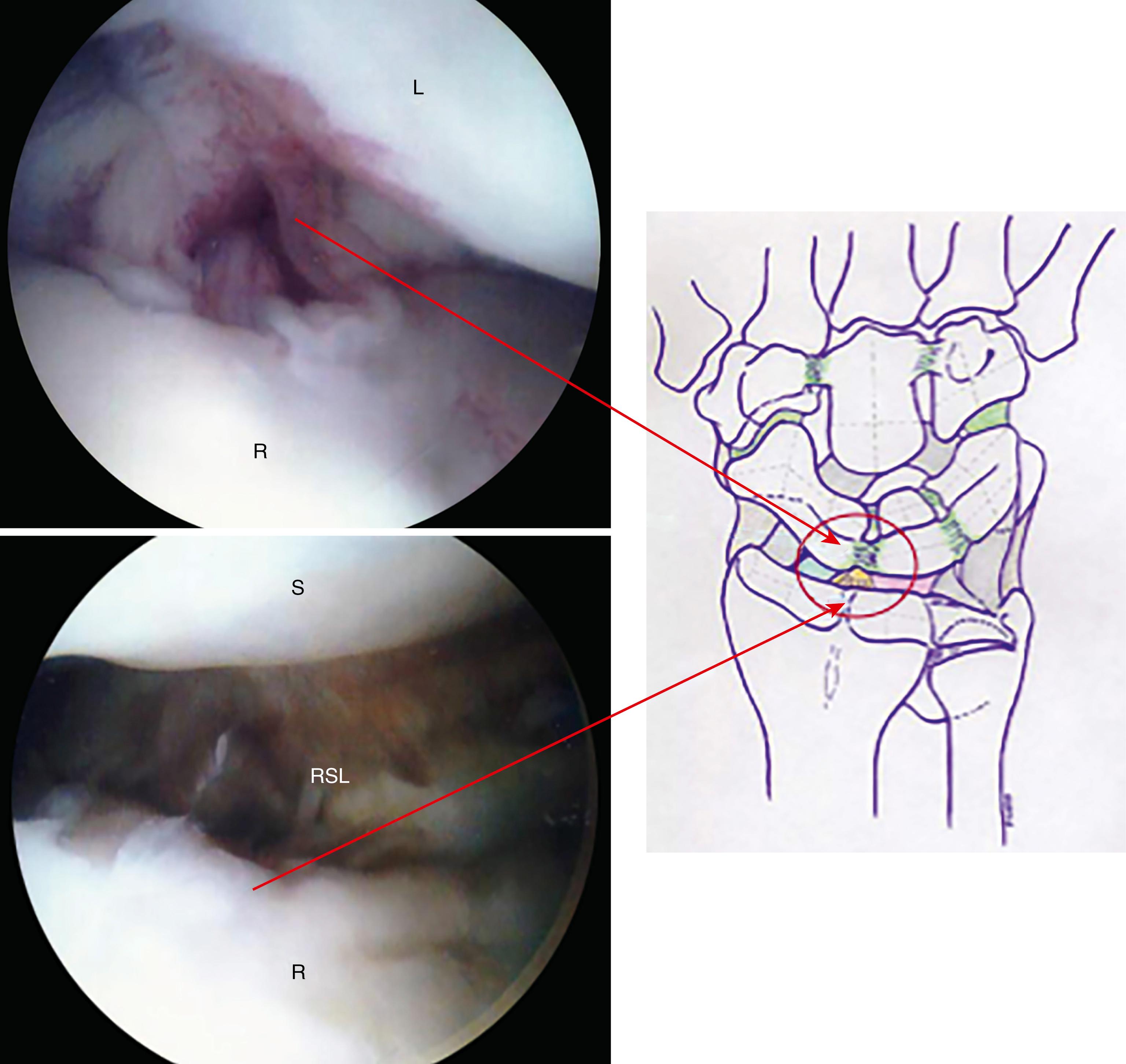
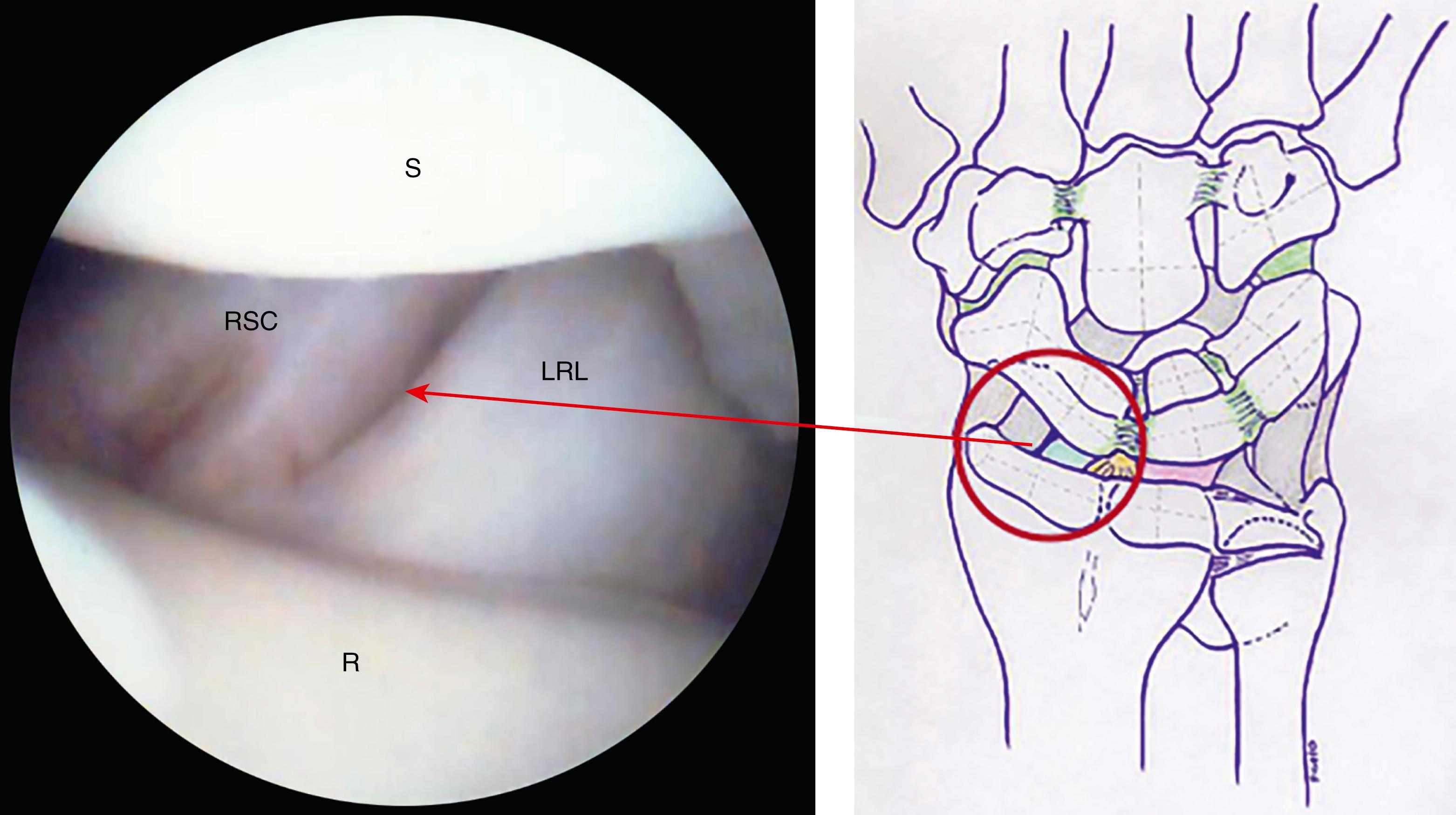
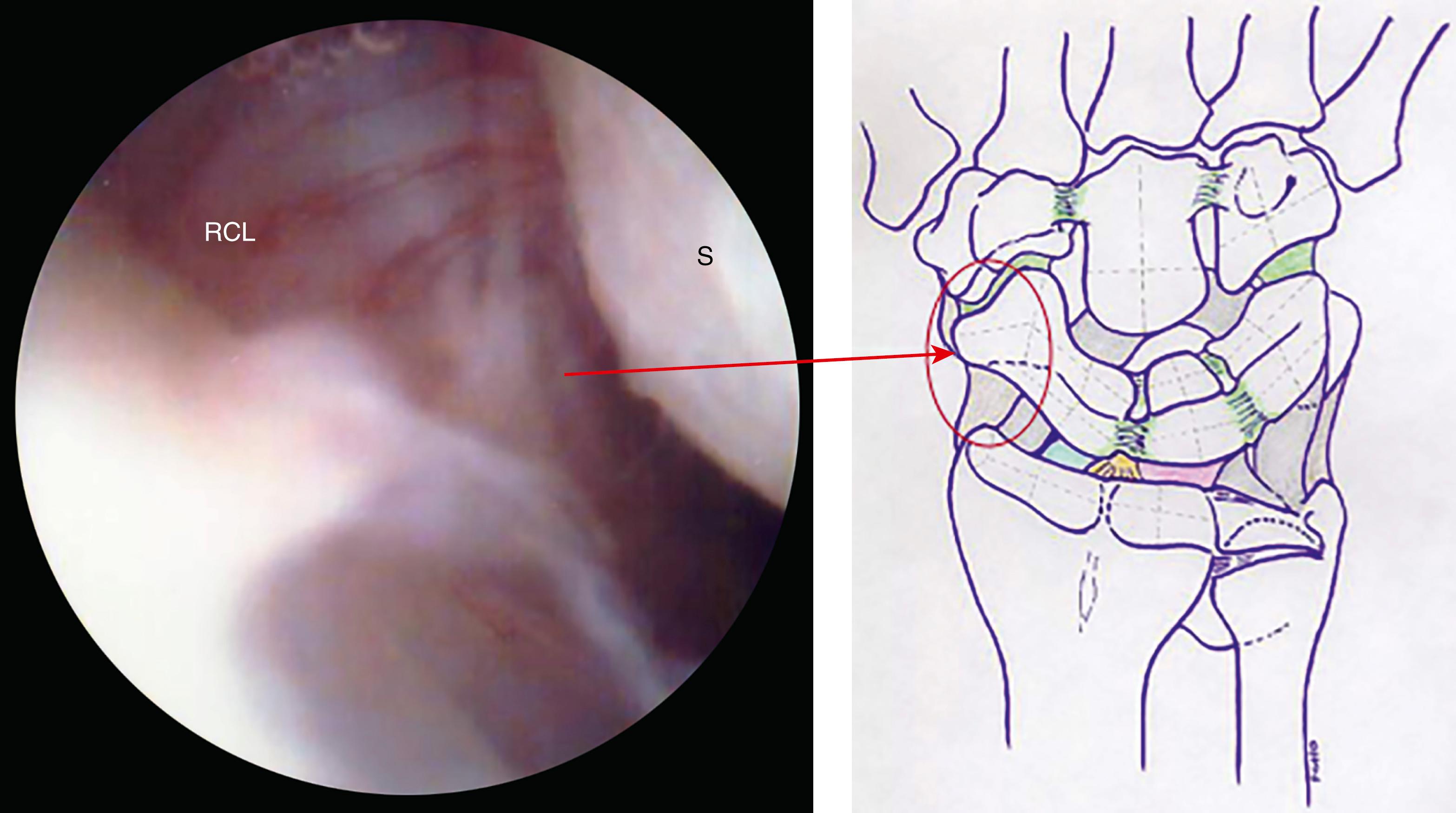
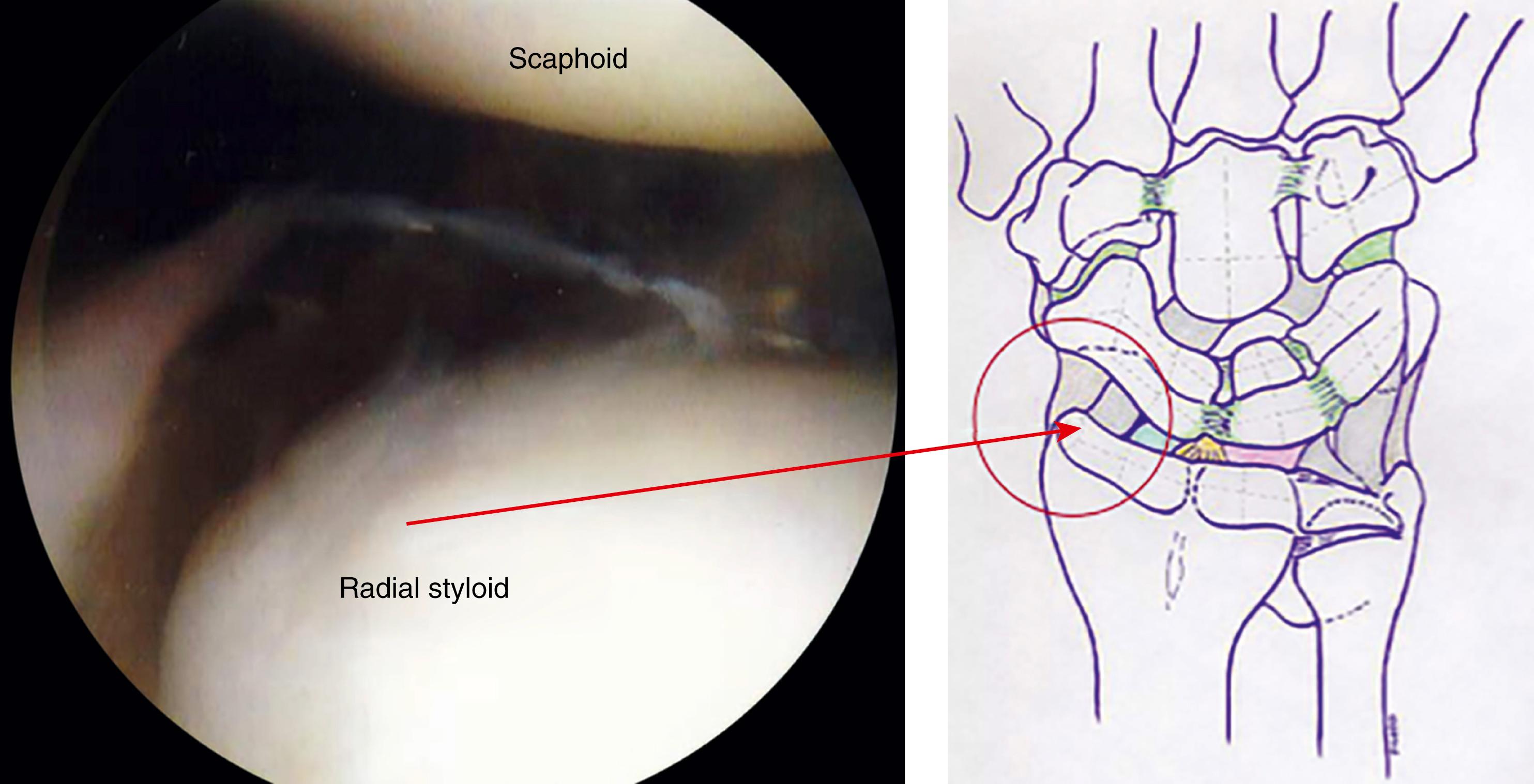
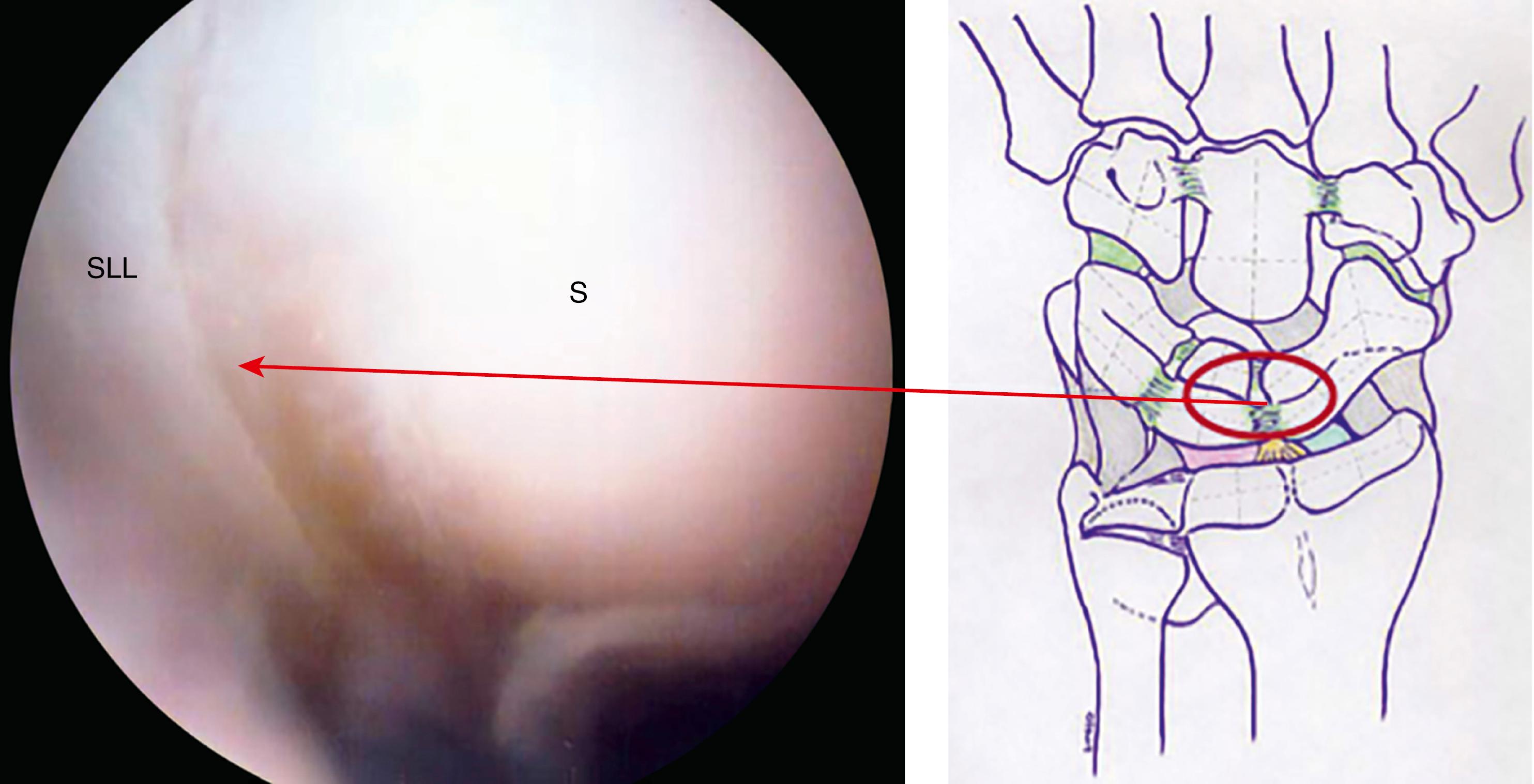
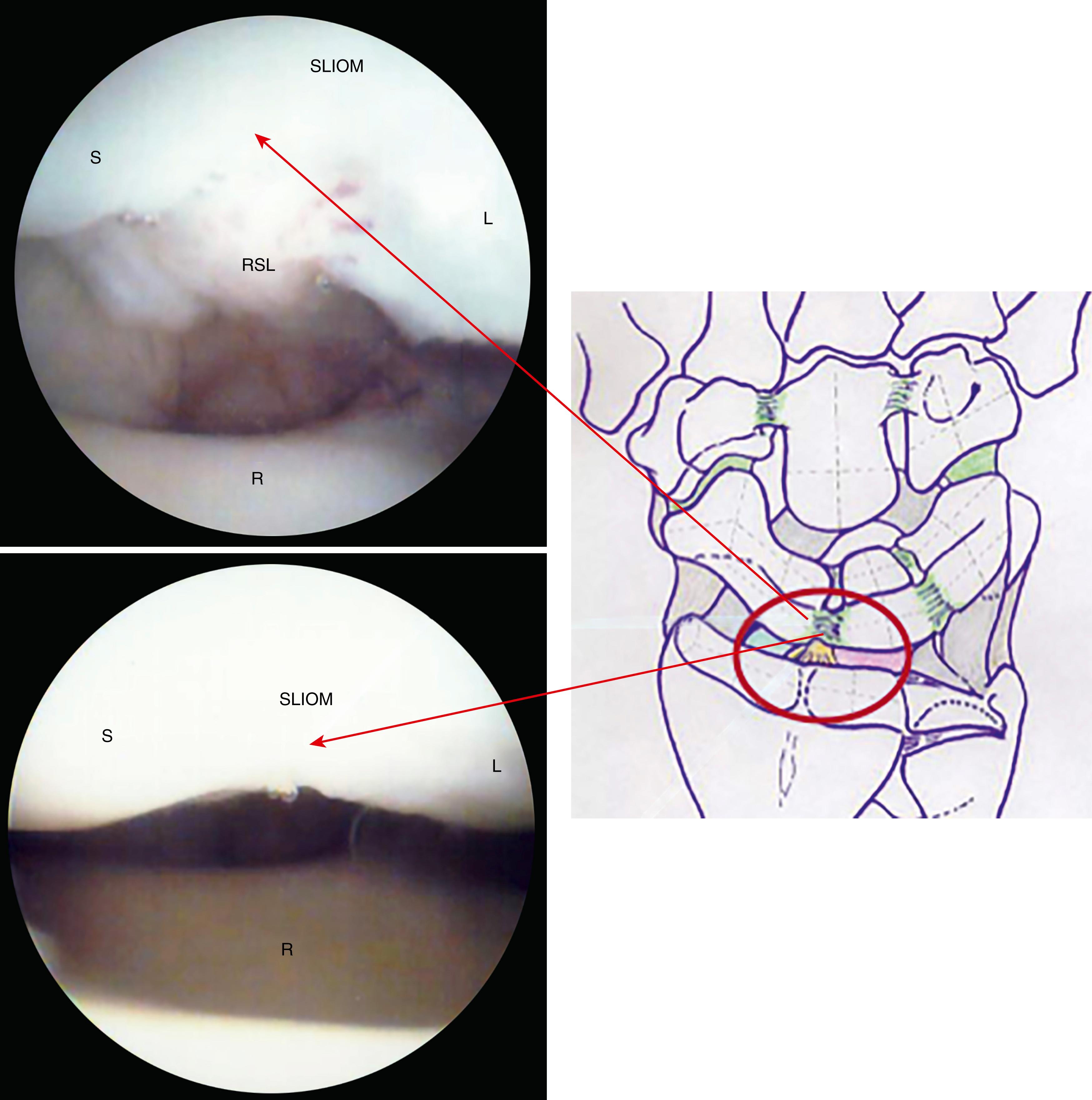
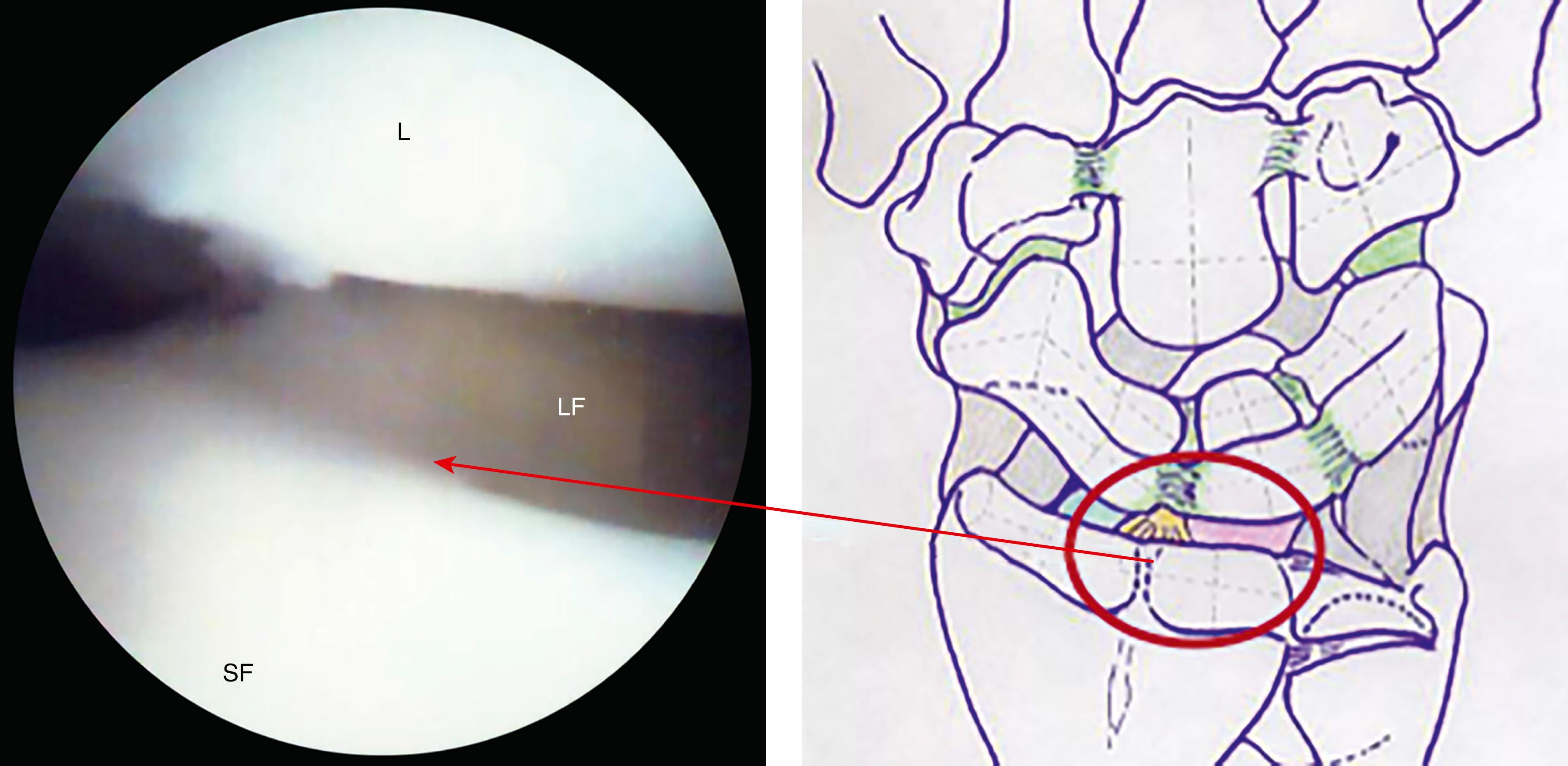
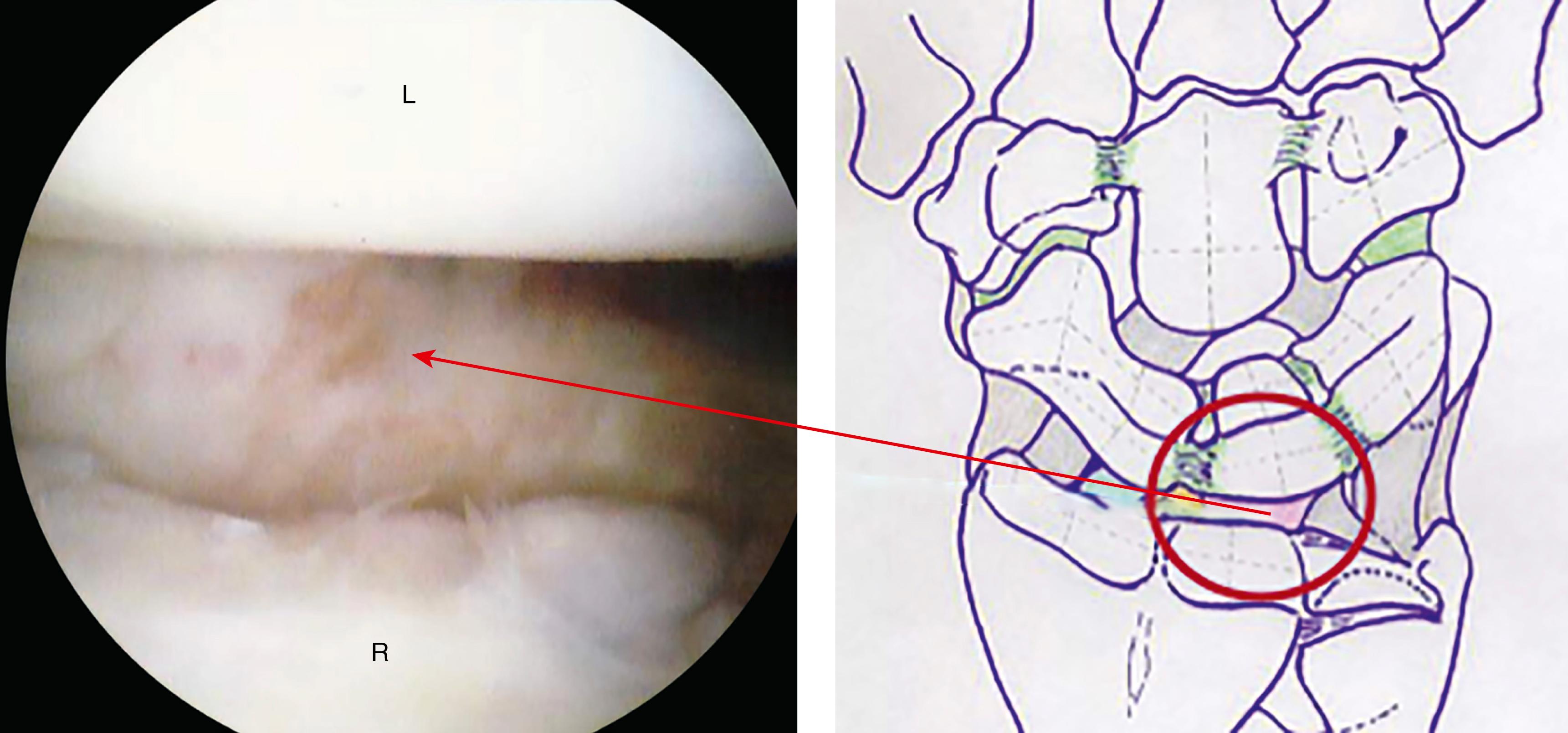
Further advancing the arthroscope in the ulnar direction, one can see the synovium covering the ulnocarpal ligament consisting of UL and UT ligament components ( eFig. 17.19 ), the radial insertion of TFCC over the sigmoid notch, and the central fibrocartilaginous disk, which amalgamates with the ulnar attachment of the dorsal and palmar radioulnar ligaments of the TFCC to the fovea of the ulnar head at the prestyloid recess. Any tear of the TFCC, articular wear, synovitis, or capsular injury should be thoroughly evaluated and documented. The prestyloid recess is located just dorsal to the ulnocarpal ligaments. This is a normal anatomic finding not to be confused with a peripheral tear of the TFCC. The 6U inflow cannula is normally placed in this recess. A probe hooking on the prestyloid recess will not lift up the tissue unless there is a proximal disruption of the TFCC, and hence a positive hook test as described by Ruch et al. ( ![]() ). The arthroscope is then swapped from the 3-4 portal to the 4-5 portal where a better view can be obtained of the proximal membranous and dorsal part of lunotriquetral (LT) ligament, as well as the dorsal cartilage of lunate and triquetrum ( eFig. 17.20 ). Hemorrhage and gap between lunate and triquetrum are signs suggestive of LT ligament injury. Cartilage wear over ulnar proximal lunate and a central degenerative tear of the articular disk should raise the suspicion of ulnar impaction syndrome.
). The arthroscope is then swapped from the 3-4 portal to the 4-5 portal where a better view can be obtained of the proximal membranous and dorsal part of lunotriquetral (LT) ligament, as well as the dorsal cartilage of lunate and triquetrum ( eFig. 17.20 ). Hemorrhage and gap between lunate and triquetrum are signs suggestive of LT ligament injury. Cartilage wear over ulnar proximal lunate and a central degenerative tear of the articular disk should raise the suspicion of ulnar impaction syndrome.
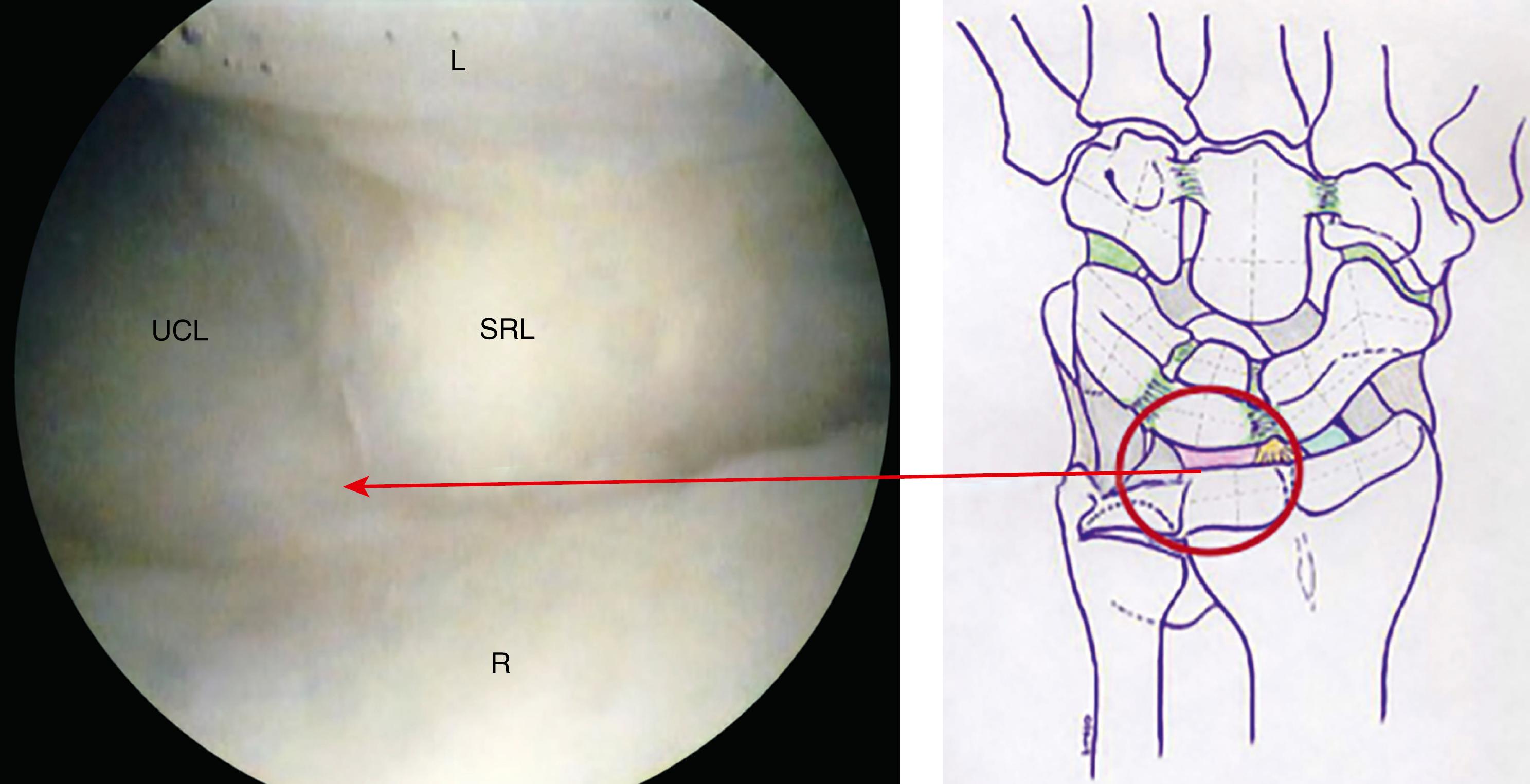
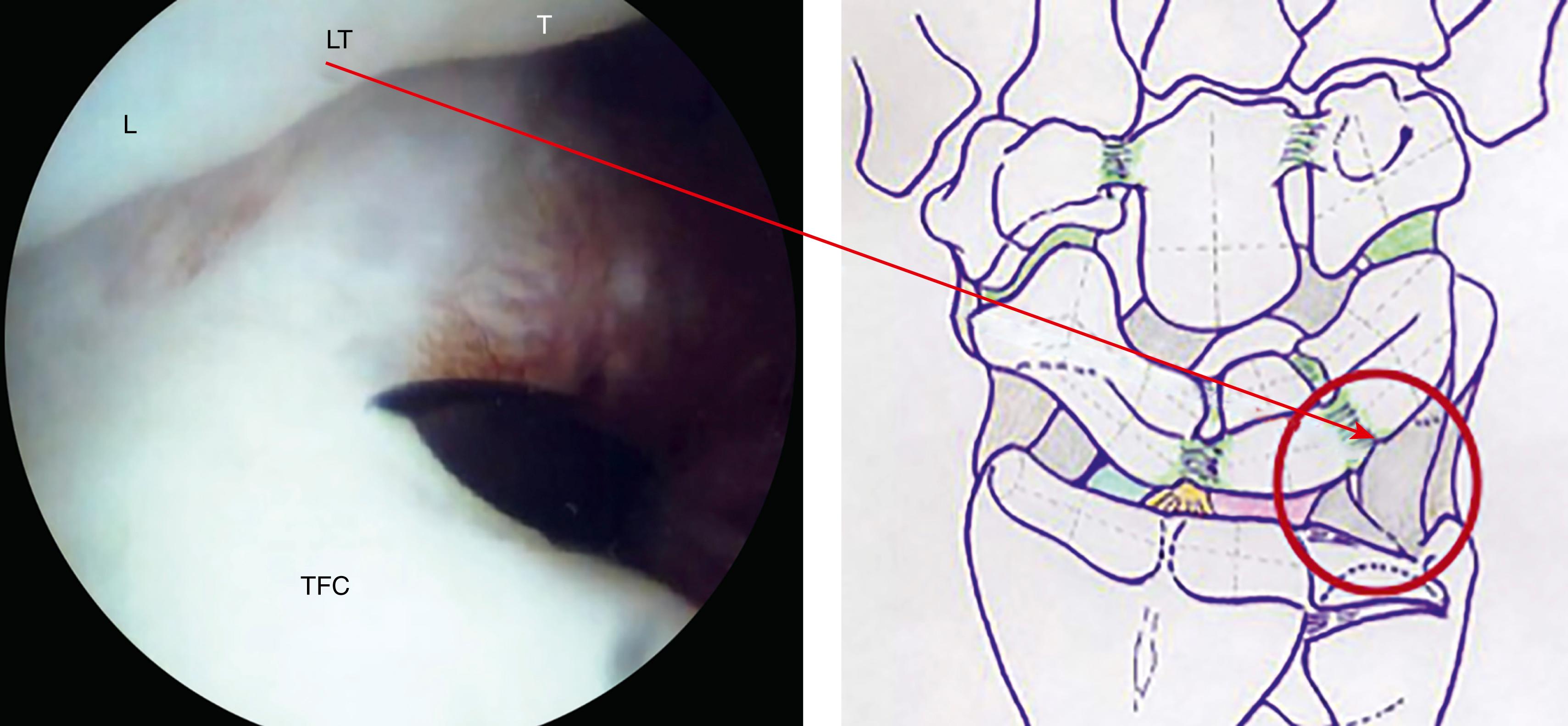
It is recommended that a working portal should not be established over the 4-5 or 6R site at the beginning of the procedure until the entire ulnocarpal joint area has been inspected through the 3-4 entry portal. This precaution helps to eliminate the dilemma of determining whether a dorsal capsular defect or synovial folding over the dorsoulnar corner commonly found at arthroscopy is a pathologic lesion or as a result of capsular intrusion by the arthroscopic trocar set. Occasionally it may be difficult for the arthroscope inserted at the 3-4 portal to negotiate through the narrowest portion of the radiocarpal joint at the convex proximal side of the lunate to reach the ulnocarpal area. A useful trick is to direct the scope dorsally where the capsular space is more roomy until the tip passes the lunate. The scope can then be glided gently into the ulnocarpal joint using the lunate as a “skid.” This can avoid the use of 4-5 or 6R portal at the very beginning which potentially violates the normal anatomy. However, the use of the 6R or 4-5 portal at the latter part of the procedure should be liberal as the LT ligament is usually not visible from the 3-4 portal. Moreover, probing through these portals is frequently required to assess the integrity of the extrinsic and interosseous ligaments, as well as the TFCC. The true extent of many apparently trivial intraarticular lesions can only be ascertained by careful probing. The author advises using the shoulder side rather than the tip of the probe to palpate intraarticular structures to avoid iatrogenic injury especially on the cartilage. In a typical case of a central TFCC tear, probing should be performed to assess the stability of the flap tear as well as the integrity of the radioulnar ligaments. Similarly, in many cases of a peripheral tear of the TFCC, the actual tear may be obscured by the overlying reactive synovial overgrowth, making diagnosis difficult to establish by simple visual examination alone. In these instances, the synovial overgrowth should be debrided first by using a shaver before probing the lesion. Finally, the loss of trampoline rebound feeling of the TFCC on probing is also an important sign of a destabilizing TFCC lesion at its peripheral insertion.
The pisotriquetral (PT) joint can often be assessed through the radiocarpal joint. From the 6R portal, the arthroscope can be swept distally and ulnarward past the lunate, the indentation of the LT joint and along the proximal surface of the triquetrum. As the arthroscope is being pushed further distally and volarward, the aperture of the PT joint can be located with or without a covering membrane ( ![]() ). Cadaveric study by Arya and Compson et al. demonstrated four types of connection between radiocarpal joint and PT joint: Type I (27%), a thick synovial membrane covered the joint and precluding visualization; Type II (17%), a thin synovial membrane over the silhouette of the pisiform bone; Type III (8%), a synovial membrane covering the joint with a small fenestration, and Type IV (48%), a synovial membrane with a large fenestration or absence of membrane. The presence of the PT orifice needs to be distinguished from a peripheral tear of the TFCC or LT ligament.
). Cadaveric study by Arya and Compson et al. demonstrated four types of connection between radiocarpal joint and PT joint: Type I (27%), a thick synovial membrane covered the joint and precluding visualization; Type II (17%), a thin synovial membrane over the silhouette of the pisiform bone; Type III (8%), a synovial membrane covering the joint with a small fenestration, and Type IV (48%), a synovial membrane with a large fenestration or absence of membrane. The presence of the PT orifice needs to be distinguished from a peripheral tear of the TFCC or LT ligament.
For midcarpal joint examination, the recommended initial portal is the MCR portal which is usually the easiest to establish. It is the single most useful portal in the midcarpal joint as almost the entire joint is accessible. Outflow is established at the MCU portal which can be easily converted into working or probing portal as necessary. In cases where radial side pathology is more significant, such as in scaphoid nonunion, SLAC wrist or advanced rheumatoid arthritis, the MCR portal may become excessively tight and MCU portal will then become the preferred entry portal. Under any circumstances, extreme caution and patience should be exercised in developing the midcarpal joint portals as traumatic scraping and iatrogenic injury to the articular cartilage can occur.
With the arthroscope in MCR portal, the anatomic structures should be evaluated systematically. The first structures seen would be the confluence point between capitate, scaphoid, and lunate. On the volar aspect, the scaphocapitate portion of the RSC ligament can be seen ( eFig. 17.21 ). In conjunction with the ulnocapitate ligament on the ulnar side, the arcuate ligament is formed. Normally these ligaments are covered with synovial lining. The lining is particularly thickened on the ulnar side, forming a well-defined soft tissue projection at the volar junction of lunate and triquetrum, which sometimes can be confused with an osteochondral fracture. The Space of Poirier can be appreciated between the capitate and lunate interval where no ligament connection is found normally. From this point when the arthroscope is moved toward the radial side, the scaphocapitate joint and the STT joint are entered ( eFig. 17.22 ). Moving back, the SL joint can be seen, and the central, volar and dorsal aspects of the joint should be systematically assessed by rotating the lens ( eFig. 17.23 ). Further to the ulnar side, the “four corner” joint space between the lunate, triquetrum, capitate, and the hamate can be appreciated. The roundish appearance of the capitate and hamate when looking from the radial side gives rise to its description as a “baby’s buttock” ( eFig. 17.24 ). The integrity and stability of the SL and LT joint should then be assessed. In a normal wrist, there should be no or minimal gap between scaphoid and lunate or between the lunate and triquetrum articulations. Geissler developed a grading system to evaluate the stability of the wrist’s interosseous ligaments. (See section titled Carpal Instability.) The mere presence of gap in the SL or LT articulation does not necessarily imply pathology as the phenomenon is common in patients with generalized joint laxity. The arthroscopic findings have to be carefully matched with the clinical assessment. Another observation is that a “step-off” can often be seen over the LT articulation if the arthroscope is introduced from the MCR portal. This misinterpretation is due to the presence of a small, type II facet over the ulnar side of the lunate that articulates with the proximal pole of the hamate ( eFig. 17.25 ). Presence of a type II lunate can be clarified if the arthroscope is introduced through the MCU portal to directly visualize the LT joint space. Moving further ulnarward, the “helicoidal” appearance of the TH joint can be appreciated ( eFig. 17.26 ). Following the dorsal curvature of the hamate, the carpometacarpal joints can be visited, where synovitis in commonly seen in inflammatory arthritis ( eFig. 17.27 ). The STT portal is seldom required in routine diagnostic arthroscopy unless STT joint pathology is suspected or found.
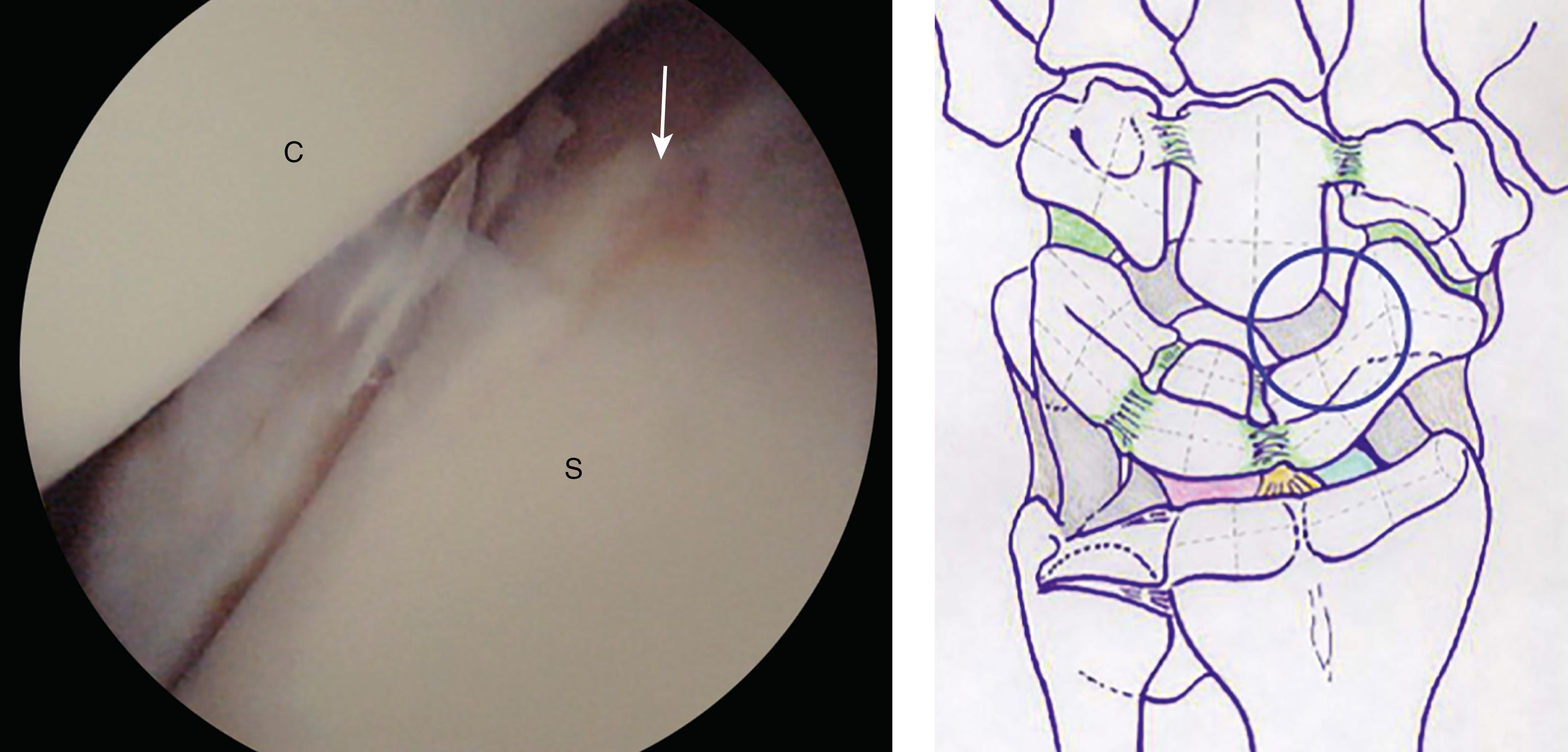
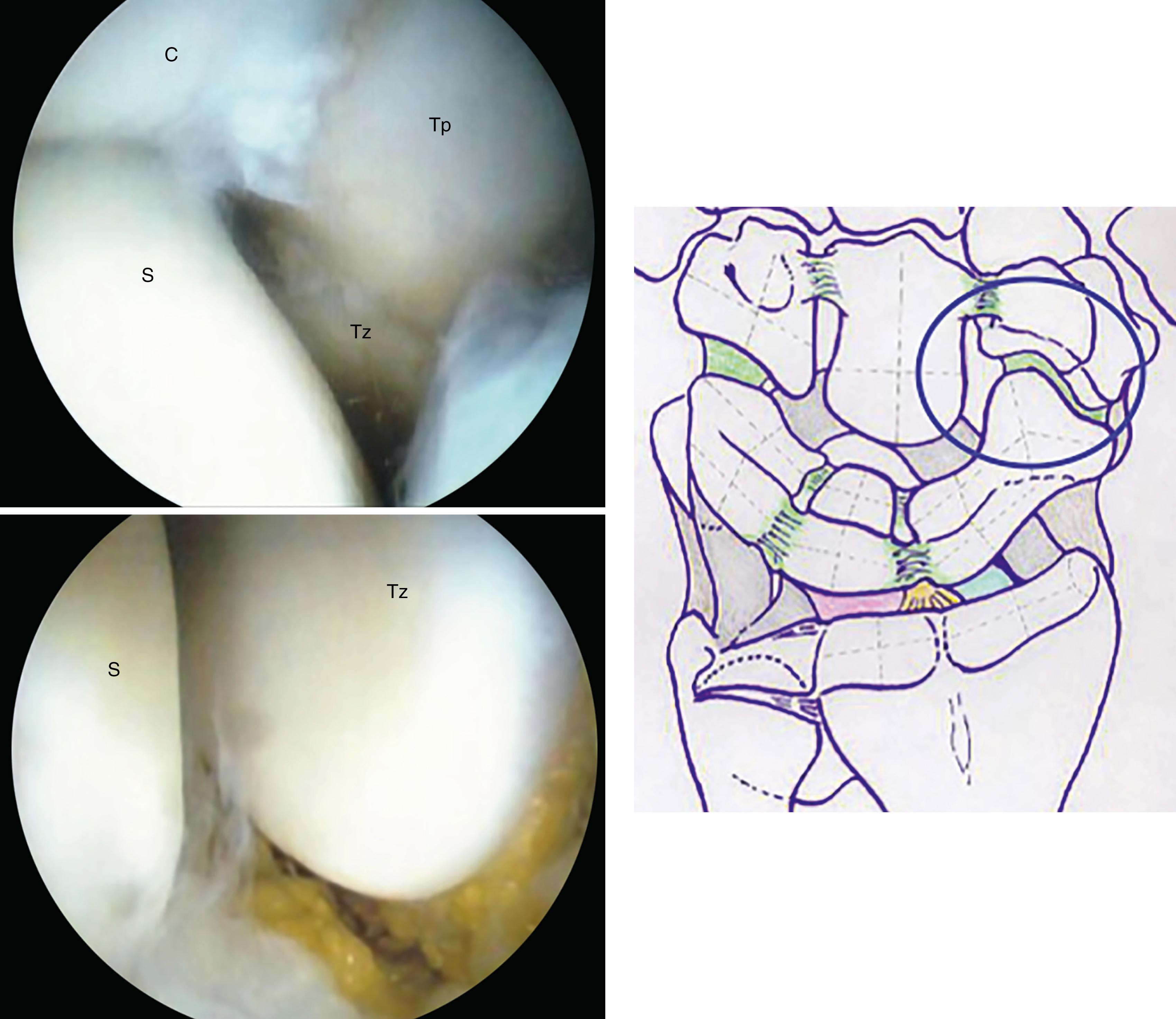
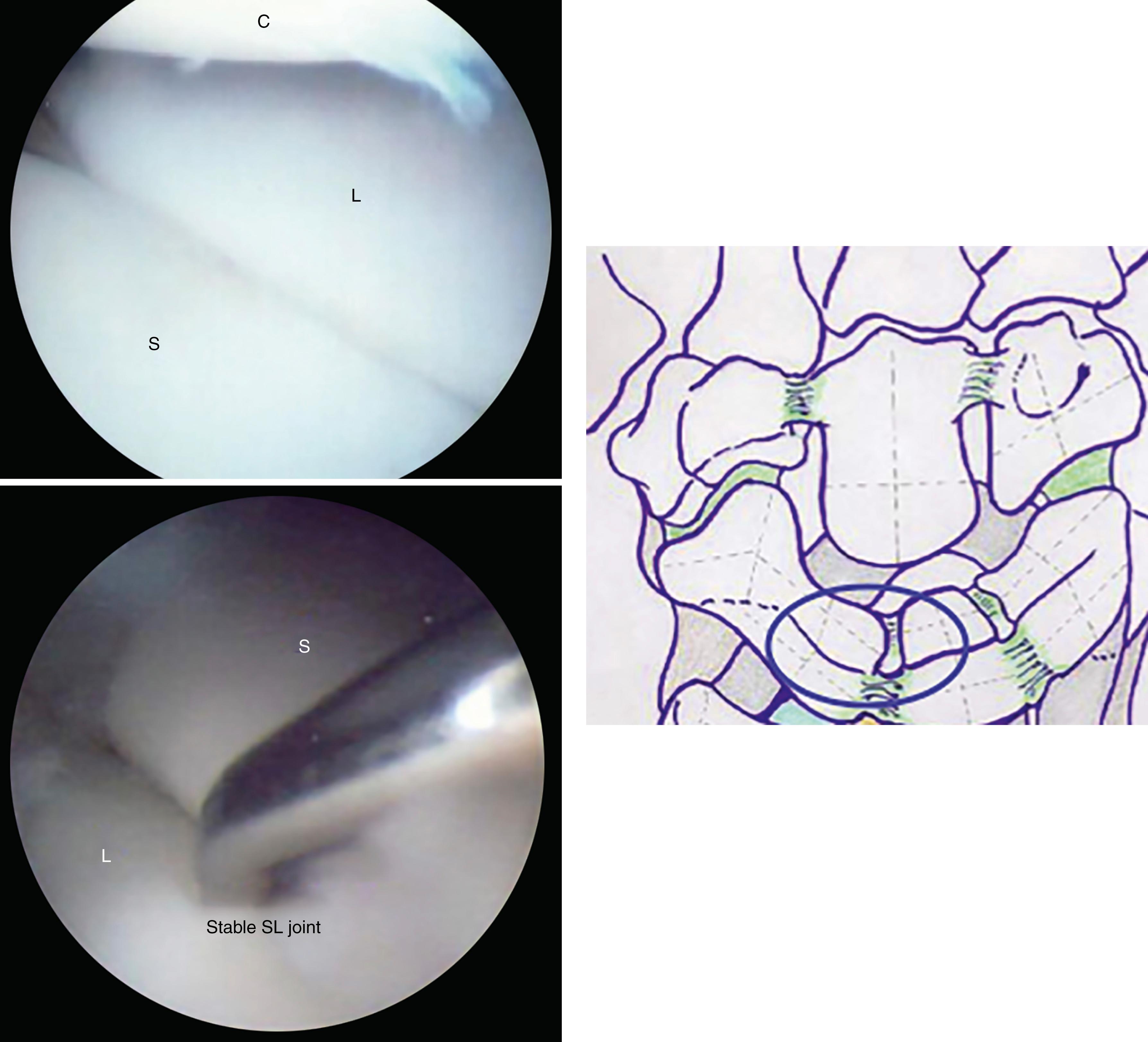
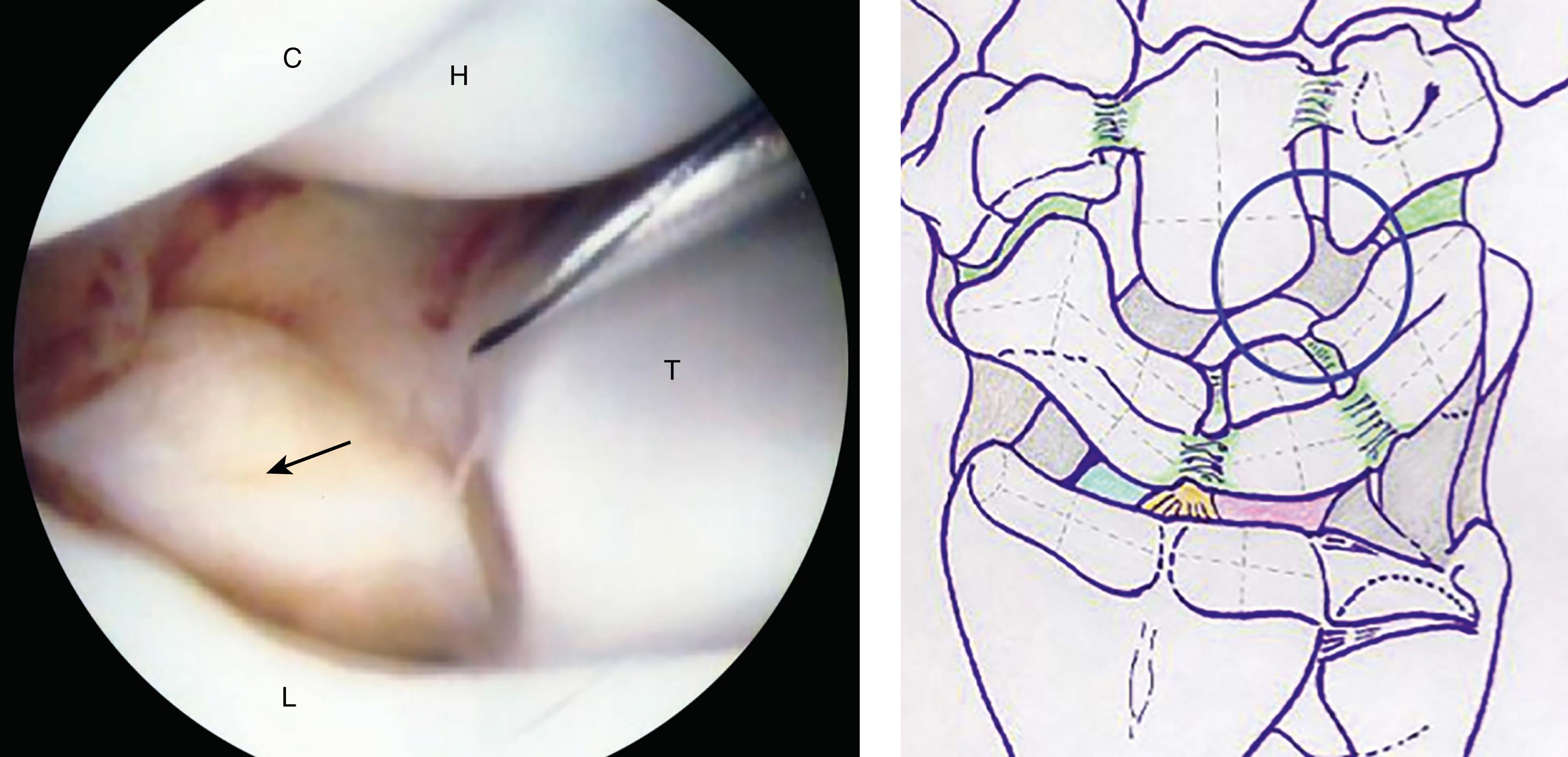
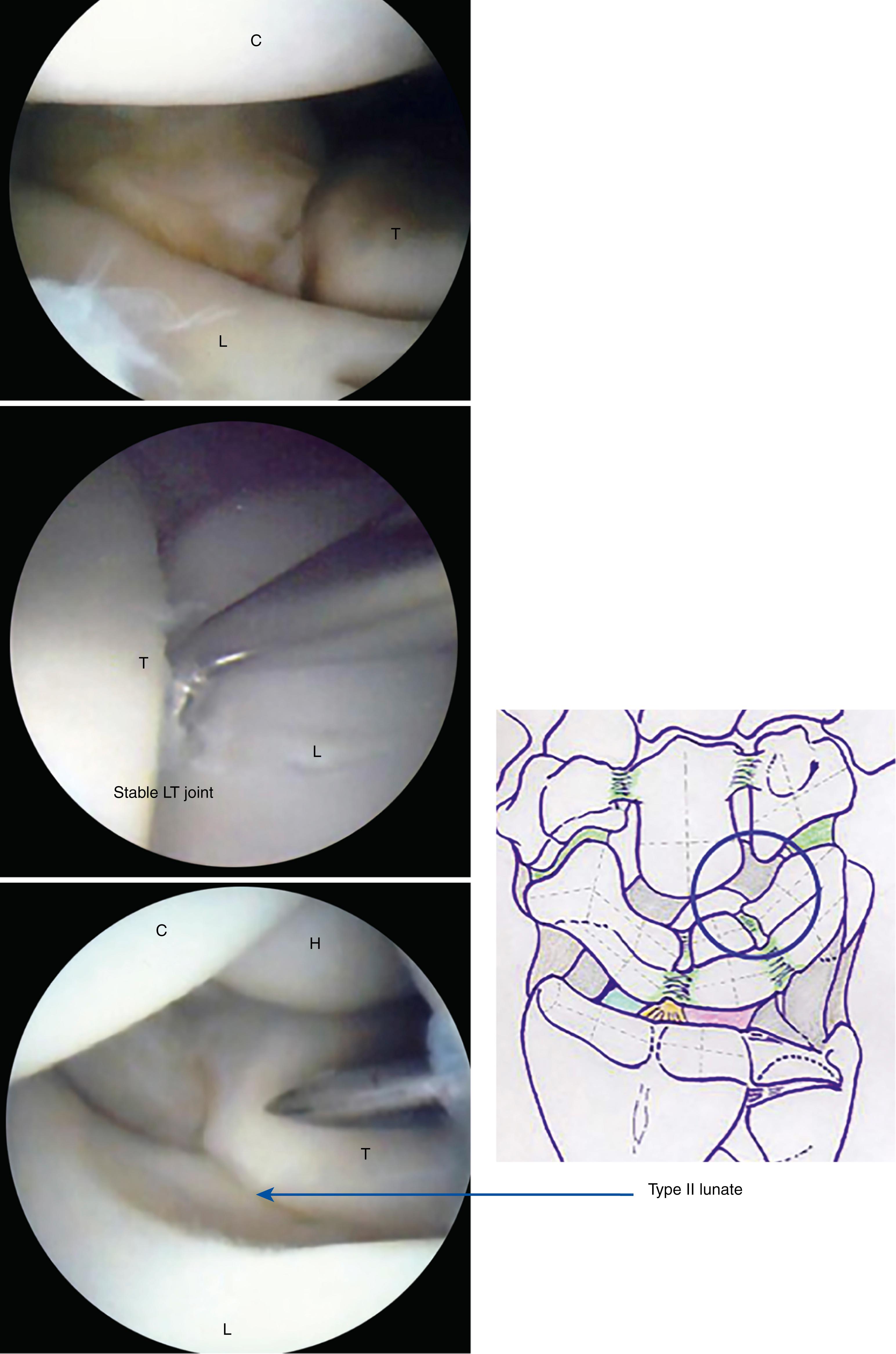
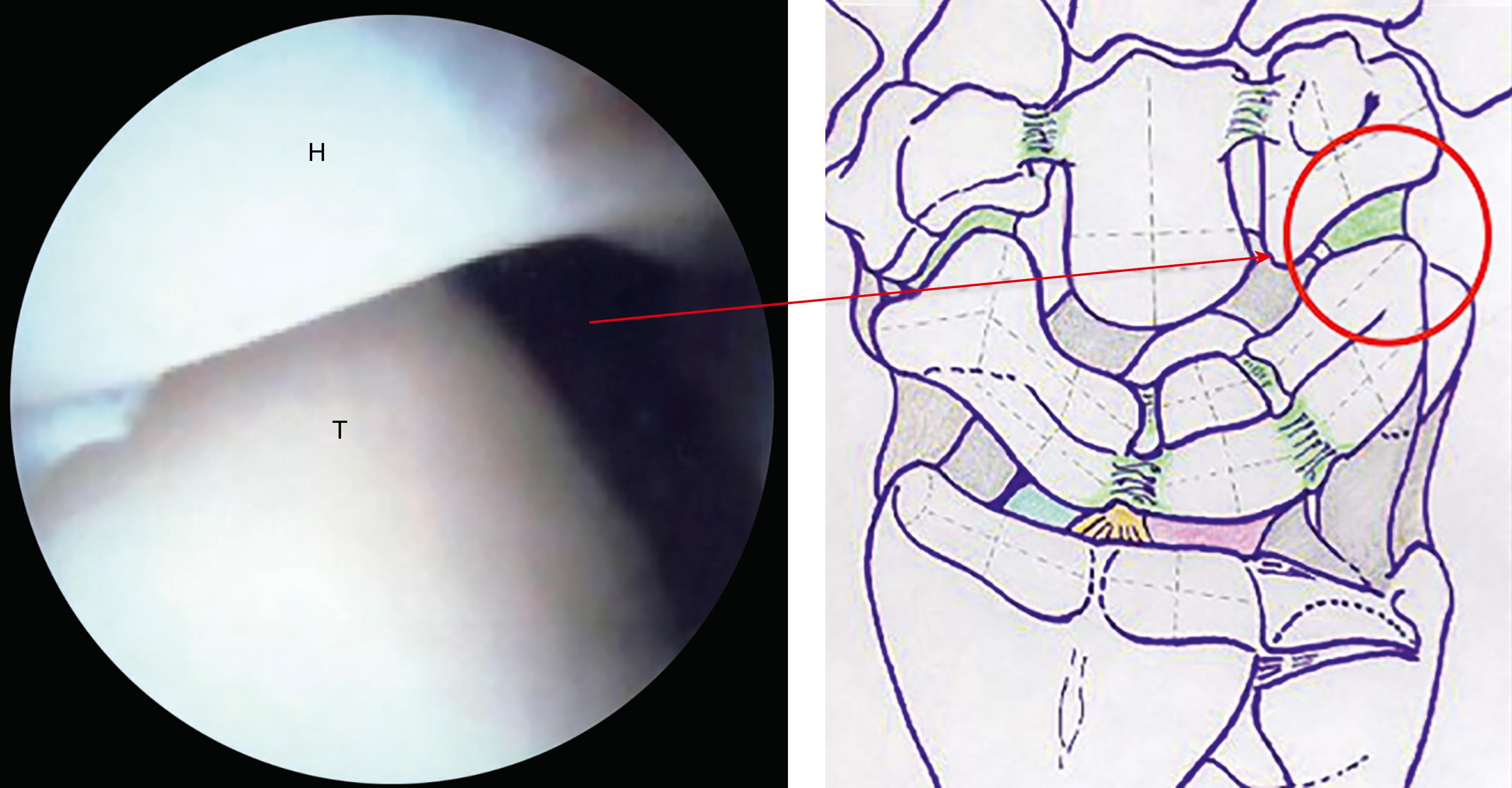
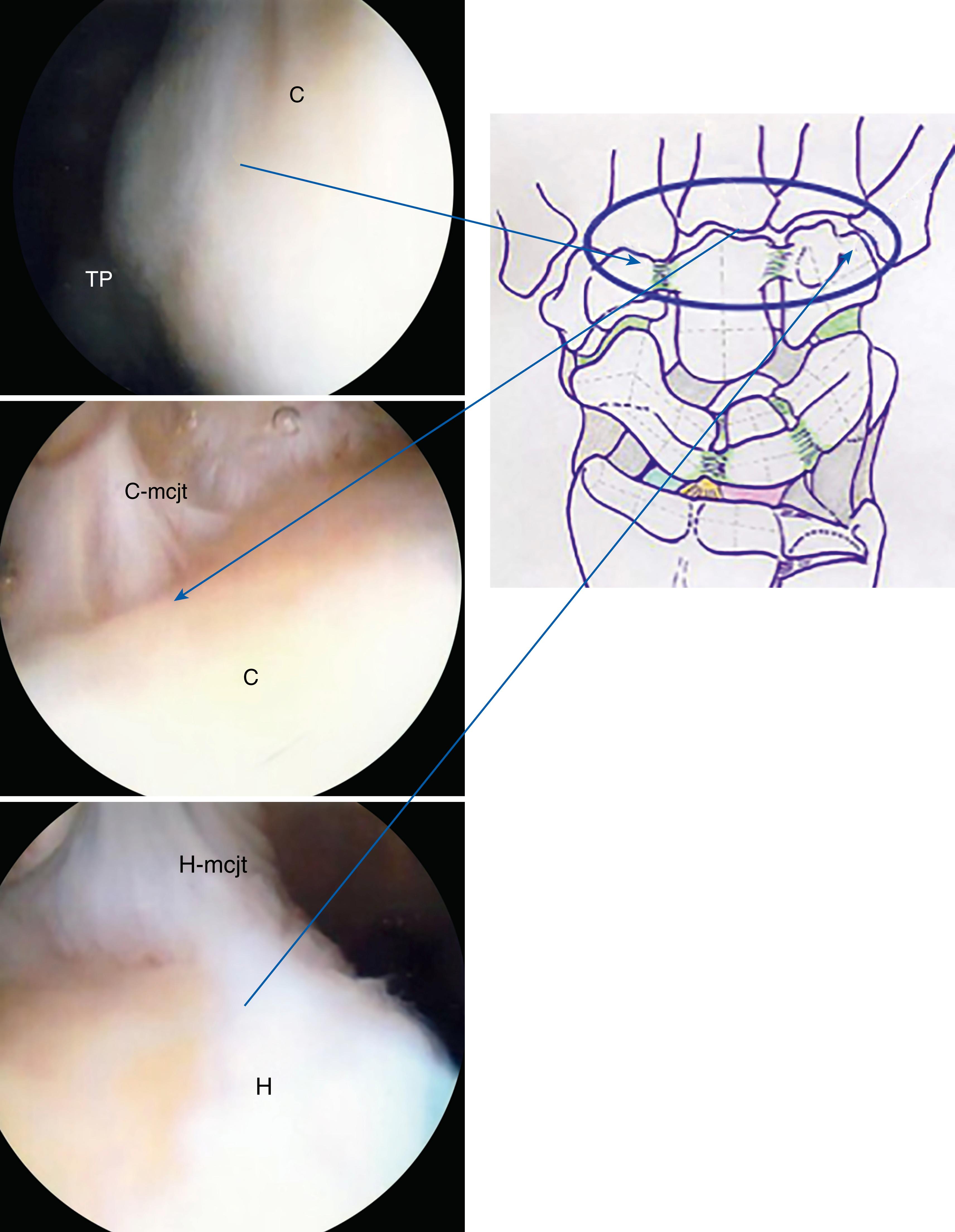
DRUJ examination is indicated only when joint pathology is suspected, as the risk of iatrogenic injury is much higher than in the rest of wrist joint due to its natural joint tightness. Longitudinal traction is ineffective in distending the joint space. Instead it may create more difficulty as the joint compression load would be increased upon axial traction. It is easier to approach the joint with the forearm in supinated position, as then it will relax the dorsal capsule, translate the ulnar head more anteriorly, and lift the central disk distally from the ulnar head. In addition, arthroscope of size larger than 2.0 mm should not be used to minimize potential morbidity. In DRUJ arthroscopy, it is possible to observe the cartilage condition of the sigmoid notch, the ulnar head, the proximal synovial recess of the DRUJ capsule, the undersurface of the TFCC, and the foveal insertion of the radioulnar ligament ( eFig. 17.28 ).
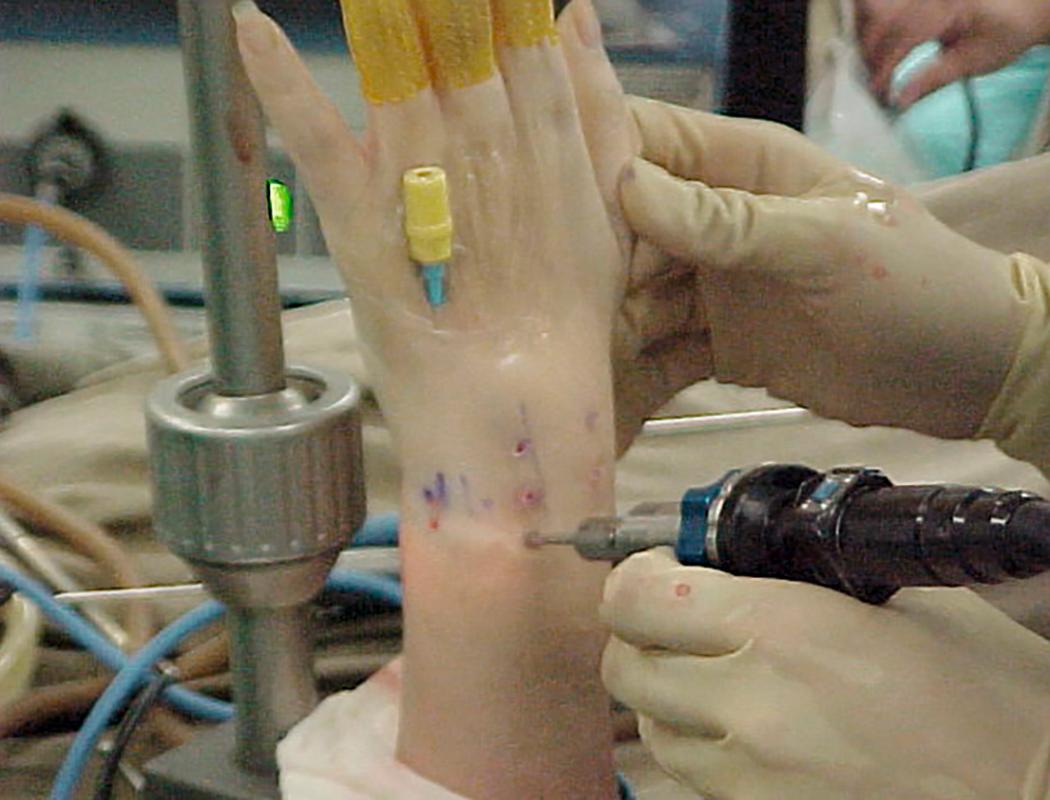
After most arthroscopic procedures, sutures are usually not required for the wounds. Instead, Steri-Strip opposition is sufficient for wound healing, which typically takes 8 to 10 days. The author routinely places a thin layer of water-resistant dressing on top in order to encourage the use of the hand in daily activities such as bathing and hand-washing in the early postoperative period. Compression bandage is applied for 2 to 3 days. Finger mobilization exercises are encouraged from day one. For simple diagnostic arthroscopy, wrist immobilization is not generally necessary. In experienced hands, a complete diagnostic arthroscopic examination of the radiocarpal and midcarpal joints can be accomplished within 20 minutes or less.
Chronic wrist pain of uncertain etiology
Failed conservative treatment for over 3 months
Assessment of ligament and chondral lesions in acute wrist fractures
Assessment of Kienböck disease and posttraumatic arthritis
Perform repeated clinical examinations for chronic wrist pain.
Patients without positive provocative sign on examination seldom yield positive findings at wrist arthroscopy.
Arthroscopic findings need to correlate with clinical examination.
For chronic ulnar wrist pain, never create portal on ulnar wrist before the ulnocarpal joint is inspected from 3-4 portal.
Adequate traction with controllable traction force is key to joint access.
Use plastic finger traps rather than metal ones and use three finger traps for arthroscopy under local anesthesia.
Gravity-driven saline irrigation of the joint is adequate and mechanical pumping is not necessary.
Transverse portal incisions heal better than longitudinal incisions.
When developing portals in the radiocarpal joint, point the trocar away from the center of the wrist. The reverse applies when developing portals in midcarpal joint (i.e., toward the center) to get more clearance.
A 1.9-mm arthroscope can be used as the universal arthroscope for all joints of wrist and hand under all circumstances by experienced arthroscopists. It is more fragile and requires extra care to prevent damage.
When performing arthroscopy under local anesthesia, observe the patient’s thumb and little finger (without the finger traps) to monitor for patient anxiety or failure to relax forearm muscles
Adjust the height of saline bag suspension for hemostatic control when performing arthroscopy without a tourniquet.
Surgeon operating in standing position rather than sitting helps to relax the shoulder and avoid fatigue.
Stabilize the patient’s skin with your thumb and index finger before cutting the skin. Never make a stab wound incision!
Wound spreading technique for portal creation using fine-curved hemostat forceps.
Proper coupling of the arthroscope with the sheath avoids accidental breakage of the lens.
Use finger pivoting technique to control the fine movement of the arthroscope within the joint ( Fig. 17.4 ).
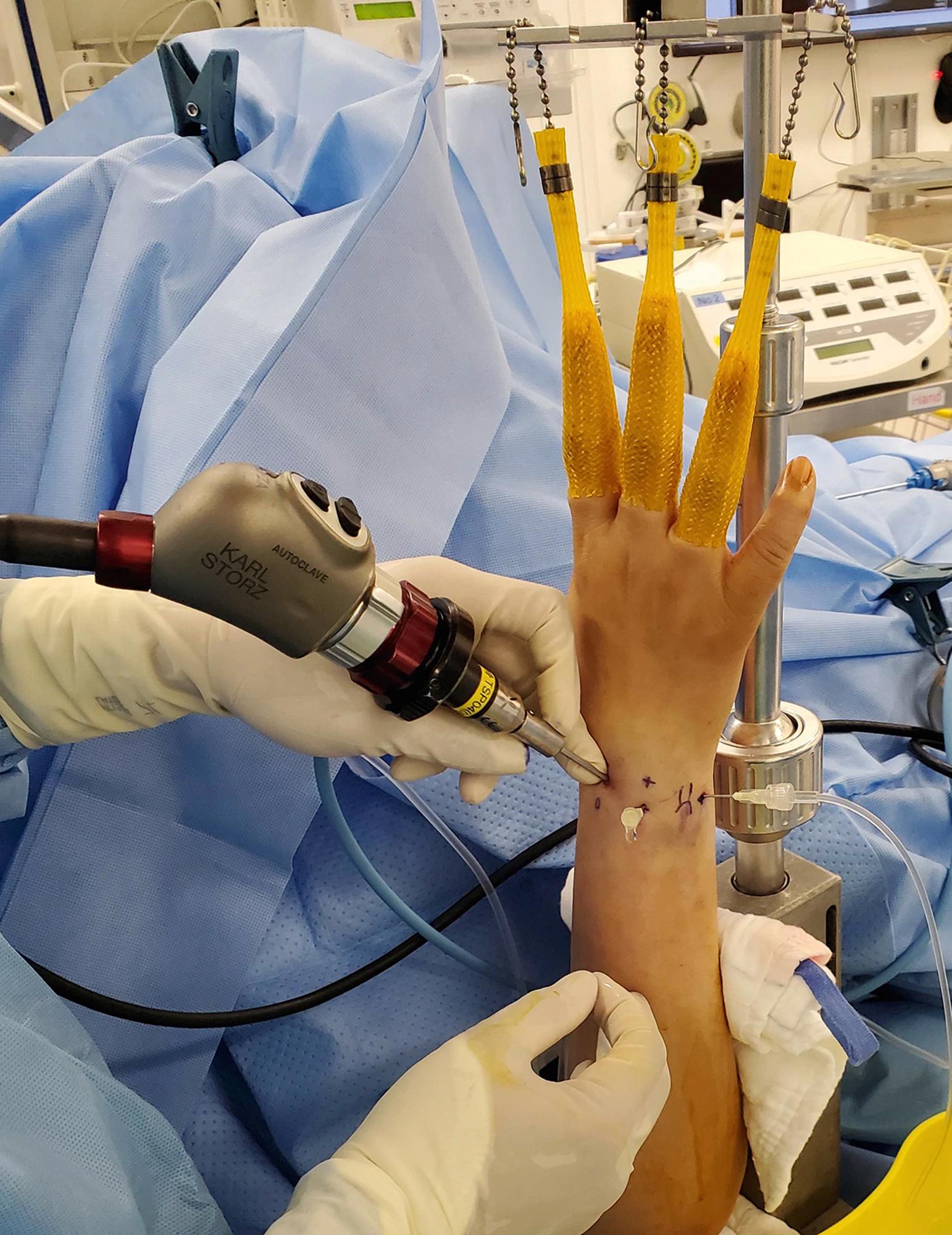
When moving the arthroscope inside the joint, use screwing action rather than straight in-and-out action to avoid unnecessary extraction of the scope.
Use the blunt shoulder side rather than the tip end of the hooked probe to palpate intraarticular structures.
For triangulation, the angle subtended by the arthroscope and the probe or the instrument should be within 60 degrees.
When using a suction device, block the outflow channel to reduce intraarticular air bubbles.
When using a radiofrequency probe, insertion of the probe through an arthroscopic sheath allows bubble release and venting of the heated saline.
A direct stab wound with a scalpel can damage cutaneous nerves and extensor tendons during portal creation.
Excessive traction produces joint pain.
A mechanical pump may cause fluid extravasation and compartment syndrome, especially in a fracture situation.
Use of excessive force, especially during portal creation, may create cartilage damage in the midcarpal joint and DRUJ.
No stitch is required for wound closure.
Swelling induced by saline irrigation subsides well with limb elevation and bandaging for 1 to 2 days.
Early finger mobilization avoids tendon adhesion.
The tremendous development of therapeutic arthroscopy in the past three decades has altered the management algorithm of a lot of clinical conditions of the wrist. With the maturation of technique and instrumentation, more complex and precise new procedures can be performed with low complications. Therapeutic procedures are no longer restricted to resection or ablation. More specific anatomic reparative procedures and, more recently, functional reconstructive procedures involving reconstruction or augmentation of vital structures with graft material are demonstrated with proven clinical value.
The function of lavage mainly works through the elimination of inflammatory mediators, joint debris, and other synovial contaminants as a result of the wash-out process. Indications include pyogenic septic arthritis, gouty arthritis, and degenerative arthritis ( ![]() ). Gravity-assisted fluid irrigation is usually sufficient for most situations. Typically, the 3-4 portal is used to visualize the radiocarpal joint. Joint lavage is delivered via the arthroscope. The 4-5 or 6R portal is used to insert a shaver to manage loculations and synovitis, as well as for joint fluid suction (
). Gravity-assisted fluid irrigation is usually sufficient for most situations. Typically, the 3-4 portal is used to visualize the radiocarpal joint. Joint lavage is delivered via the arthroscope. The 4-5 or 6R portal is used to insert a shaver to manage loculations and synovitis, as well as for joint fluid suction ( ![]() ). An additional midcarpal and/or distal radioulnar portal can be placed as needed. Chow et al. reported the result of arthroscopic debridement of 15 septic wrists in 14 patients. All except 2 patients (85.7%) responded well to single arthroscopic treatment with no complication. Symptom duration of ≥5 days was associated with less improvement on quick-Disabilities of the Arm, Shoulder and Hand (DASH) at final follow-up. Similar results were obtained by Hariri et al. on 9 patients. Both advocated early arthroscopic intervention for better infection control and preservation of wrist function. Sammer and Shin compared the outcomes of arthroscopic and open treatment in isolated septic wrist and concluded that arthroscopic treatment resulted in less intervention and a shorter hospital stay.
). An additional midcarpal and/or distal radioulnar portal can be placed as needed. Chow et al. reported the result of arthroscopic debridement of 15 septic wrists in 14 patients. All except 2 patients (85.7%) responded well to single arthroscopic treatment with no complication. Symptom duration of ≥5 days was associated with less improvement on quick-Disabilities of the Arm, Shoulder and Hand (DASH) at final follow-up. Similar results were obtained by Hariri et al. on 9 patients. Both advocated early arthroscopic intervention for better infection control and preservation of wrist function. Sammer and Shin compared the outcomes of arthroscopic and open treatment in isolated septic wrist and concluded that arthroscopic treatment resulted in less intervention and a shorter hospital stay.
The technique is employed in conditions where debris in the joint from various tissue origins contributes to symptoms directly or indirectly. Examples include degenerative arthritis, central TFCC tear, Kienböck disease, and partial interosseous ligament tear. Debridement of partial interosseous ligament tear has been shown to provide symptomatic relief in cases without carpal dissociation. Various instruments such as suction punch, motorized shaver, arthroscopic knife, and radiofrequency apparatus can be used in a partial excision of a central TFCC tear. Symptomatic improvement can be expected if ulnar variance of the wrist is neutral or minus. , For ulnar positive patients, an additional arthroscopic wafer procedure or open ulnar shortening (USO) may provide more durable relief. A systematic review by Saito and Chung on 550 patients in 18 studies reported nonstatistical improvements in grip strength, DASH score, and pain visual analog scale (VAS) score after debridement of TFCC tears. Average time to return to work was 4 month. At average 30-month follow-up, further surgery was required in 31% of patients with positive ulnar variance compared with only 1% in patients with neutral or negative ulnar variance, suggesting caution in performance of this procedure in patients with positive variance. Soreide and Haugstvedt reported the good long-term outcome of average 19 years of arthroscopic-assisted debridement of TFCC tears in 15 patients. Nishizuka and colleagues treated 66 patients with ulnar-sided wrist pain with either USO, TFCC repair, or arthroscopic debridement. While both the USO and TFCC repair groups had statistical improvements in Hand20 scores and pain, there was no improvement in any measured parameter in the arthroscopic debridement group (n = 14), even when ulnar-positive and TFCC detachment patients were excluded from the analysis.
As we exclusively perform TFCC debridement under PSLA with the patient wide awake, we consider this a valuable intervention with minimal anesthetic and surgical risks; as such it may present a reasonable risk-benefit ratio to the patient as a first line of treatment, even in cases with ulnar-positive variance. Standard radiocarpal joint arthroscopy is performed through the 3-4 portal to confirm the diagnosis. The TFCC tear is approached through the 4-5 or 6R portals. An arthroscopic banana knife can be introduced to complete the flap tear. A grasper can then be used to retrieve the TFCC fragment out from within the joint. Any remnant of the tear can be smoothed with a suction punch or shaver ( Fig. 17.5 ). The remaining portion of the TFCC, particularly the dorsal and volar radioulnar ligaments that constitute the peripheral 2 to 3 mm, should be preserved. Because of the limited joint space, most of the commercially available arthroscopic knives cannot be placed into the joint through a protective sheath. Extreme caution and gentleness has to be taken during the introduction of the knife into the joint to avoid iatrogenic injury to the overlying extensor tendons. Occasionally, a mosquito grasper can be inserted into the joint from the 4-5 portal to grasp onto the flap tear to facilitate the cutting action of the knife.
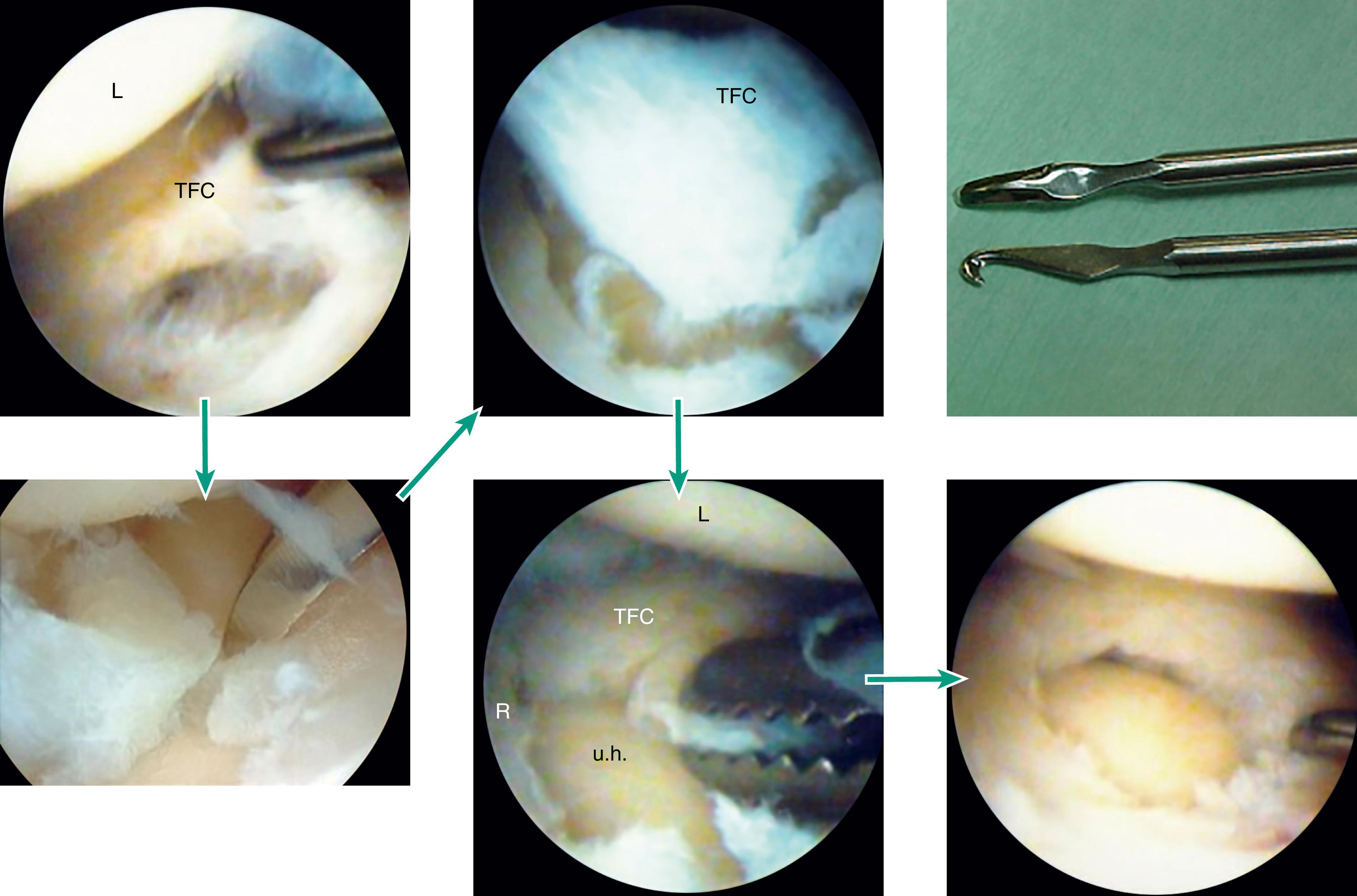
The emergence of small radiofrequency (RF) probe such as unipolar (VAPR; Mitek, Westwood, MA, USA) or bipolar (VULCAN, Smith & Nephew Endoscopy, Menlo Park, CA) RF apparatus have been proven to be ideal in a controlled debridement of central type of symptomatic traumatic or degenerative perforation of TFCC. RF is based on the principal of applying alternating electric current to the tissue, which generates thermal energy at the probe and tissue interface. Thermal energy causes denaturation of proteins, which results in alteration of the physical property of the tissues. Changes in physical property depend on the time duration and temperature generated at the tissue and probe interface. With appropriate energy setting, the RF probe of 2.0 to 2.3 mm diameter can vaporize the flail portion of tear substance with high degree of precision, neatness, and ease ( Fig. 17.6 ). The probe also has coagulation function for hemostasis purpose. The major drawback is the inevitable production of a variable amount of air bubbles during the debridement process that can significantly obscure the visual field within the tight space of the wrist joint. Evacuation of the bubbles can be effectively managed with the aid of a wide-bore needle and appropriate manual suction using a syringe. Alternatively, the RF probe can be introduced through an arthroscopic cannula that serves as a venting mechanism ( eFig. 17.29 ; ![]() ). The amount of air bubbles generated varies with different models and energy settings of the RF apparatus. Another risk is iatrogenic thermal damage to adjacent normal cartilage, ligament structures, and extraarticular tendons close to the joint capsule. It is well documented that chondrocyte death is associated with temperature of above 50°C because of an influx of calcium. Huber et al. studied the temperature profile of RF probe application in wrist arthroscopy and found that the highest measured peak temperatures were 52°C (monopolar) and 49.5°C (bipolar) without irrigation. Continuous irrigation led to mean reduction of temperature by 7°C for monopolar system and 5°C for the bipolar systems. They concluded that both monopolar and bipolar RF apparatus could be safely used in wrist arthroscopy if continuous irrigation system was applied and the energy impulse did not exceed 5 to 10 seconds on each episode.
). The amount of air bubbles generated varies with different models and energy settings of the RF apparatus. Another risk is iatrogenic thermal damage to adjacent normal cartilage, ligament structures, and extraarticular tendons close to the joint capsule. It is well documented that chondrocyte death is associated with temperature of above 50°C because of an influx of calcium. Huber et al. studied the temperature profile of RF probe application in wrist arthroscopy and found that the highest measured peak temperatures were 52°C (monopolar) and 49.5°C (bipolar) without irrigation. Continuous irrigation led to mean reduction of temperature by 7°C for monopolar system and 5°C for the bipolar systems. They concluded that both monopolar and bipolar RF apparatus could be safely used in wrist arthroscopy if continuous irrigation system was applied and the energy impulse did not exceed 5 to 10 seconds on each episode.
Acute traumatic Palmar type 1A TFCC
Degenerative central tear of TFCC with ulnar neutral or negative variance
Fail to respond to conservative treatment with splint and medication for more than 3 months
Clinical correlation with provocative signs on ulnar wrist
Check ulnar variance
MRI wrist to check for edema of lunate in cases of ulnar positive variance or suspected impaction
TFCC debridement is suitable to be performed under PSLA. Resection of the central disk is seldom painful.
Observe for swelling of the DRUJ when injecting saline at 3-4 portal before inserting the arthroscope. This phenomenon suggests a free flow perforation at the TFCC.
Need to evaluate status of cartilage of ulnar head, lunate, triquetrum, and integrity of LT ligament at arthroscopy.
A thorough synovectomy of the ulnocarpal joint and DRUJ is essential for early pain control as the pain mainly originates from the inflamed synovium over the capsule which is richly innervated.
A 1.9-mm arthroscope is used if separate portals for DRUJ are required.
Radiofrequency probe is my preferred device for TFCC debridement.
When using RF probe, insert into the joint through an arthroscopic sheath to allow bubble release and venting of the heated saline.
Resection of unstable flaps is sufficient when the remaining margins are smooth and stable. The peripheral 2 to 3 mm must be preserved to protect the radioulnar ligaments.
To help clear DRUJ synovitis, an assistant can manually compress the DRUJ, forcing the inflamed synovium through the defect in the disk into the ulnocarpal joint so that it can be removed by the RF probe or shaver.
Excessive use of RF energy can lead to thermal chondral damage.
Overaggressive debridement can cause DRUJ instability.
Failure to diagnose ulnar impaction syndrome may lead to continued pain.
No stitch is required for wound closure.
No restriction of wrist and forearm motion.
Physiotherapy may accelerate the return of gains in strength and range of motion (ROM).
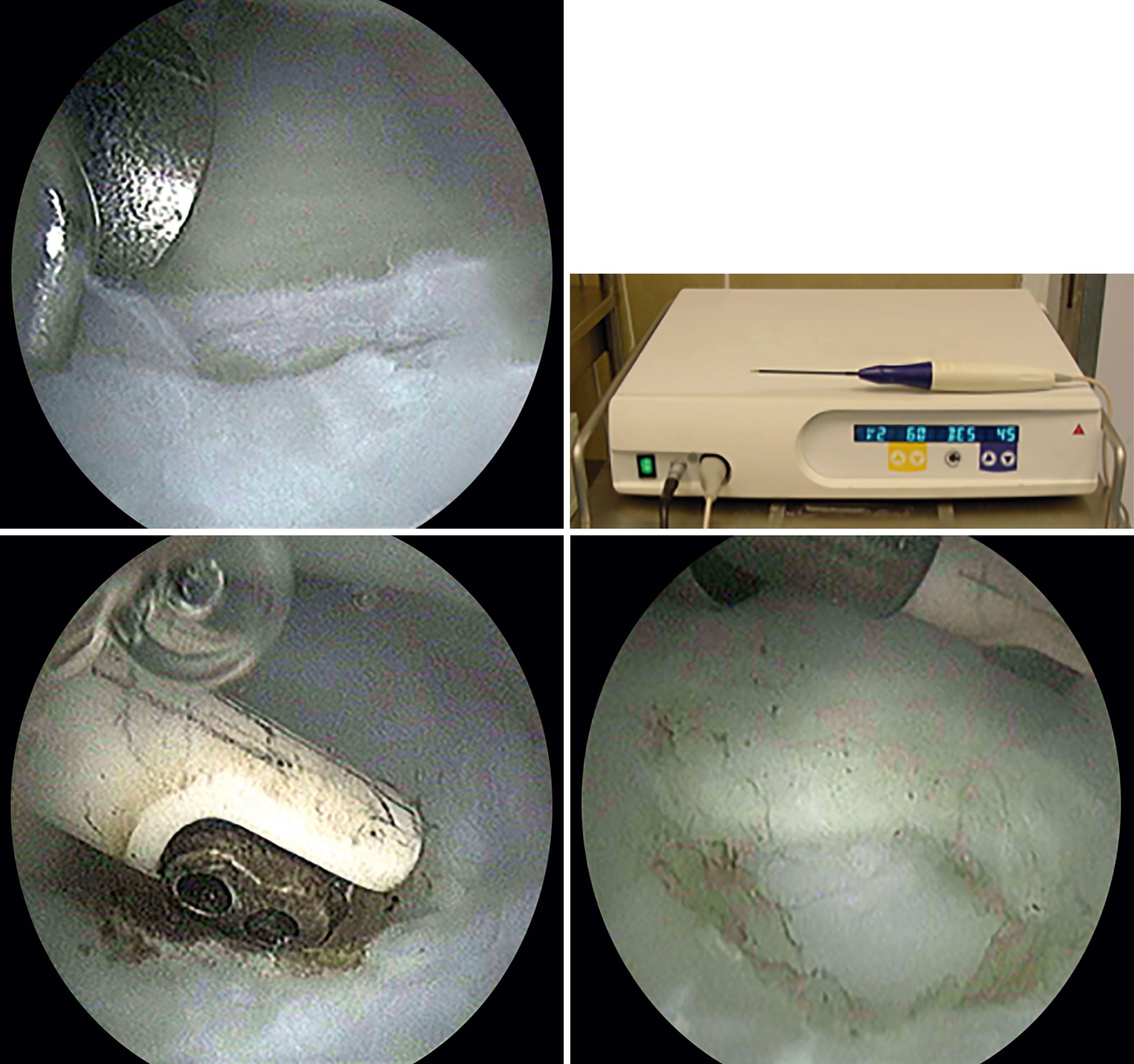
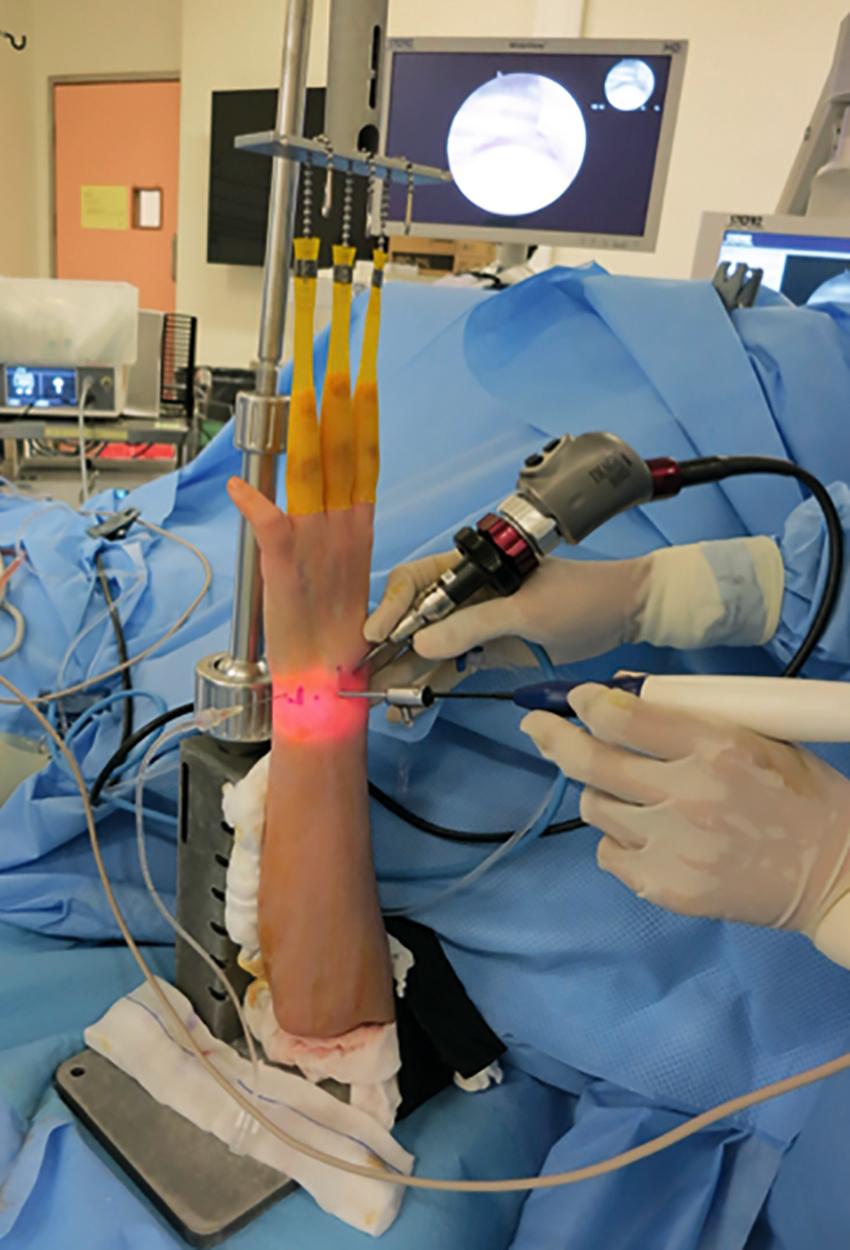
The procedure is best indicated for rheumatoid arthritis and other systemic arthritides involving the wrist joint. Adolfsson and Frisén first reported in 1997 the outcome of arthroscopic synovectomy in 18 patients with painful rheumatoid synovitis who failed medication and with only early radiographic changes. There was improved wrist motion and grip strength 6 months following synovectomy. The results were sustained in a longer-term follow-up at 3.8 years after surgery. Other studies with long-term follow-up of an average of 13 years showed good outcomes even in advanced diseases of Larsen grade III and IV arthritis, and no correlation was found between radiographic staging and clinical outcome. Recurrent cases could also benefit from a second arthroscopic synovectomy.
Arthroscopy also plays a prominent diagnostic role in inflammatory arthritis by offering a direct visualization and full access to almost all areas within the joint. Any abnormal synovitis and chondral damage can be detected in early phases. The morphology of the synovium may give a clue to the origin and diagnosis: villonodular in rheumatoid arthritis, seronegative arthritis, and psoriatic arthritis; tophaceous in gouty arthritis; fibrillated in osteoarthritis and posttraumatic arthritis, and fibrinoid in septic arthritis ( Fig. 17.7 ). Synovial biopsy can be obtained for histopathological and microbiological analysis, especially in monoarticular arthritis cases, where infection or pigmented villonodular synovitis (PVNS) need to be excluded.
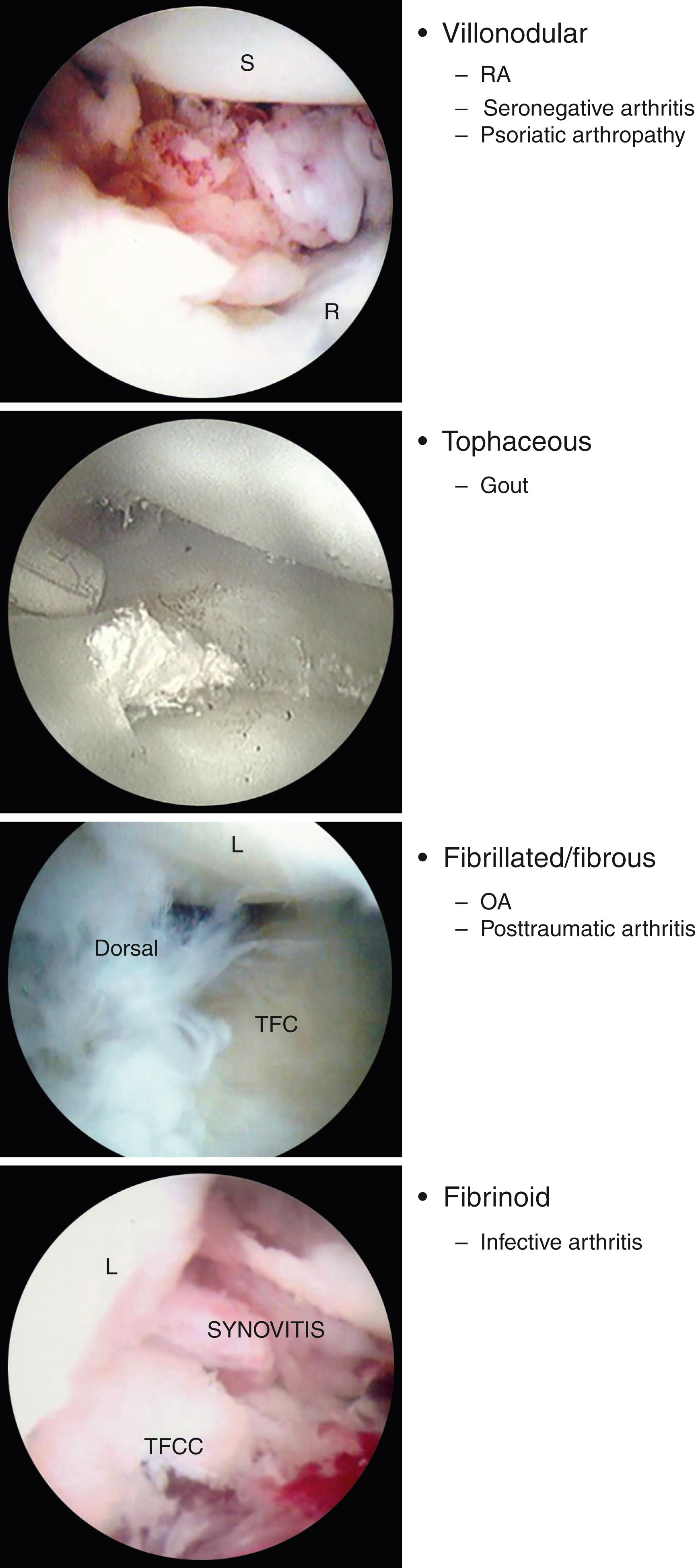
The operation can be done under regional anesthesia or PSLA. When PSLA is being used, the volar ligaments and capsule can be anesthetized by injecting 2% lidocaine with adrenaline under direct arthroscopic vision through the dorsal portals. We perform routine inspection of the radiocarpal joint through the 3-4 portal using a 2.7- or 1.9-mm arthroscope. The 4-5 portal is used for instrumentation. For cases with florid synovitis, additional access such as the 1-2 and 6R portals may need to be employed to allow a more thorough and extensive synovectomy. Shaving of synovium is best performed using a motorized shaver with suction at a low rate of 1000 to 1500 rpm. The midcarpal joint is approached through the MCR portal. Instruments are introduced from the MCU portal. Accessory portals including STT and TH portal can be used for outflow and instrumentation. The DRUJ is also examined if clinical symptoms and signs of DRUJ pathology are present. Most of the time the TFCC is perforated and the DRUJ can be accessed from the radiocarpal joint. A 1.9 mm arthroscope is used if separate portals for DRUJ are required. Immediate postoperative wrist mobilization is encouraged. Technically, even in patients with advanced joint involvement and extremely narrow joint space radiographically, arthroscopy is frequently feasible. This is mainly because the capsular laxity induced by the disease process enables sufficient joint distension upon digital traction and saline irrigation. Feasibility for a successful operation can be predicted by performing a traction test under fluoroscopic guidance preoperatively to assess for joint distractibility ( Fig. 17.8 ).
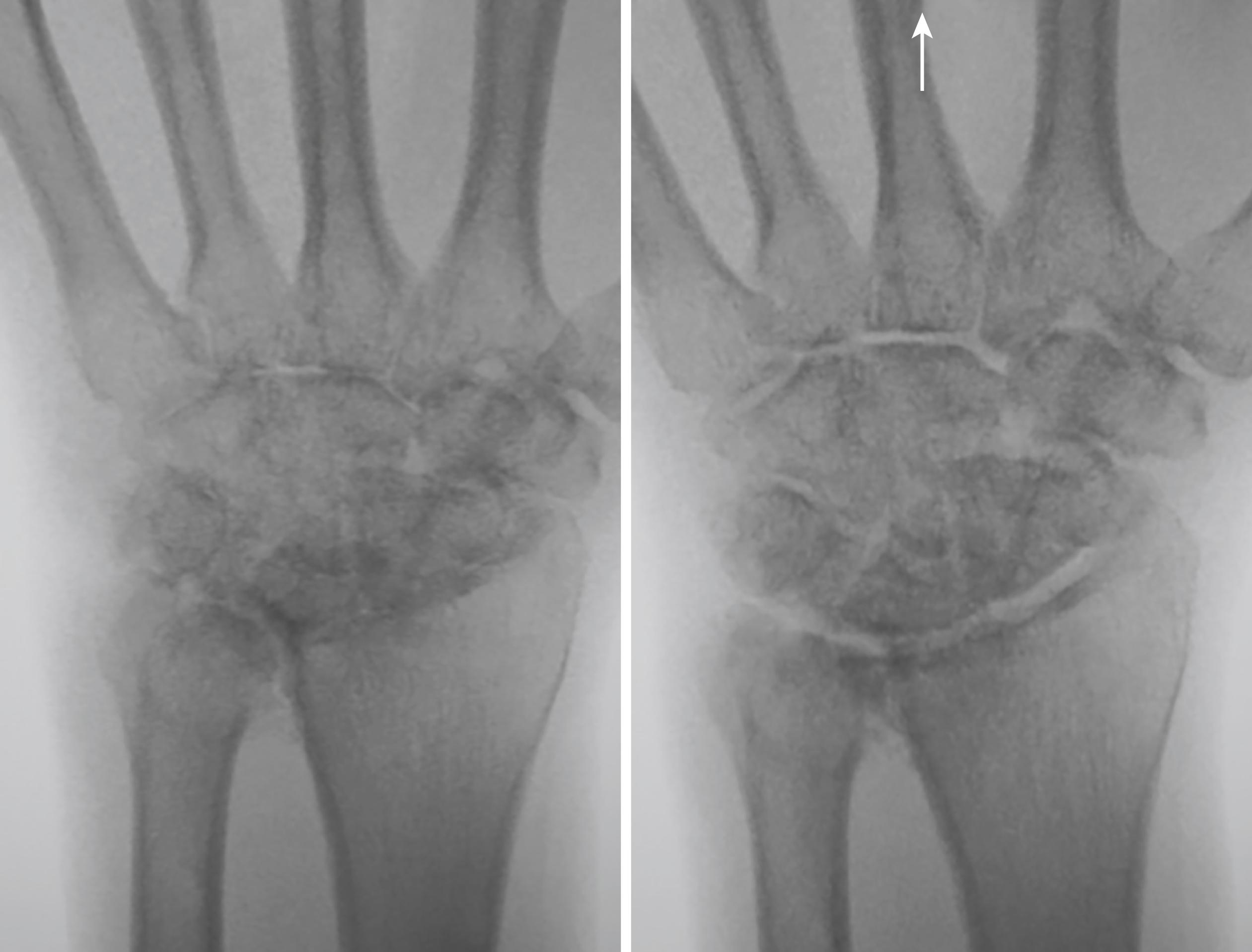
The introduction of small RF probe has significantly improved the efficiency of the procedure and it has become our instrument of choice since 2001. However, as the depth of heat penetration effect of the RF apparatus cannot be fully controlled, debridement of synovium at the dorsal aspect of the wrist near the extensor tendons should better be done with mechanical shaver in order to minimize the potential thermal damage to the tendons, especially in patients with preexisting extensor tendinopathy. Continuous saline irrigation and restricting the time of each impulse of RF energy to 3 to 5 seconds helps to avoid thermal necrosis. Torn interosseous ligaments should be debrided. Subchondral cysts caused by synovial erosion can be curetted using a small angled curette. Synovial biopsy can also be taken in case of uncertain etiology of the synovitis. Caution has to be taken not to damage the already weakened ligaments in wrists with rheumatoid synovitis ( ![]() ). Others have reported the use of Ho: YAG laser set at an energy level of 1.2 to 1.5 j and 15 pulses per second.
). Others have reported the use of Ho: YAG laser set at an energy level of 1.2 to 1.5 j and 15 pulses per second.
Chronic wrist inflammatory arthritis
Failed medical treatment for 6 months
Preferably mono- or oligoarticular arthritis
Check extensor tendon function of fingers and wrist.
Extensor tenosynovitis should be differentiated from wrist synovitis.
Check joint space opening with traction under fluoroscopy for advanced-stage disease.
Patients with significant resting pain usually benefit best from arthroscopic synovectomy.
Carefully protect the fragile skin of fingers during finger trap traction, especially in patients with chronic steroid treatment.
Joint space is often more spacious than demonstrated by radiographs due to capsular laxity from inflammatory synovitis.
The common sites of synovitis are depicted in eFig. 17.30 .
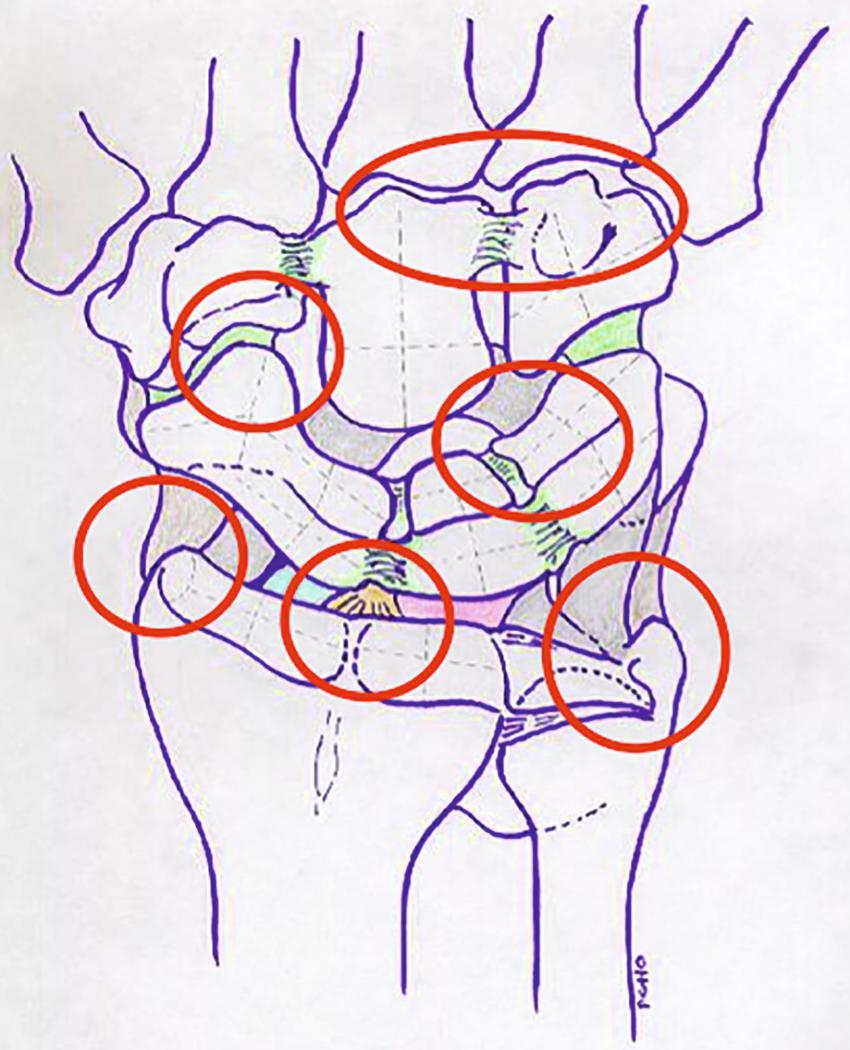
RF is helpful for synovectomy and TFCC debridement.
Be prepared to use multiple portals for complete clearance of synovitis.
When using PSLA, inject 2% lidocaine directly to the volar capsular structures under arthroscopic vision to help provide adequate anesthesia before shaving on the volar aspect.
Amount of postoperative pain relief is proportional to the amount of inflamed synovium being removed.
Use of 1.9 mm scope is useful in negotiating through all the joint spaces especially in advanced arthritis.
Mark all portals on the wrist under traction before starting the procedure.
Synovectomy on the dorsal aspect can be visualized and performed through the lateral portals such as 1-2 and 6R.
Midcarpal arthroscopy is mandatory as synovitis is often more extensive than that in the radiocarpal joint.
The arthroscope and shaver should reach the distalmost extent of the midcarpal joint to clear the synovitis at the carpometacarpal joint area of the hamate and capitate.
Do not use RF probe in clearing dorsal synovitis to avoid thermal injury to the extensor tendons.
When using RF probe, insertion of the probe through an arthroscopic sheath allows bubble release and venting of the heated saline.
To help clear DRUJ synovitis, an assistant can manually compress the DRUJ in various positions of pronation and supination, forcing the inflamed synovium through the defect in the disk into the ulnocarpal joint so that it can be removed by the RF probe or shaver.
Careless portal making may endanger extensor tendons.
Excessive use of RF energy can cause thermal injury to the flexor and extensor tendons, leading to delayed rupture of the tendons within the first 3 weeks postoperative.
No stitch is required for wound closure.
Compressive bandaging for a few days to reduce saline swelling.
Early finger mobilization to avoid tendon adhesion.
Monitor for extensor tendon dysfunction for 3 weeks especially if RF probe has been used at surgery.
Physiotherapy may be indicated if early stiffness is noted, usually at 2 to 4 weeks postoperative.
Osterman first described the technique of arthroscopic treatment for the typical dorsal wrist ganglion arising close to the SL joint in 1995. It is better to describe the procedure as “ganglionotomy” rather than “ganglionectomy” since the ganglion cyst is not excised structurally. The principle is to abolish the “check valve” phenomenon by creating a capsular defect at the stalk portion of the ganglion cyst where the cyst communicates with the wrist joint and therefore allowing spontaneous drainage, shrinkage, and resolution of the ganglion cyst. In the original study, the 6R portal was used as the viewing portal. The stalk could be identified in only 61% of the cases. A full radius resector was introduced from the 3-4 portal to resect a 1 cm defect from the dorsal capsule. The end point was to see a gush of mucinous fluid from the ganglion draining into the joint, followed by a complete disappearance of the ganglion externally. In Osterman’s series, complete resection was achieved in all of the 18 cases with no recurrence.
It is generally considered to be desirable to identify the stalk of the ganglion at the dorsal capsule-ligamentous junction of the SL joint. Arthroscopically it presents as a capsular bulging lesion with focal synovial hypertrophy. Ahsan and Yao used a color-aided technique of indigo carmine dye to visualize the stalks. However, the experience in identifying the stalks varies, and this might not be a significant factor contributing to success or recurrence. Because the stalk of dorsal wrist ganglion is not a constant finding arthroscopically, an alternative technique has been developed, including the use of an intrafocal portal through the cyst. , Wu et al. retrospectively compared the result of transcystic portal and cyst-sparing portal technique and found no difference in recurrence rate, complication, and clinical results at mean follow-up of 3 years. In general, the rate of recurrence varied from 0% to 29.7% in the literature. , , , Systematic reviews and metaanalyses showed comparable recurrence and complication rate following open versus arthroscopic excision of wrist ganglions. ,
Arthroscopic dorsal wrist ganglionotomy is best indicated in a symptomatic patient with a dorsal wrist ganglion arising from the SL joint, as illustrated by the typical location just distal to the Lister tubercle of the distal radius. The ganglion is preferably a sessile one or one with short stalk pivoting at the SL interval ( ![]() ). Tenosynovial cysts from the extensor tendons should be excluded. The nature of the cyst should be confirmed preoperatively either by aspiration to yield gelatinous content or by ultrasound scanning to show its cystic nature, as arthroscopic treatment of a solid soft tissue tumor is contraindicated. The latter can also help establish the capsular relationship of the ganglion with the wrist joint and the likely origin at the SL capsule-ligamentous junction. In general, ganglions larger than 1 cm diameter are preferable, as the surgical end point of treating an occult ganglion less than 1 cm may be illusive. Any wrist mass of uncertain nature should not be subjected to arthroscopic resection. The appearance of the surgical scar is often more favorable than open surgery for larger ganglions, especially in obese patients ( Fig. 17.9 ). Other indications include a dorsal wrist ganglion associated with wrist pain or signs of SL instability since the cause of the pain can be evaluated with wrist arthroscopy and appropriate treatment performed simultaneously. Recurrent ganglion can also be treated with this technique though with increased difficulty. Dorsal ganglions arising from other atypical sites of the wrist are generally treated with open excision, though there has been report on treating wrist ganglia arising from the LT joint with a similar technique and principles ( Fig. 17.10 ).
). Tenosynovial cysts from the extensor tendons should be excluded. The nature of the cyst should be confirmed preoperatively either by aspiration to yield gelatinous content or by ultrasound scanning to show its cystic nature, as arthroscopic treatment of a solid soft tissue tumor is contraindicated. The latter can also help establish the capsular relationship of the ganglion with the wrist joint and the likely origin at the SL capsule-ligamentous junction. In general, ganglions larger than 1 cm diameter are preferable, as the surgical end point of treating an occult ganglion less than 1 cm may be illusive. Any wrist mass of uncertain nature should not be subjected to arthroscopic resection. The appearance of the surgical scar is often more favorable than open surgery for larger ganglions, especially in obese patients ( Fig. 17.9 ). Other indications include a dorsal wrist ganglion associated with wrist pain or signs of SL instability since the cause of the pain can be evaluated with wrist arthroscopy and appropriate treatment performed simultaneously. Recurrent ganglion can also be treated with this technique though with increased difficulty. Dorsal ganglions arising from other atypical sites of the wrist are generally treated with open excision, though there has been report on treating wrist ganglia arising from the LT joint with a similar technique and principles ( Fig. 17.10 ).
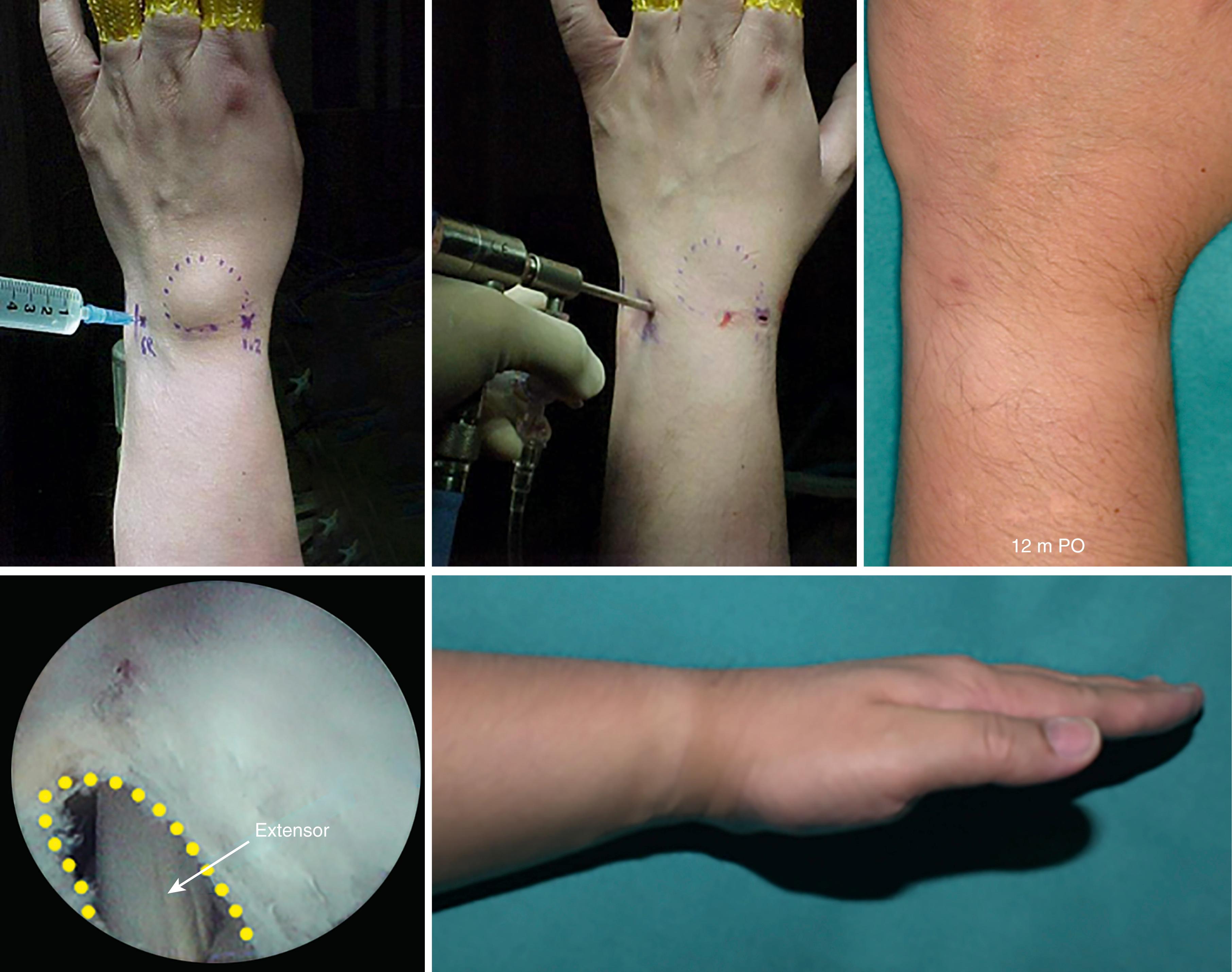
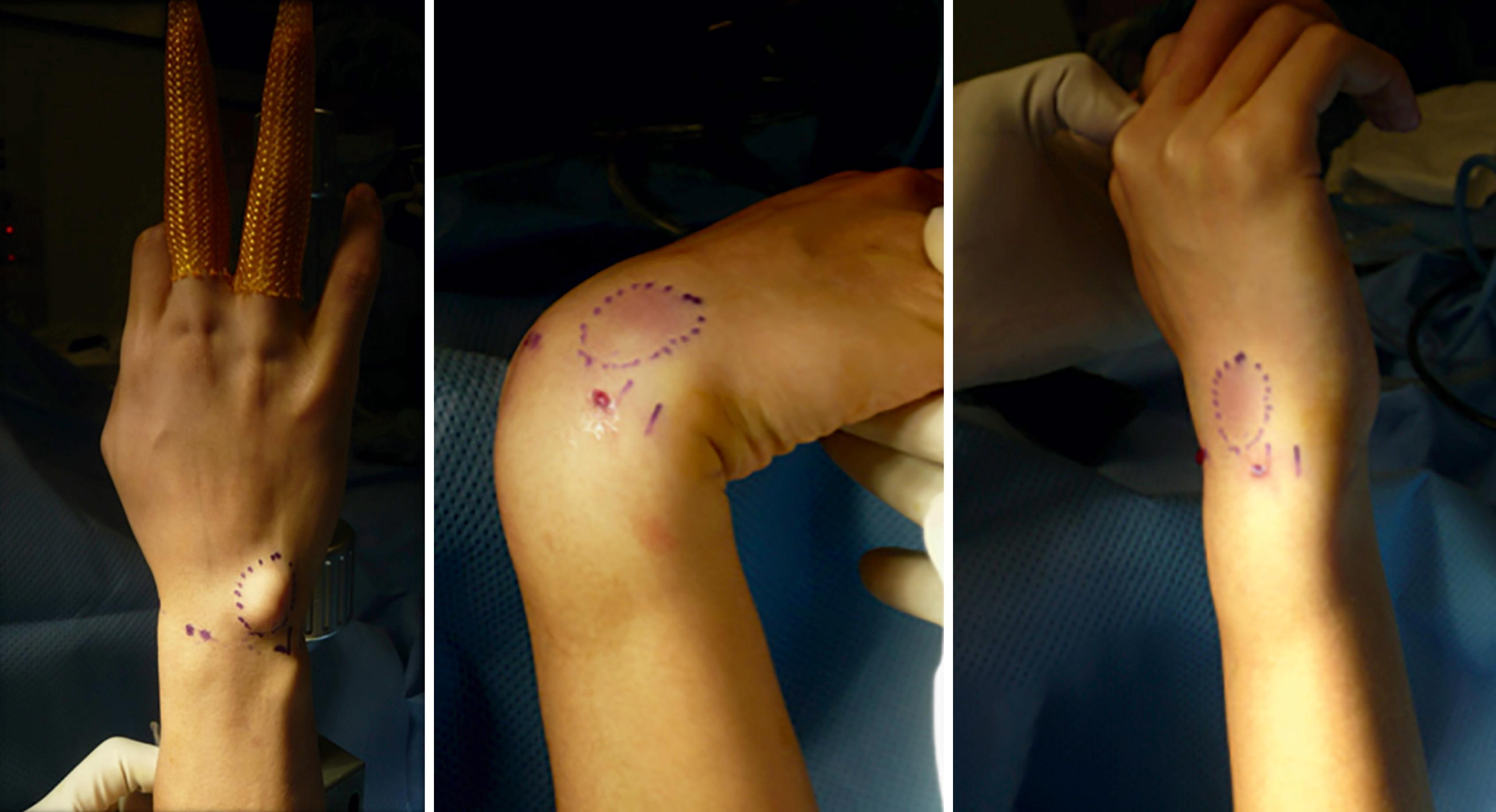
The author prefers the operation to be performed under PSLA as it minimizes the anesthetic risk to the patient. Tourniquet is not essential as bleeding is rarely a problem. A 1.9 mm arthroscope is preferred to improve scar appearance. Two portals are made at 1-2 and 6R. Lidocaine is also infiltrated around the stalk of the ganglion near 3-4 portal to minimize pain during the resection process. The author believes that placing the surgical scar on the outer aspect of the wrist in contrast to the more central location of the usual 3-4 portal can produce a more pleasant esthetic outcome. A clear arthroscopic view is maintained by establishing outflow at 6U portal using an 18-gauge needle. From the 6R portal, the arthroscope is advanced toward the SL joint interval dorsally, where there is always localized synovial hypertrophy. A 2.0 mm shaver is introduced from the 1-2 portal to remove the synovial folding and to display the dorsal aspect of the SL ligament. The arthroscope is then directed distal and dorsally toward the junction between the SL ligament and the dorsal capsular reflection of the radiocarpal joint where the ganglion stalk may arise ( ![]() ). The stalk of a ganglion can be seen as bulging from the dorsal capsule though it is not always present. Nevertheless, pressing the ganglion externally can always lead to bulging motion at this interval of the capsule. Shaving of the stalk of the ganglion can be initiated with the shaver introduced from the 1-2 portal. Gelatinous fluid can be seen draining externally or into the wrist joint. Extensor tendons are occasionally seen through the capsular resection.
). The stalk of a ganglion can be seen as bulging from the dorsal capsule though it is not always present. Nevertheless, pressing the ganglion externally can always lead to bulging motion at this interval of the capsule. Shaving of the stalk of the ganglion can be initiated with the shaver introduced from the 1-2 portal. Gelatinous fluid can be seen draining externally or into the wrist joint. Extensor tendons are occasionally seen through the capsular resection.
In the author’s initial experience, arthroscopic ganglionotomy for dorsal wrist ganglion appeared to be a more time-consuming and tedious procedure compared with open excision, though it produced a more cosmetically pleasing scar, particularly for a ganglion bigger than 1.5 cm in size. In order to reduce the tedium and to improve the efficiency of the procedure, we have modified the technique by applying direct digital compression to the ganglion against the end of the shaver after the capsular reflection on the SL ligament was located arthroscopically (manual compression technique) ( Fig. 17.11 ). Most ganglia will rupture after 1 to 3 minutes of shaving. After successful decompression of the ganglion, further resection of the capsular junction is performed under arthroscopic vision. To ensure resection of the potential one-way valve structure at the stalk, a sizable capsular resection of 5 to 10 mm in diameter should be made in the dorsal capsule. At this juncture of shaving, care is taken to avoid damaging important structures like the intracapsular dorsal wrist ligaments and extensor tendons. All wounds are then closed with Steri-Strips only. No suture is required. Bulky dressing and bandaging is applied for 1 to 2 days to reduce swelling and then light dressing is followed to allow full mobilization of the wrist and fingers. The patient is encouraged to perform self-massaging of the original ganglion site for 3 weeks to prevent pseudorecurrence formation due to regurgitation of joint fluid into the empty cyst remnant before the abolished valve is completely healed ( Fig. 17.12 ).
Dorsal wrist ganglion centered around SL joint of size 1.5 cm or above
Dorsal wrist ganglion associated with wrist pain or evidence of SL ligament lesions
Sessile type better than pedunculated type
Differentiate tenosynovial cyst from articular ganglion; an extensor tendon ganglion will move with the tendon.
Diagnosis of ganglion must be confirmed preoperatively by aspiration, ultrasound scanning, or MRI to rule out other noncystic tumors.
Check mobility of the dorsal ganglion. The less mobile part originates at the SL interval.
Using 1-2 and 6R portals alone are esthetically more pleasing for isolated ganglion without wrist pain.
In cases of wrist pain accompanying ganglion, use standard radiocarpal and midcarpal portals to evaluate.
An identifiable stalk may not be present. The key is to identify the junction between the dorsal SL ligament and the dorsal capsule of the wrist where shaving should be started.
Use of manual compression technique helps to shorten the operative time.
Never use RF probe to resect dorsal ganglion.
Keeping the shaver tangentially on the dorsal capsule minimizes the risk to extensor tendon.
Keeping the shaver end away from the SL ligament avoids iatrogenic injury to the ligament.
After the ganglion ruptures, keep shaving on the dorsal capsule under direct arthroscopic vision till a defect of 5 to 10 mm is achieved, with or without seeing the extensor tendon.
Overaggressive shaving may cause extensor tendon injury.
Poor control of the shaver may injury the SL ligament and cause carpal instability.
Pseudorecurrence of the ganglion may occur early in postoperative period and responds to intensive daily massage for up to 3 weeks.
No stitch is required for wound closure to optimize the scar appearance.
Check finger extensor function.
Compressive bandaging for 2 days to reduce saline swelling.
Patient should be informed about the possibility of pseudorecurrence phenomenon of up to 3 weeks postoperative and be instructed to do daily regular massage at the ganglionotomy site.
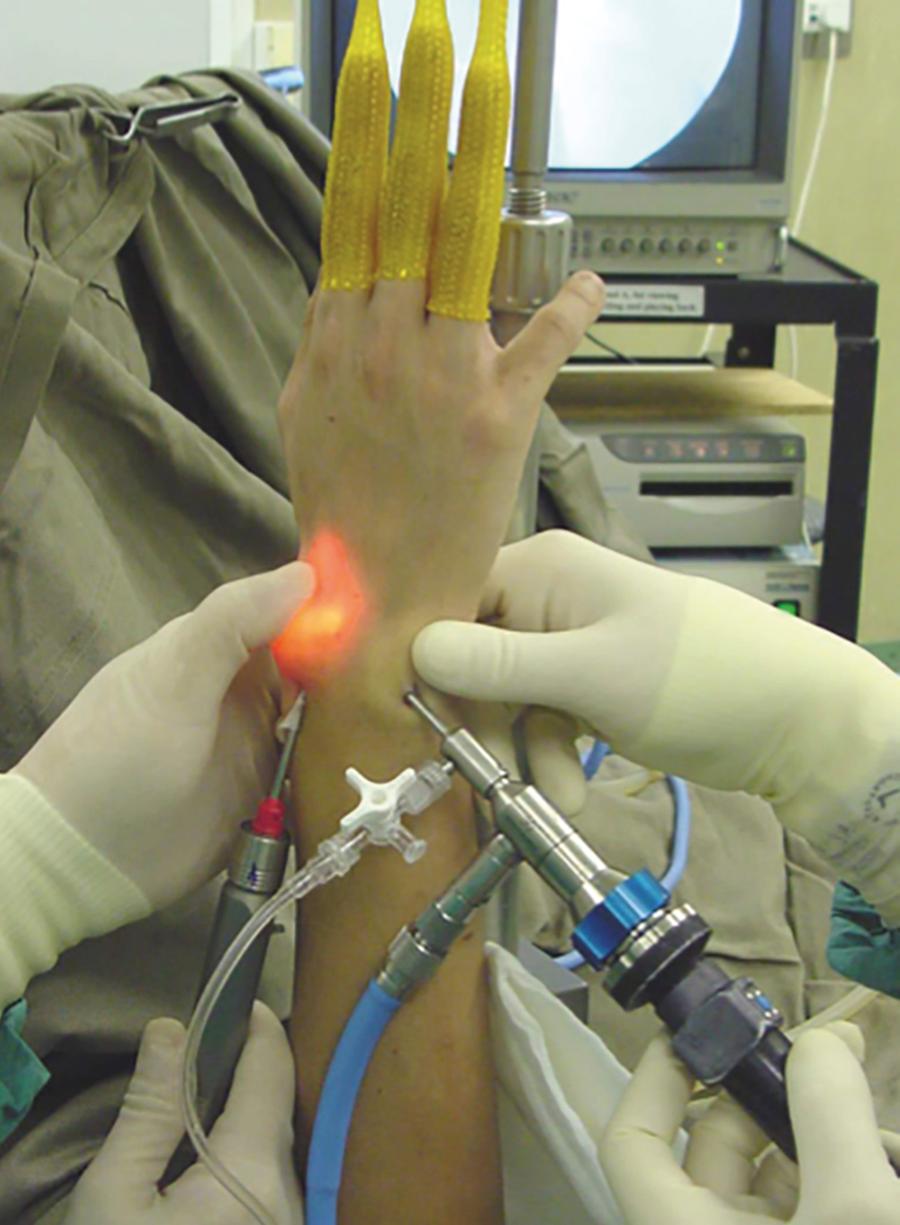
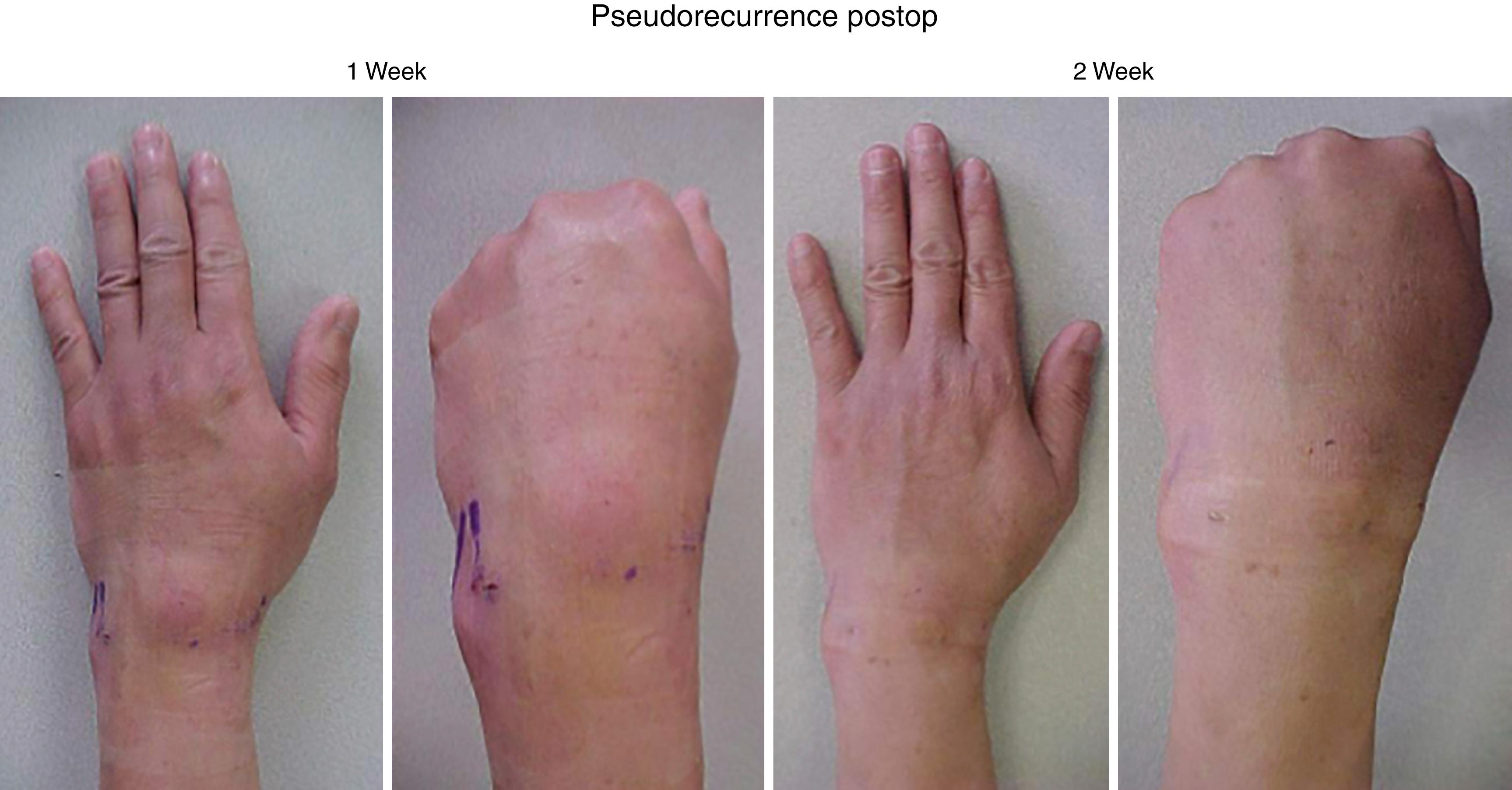
The best indication is sessile type of volar wrist ganglion arising from the radiocarpal joint and centered on the proximal wrist crease. Mobile ganglia with long pedicle are poor candidates for arthroscopic surgery. Preoperative ultrasound scanning helps to confirm the articular origin and nature of the cystic mass. Arthroscopic drainage of a ganglion from the STT joint is feasible with the addition of new portals as described later.
For arthroscopic treatment of the volar wrist ganglion arising from radiocarpal joint, we first described the technique and arthroscopic pathoanatomy in 2003. Technically it is much easier and more straightforward than performing a dorsal ganglionotomy. The author prefers to perform the operation under PSLA without the use of a tourniquet as this can help monitor any possible iatrogenic damage to the radial artery and its branches during the surgery.
A wrist arthrogram can be performed immediately prior to the arthroscopic intervention or as a separate investigative procedure. The use of an intraoperative arthrogram can facilitate the confirmation and identification of the stalk of a ganglion as arising from the radiocarpal joint. Absence of demonstrable contrast filling the stalk with communication from the radiocarpal joint may preclude the use of the technique. With the patient lying supine and with the arm supported by hand table, 3 to 5 cc of nonionic contrast solution is admixed with 2% lidocaine and injected into the radiocarpal joint at the 3-4 portal site under fluoroscopic guidance. Typically, the stalk of the ganglion, and occasionally the cyst itself, can be identified at one of the volar radiocarpal ligament intervals ( Fig. 17.13 ). Ganglia arising from the interval between the RSC and the LRL ligament will show up at the more lateral aspect of the distal radius, while those arising from the interval between the LRL and SRL ligaments will show up at a more central position of the distal radius. The relative position of the contrast-filling stalk can aid the identification of the true stalk during the actual arthroscopic procedure and hence facilitate subsequent decompression. As a rule, ganglia arising from the midcarpal joint or STT joint will not be revealed by arthrogram of the radiocarpal joint, unless one of the interosseous ligaments at the proximal carpal row is ruptured and creates a free communication between the radiocarpal and the midcarpal joint.
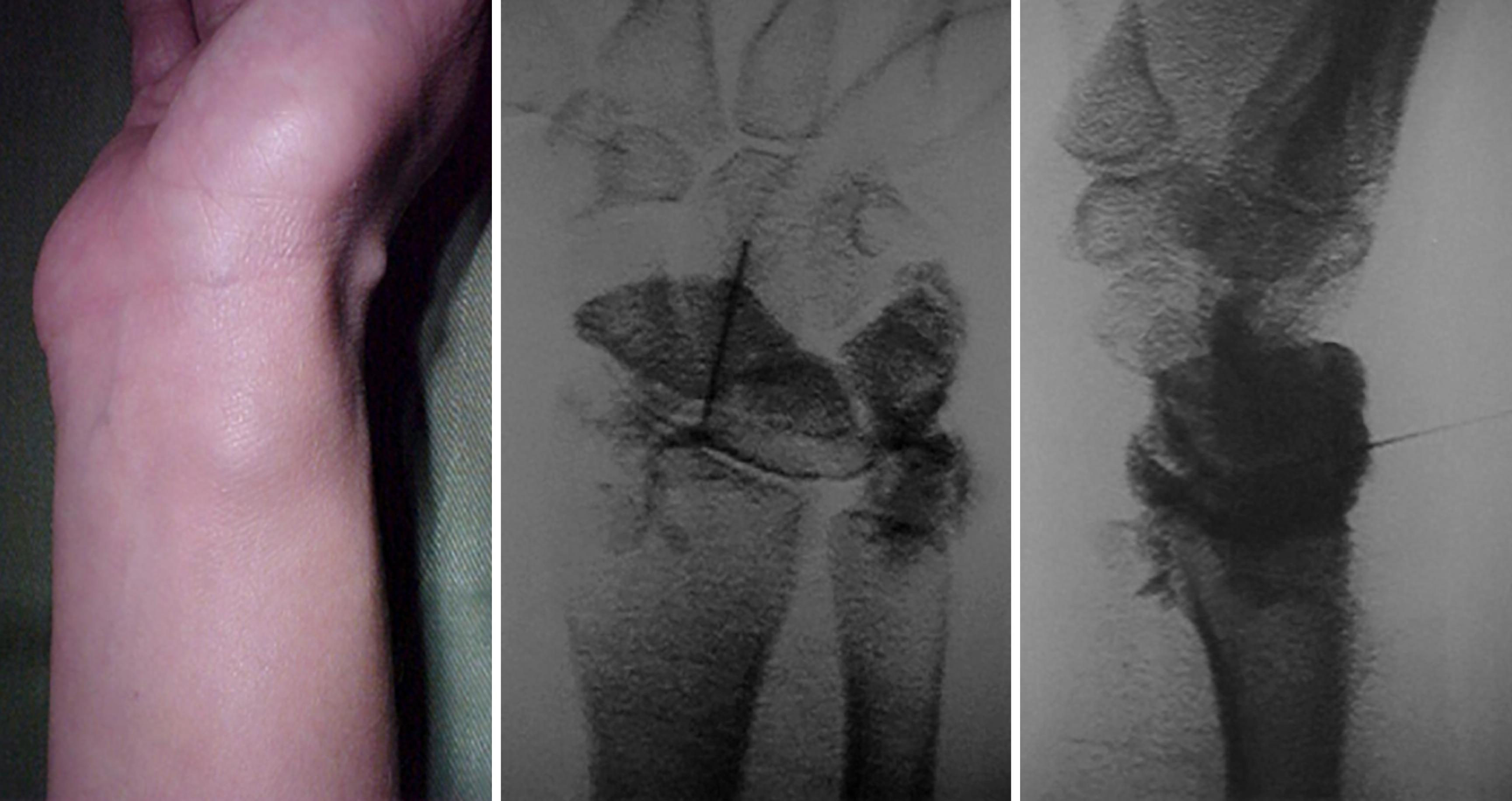
Standard radiocarpal joint arthroscopy is performed. For a right-handed surgeon operating on the right wrist, the scope entry site is typically 1-2, and working portal is 3-4, thus the name “1234” technique that we coined. For the left wrist, the sites are reversed. The outflow portal is 6U. Routine diagnostic arthroscopic examination of the radiocarpal joint is performed, followed by localization of the ganglion. Synovial and capsular abnormalities are identified at the interval between the palmar radiocarpal ligaments ( Fig. 17.14 ). Alternatively the site of ganglion connection with the joint can also be identified by direct external manual compression of the ganglion, which will cause internal bulging of the ligamentous interval or even expression of gelatinous content from the ganglion into the joint ( ![]() ). A 2.0 mm arthroscopic shaver is then introduced to debride the region, while gentle external pressure is applied on the ganglion. The working portals may be swapped between 1-2 and 3-4 depending on the direction of access to the ganglion stalk. In contrast to dorsal wrist ganglion, a stalk can always be found. The radial artery should be palpated from time to time when the operation is performed without tourniquet. When sufficient enlargement of the capsule defect is achieved, a sudden gush of the gelatinous content into the radiocarpal joint can often be seen, and this is removed by suction until the ganglion completely disappears ( Figs. 17.15 and 17.16 ). In the process when the capsular opening is enlarged further, care is taken not to advance the shaver too anteriorly, endangering the radial artery, which is often lying close to the cyst wall. The cyst wall is not resected. A capsular defect about 5 to 10 mm in size is usually resulted at the interligamentous sulcus after the procedure. The ganglion cyst will keep on bulging out under continuous fluid irrigation. However, with successful decompression, it will characteristically regress completely upon gentle external manual pressure once the irrigation fluid inflow is stopped. Steri-Strips are then used to close the portal sites. The ganglion site is packed with thick gauze bandages and the wrist is protected with crepe wrap to provide continuous external pressure to the decompressed ganglion site. Light dressing is then changed at day 2 with a waterproof dressing material. Patients are advised to have early mobilization and free use of the hand and wrist for daily activities soon after the arthroscopic procedure, although heavy manual exertion is to be avoided for 1 month. They are also instructed to perform frequent daily digital massage at the decompression site for up to 3 weeks to avoid pseudorecurrence. Dressing and Steri-Strips can usually be removed between days 10 to 12 after operation.
). A 2.0 mm arthroscopic shaver is then introduced to debride the region, while gentle external pressure is applied on the ganglion. The working portals may be swapped between 1-2 and 3-4 depending on the direction of access to the ganglion stalk. In contrast to dorsal wrist ganglion, a stalk can always be found. The radial artery should be palpated from time to time when the operation is performed without tourniquet. When sufficient enlargement of the capsule defect is achieved, a sudden gush of the gelatinous content into the radiocarpal joint can often be seen, and this is removed by suction until the ganglion completely disappears ( Figs. 17.15 and 17.16 ). In the process when the capsular opening is enlarged further, care is taken not to advance the shaver too anteriorly, endangering the radial artery, which is often lying close to the cyst wall. The cyst wall is not resected. A capsular defect about 5 to 10 mm in size is usually resulted at the interligamentous sulcus after the procedure. The ganglion cyst will keep on bulging out under continuous fluid irrigation. However, with successful decompression, it will characteristically regress completely upon gentle external manual pressure once the irrigation fluid inflow is stopped. Steri-Strips are then used to close the portal sites. The ganglion site is packed with thick gauze bandages and the wrist is protected with crepe wrap to provide continuous external pressure to the decompressed ganglion site. Light dressing is then changed at day 2 with a waterproof dressing material. Patients are advised to have early mobilization and free use of the hand and wrist for daily activities soon after the arthroscopic procedure, although heavy manual exertion is to be avoided for 1 month. They are also instructed to perform frequent daily digital massage at the decompression site for up to 3 weeks to avoid pseudorecurrence. Dressing and Steri-Strips can usually be removed between days 10 to 12 after operation.
Volar wrist ganglion centered around the proximal wrist crease indicating a stalk from the radiocarpal joint
Volar wrist ganglion centered around the distal wrist crease indicating a ganglion from the STT joint
Sessile type of ganglion more suitable than the pedunculated type
Diagnosis of ganglion must be confirmed preoperatively by aspiration, ultrasound scanning, or MRI to rule out other noncystic tumor or tenosynovial FCR cyst.
Palpate the radial artery to delineate the relationship with the ganglion.
Performing on-table arthrogram helps to confirm the connection of the ganglion with the wrist joint.
Abnormal synovitis at the interligamentous sulcus is a hallmark of a volar ganglion from the radiocarpal joint.
Pressing the ganglion externally should demonstrate bulging of the origin of the ganglion as viewed intraarticularly.
Just shave the ligament interval with abnormal synovitis and not the ligament itself to abolish the abnormal check-valve of the ganglion.
Do not attempt to shave the cyst wall or otherwise the radial artery is at risk.
Palpate the tip of the shaver through the volar surface of the wrist to avoid accidental damage to the flexor tendons and radial artery.
If the surgery is performed under PSLA without tourniquet, the radial pulse is checked intermittently to ensure its integrity.
Overaggressive shaving may cause injury to the volar radiocarpal ligaments.
Attempted shaving of the cyst wall may cause radial artery damage and bleeding.
Inadequate instruction to the patient on massaging the ganglionotomy site at postoperative period may lead to persistence of pseudorecurrence of the ganglion.
No stitch is required for wound closure to optimize the scar appearance.
Compressive bandaging for 2 days to reduce saline swelling.
Patient should be informed about the possibility of pseudorecurrence phenomenon of up to 3 weeks postoperative and be instructed to do daily regular massage at the ganglionotomy site.
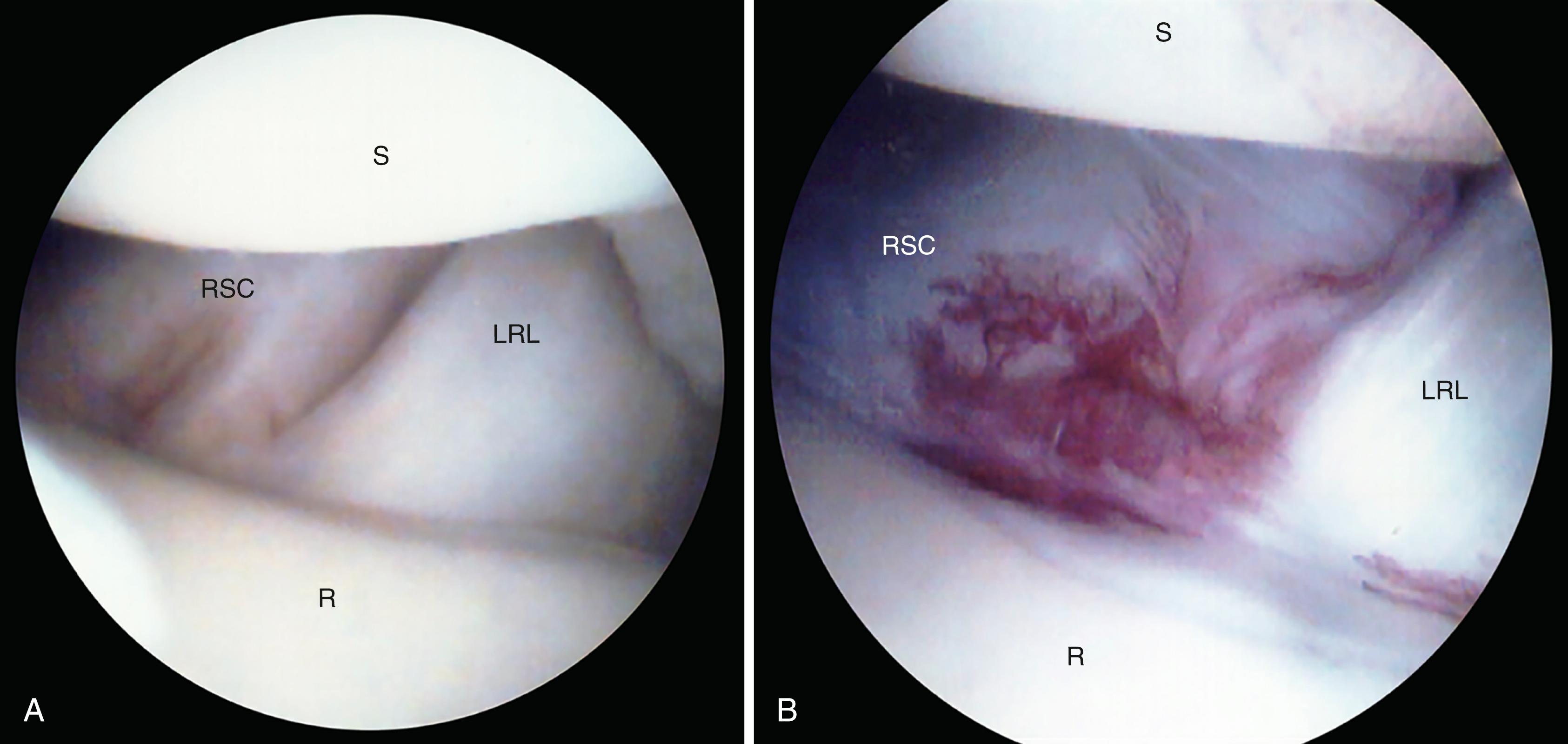
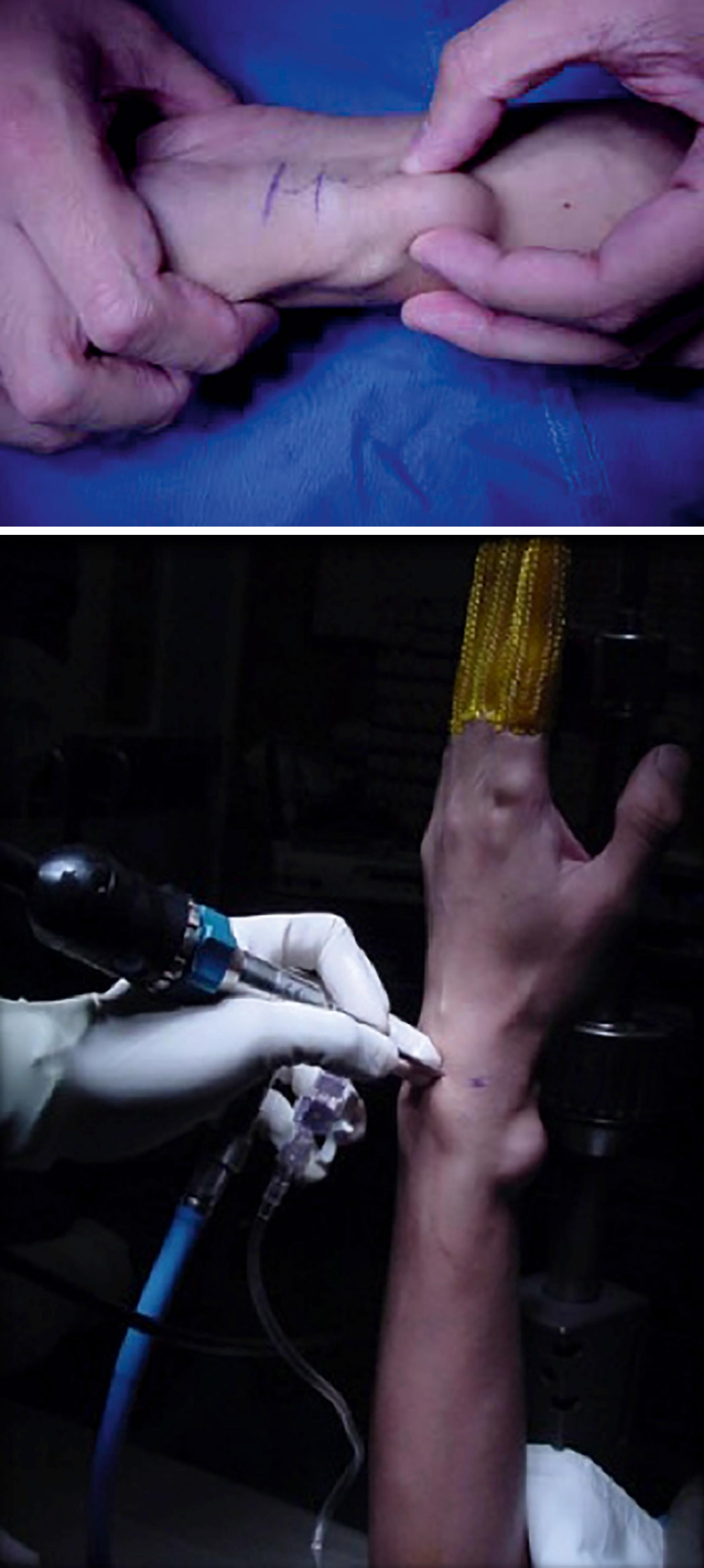
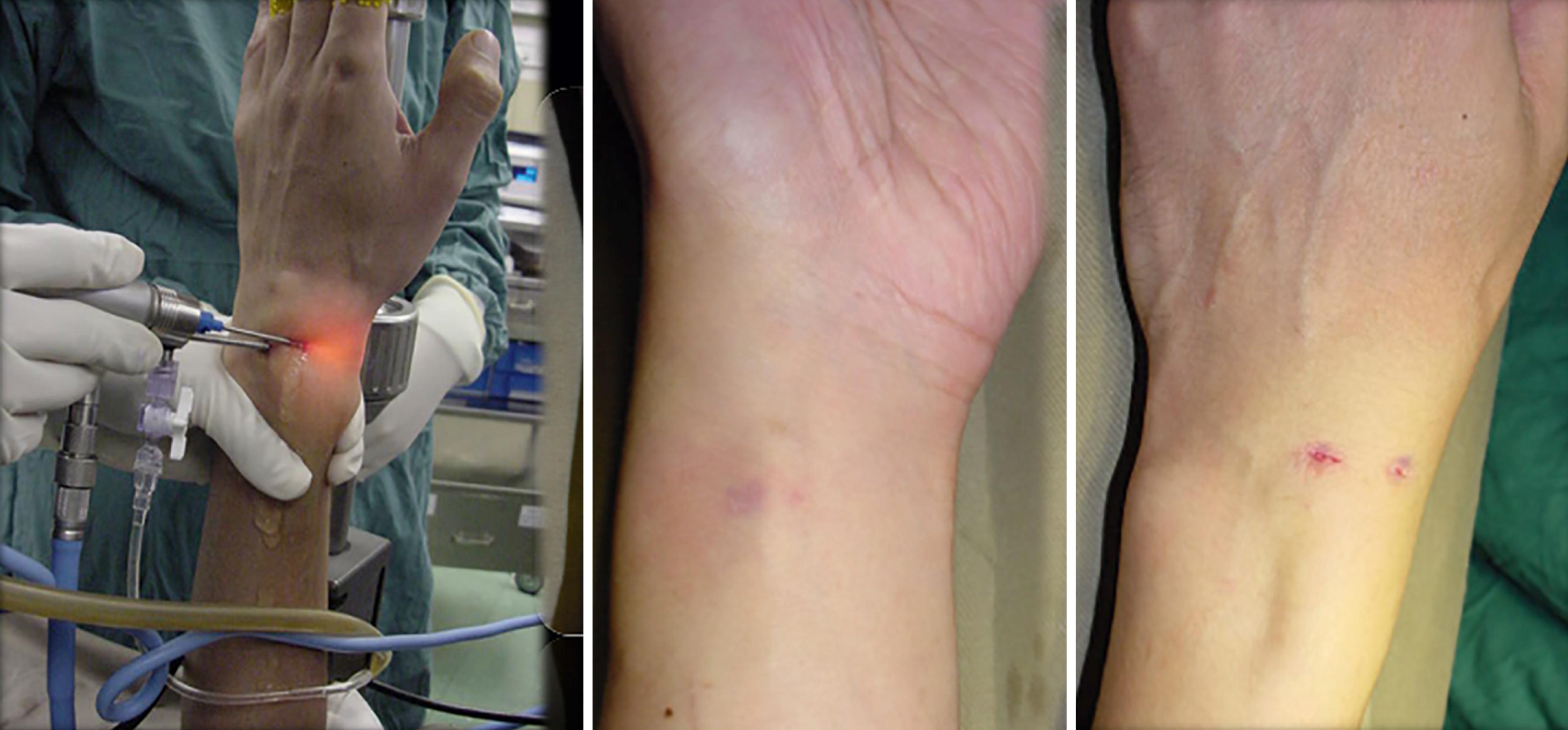
We reviewed the long-term result of 21 volar wrist ganglia arising from the radiocarpal joint, and 75% of ganglia arose from the interval between RSC and LRL ligament and 25% from the interval between LRL and SRL ligament. Two recurrences were noted at an average follow-up of 56 months. They were managed by repeated arthroscopic treatment ( Fig. 17.17 ). No neurovascular complication was encountered. Fernandes et al. described their experience with 31 arthroscopic volar ganglionotomies. They used the 4-5 portal for visualization and the 1-2 portal for instrumentation. The authors noted 1 case of superficial radial neuritis, 2 hematomas, and 1 recurrence.
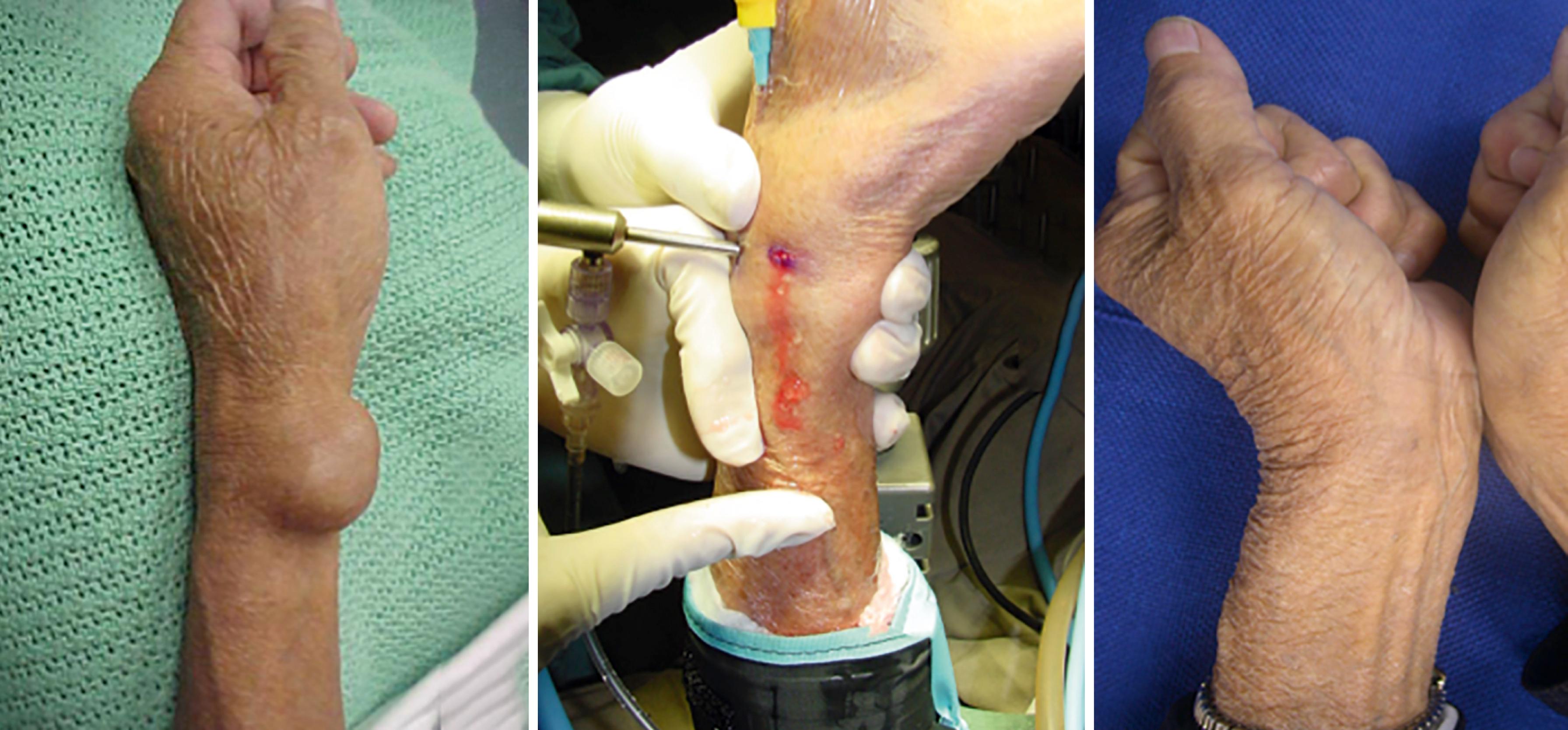
For those ganglia that arise from the STT joint, no technique on arthroscopic surgery has been published until recently. Chai and Ho reported 2 cases of arthroscopic decompression of STT joint ganglion under PSLA with no recurrence at 50 months of follow-up. Good indication includes ganglion associated with STT joint arthritis. Simultaneous synovectomy and joint debridement can be performed to alleviate the joint symptoms.
The ganglion is typically located at the distal wrist crease level around the scaphoid tubercle. During the operation, the stalk can be evaluated with contrast arthrogram performed at the midcarpal joint. A MCR portal is made, and a STT-R portal is established as previously described. An optional third portal can be made in the palmar aspect of the STT joint, the STT-p portal. By advancing the arthroscope anteriorly negotiating the dorsoradial joint space between scaphoid, trapezoid, and trapezium, the volar scaphotrapezial ligament can be reached. Application of finger trap to the thumb helps to increase the working space. Synovitis is noted at the palmar capsule and the ligament fiber intervals. External mobilization of the ganglion provokes simultaneous movement of the palmar ligament and the capsule, and this maneuver helps to imply the ganglion origin. Shaving of the ligament interval using a 2 mm shaver while digital pressure is maintained against the ganglion externally is performed until there is complete drainage of gelatinous fluid into the STT joint. Further shaving of the stalk until a capsular defect of 5 to 10 mm is made, with an aim to abolish the pathologic valve phenomenon ( ![]() ). One should avoid passing the shaver too anteriorly to endanger the superficial branch of the radial artery. The postoperative care is similar to those of volar ganglion treatment. The decompression of a ganglion arising from the STT interval is generally more difficult compared with the standard volar ganglion. Small arthroscope of 1.9 mm and small shaver of 2 mm are mandatory.
). One should avoid passing the shaver too anteriorly to endanger the superficial branch of the radial artery. The postoperative care is similar to those of volar ganglion treatment. The decompression of a ganglion arising from the STT interval is generally more difficult compared with the standard volar ganglion. Small arthroscope of 1.9 mm and small shaver of 2 mm are mandatory.
Loose bodies in the wrist are uncommon. Koh et al. reported loose bodies in 1.4% of the series of 707 wrist arthroscopy patients. Arthroscopy is considered as the best maneuver in removing an intraarticular chondral or osteochondral loose body that causes symptoms of locking or clicking. The causes can be due to osteoarthritis, articular fracture, cartilage nutrition disorders, and infection. Frequently the loose body is radiolucent but can be detected with the aid of CT scan or MRI. Mosquito graspers, straight and curved, are invaluable in retrieving loose body from within the joint ( eFig. 17.31 ). A hypodermic needle can be used to maneuver or skewer the loose body. Particular attention should be paid to potential recesses of the joint including the prestyloid recess, the recess between the radial styloid and palmar radiocarpal ligament, ulnar facet of the triquetral-hamate joint, and the STT joint region. The author had an experience of removing an unsuspected loose osteochondral fragment from the DRUJ in a female patient presented with locking of the forearm rotation after trivial ulnar styloid fracture. Katolik described an arthroscopic removal of loose body from the pisotriquetral joint following a low-energy trauma in a collegiate rower.
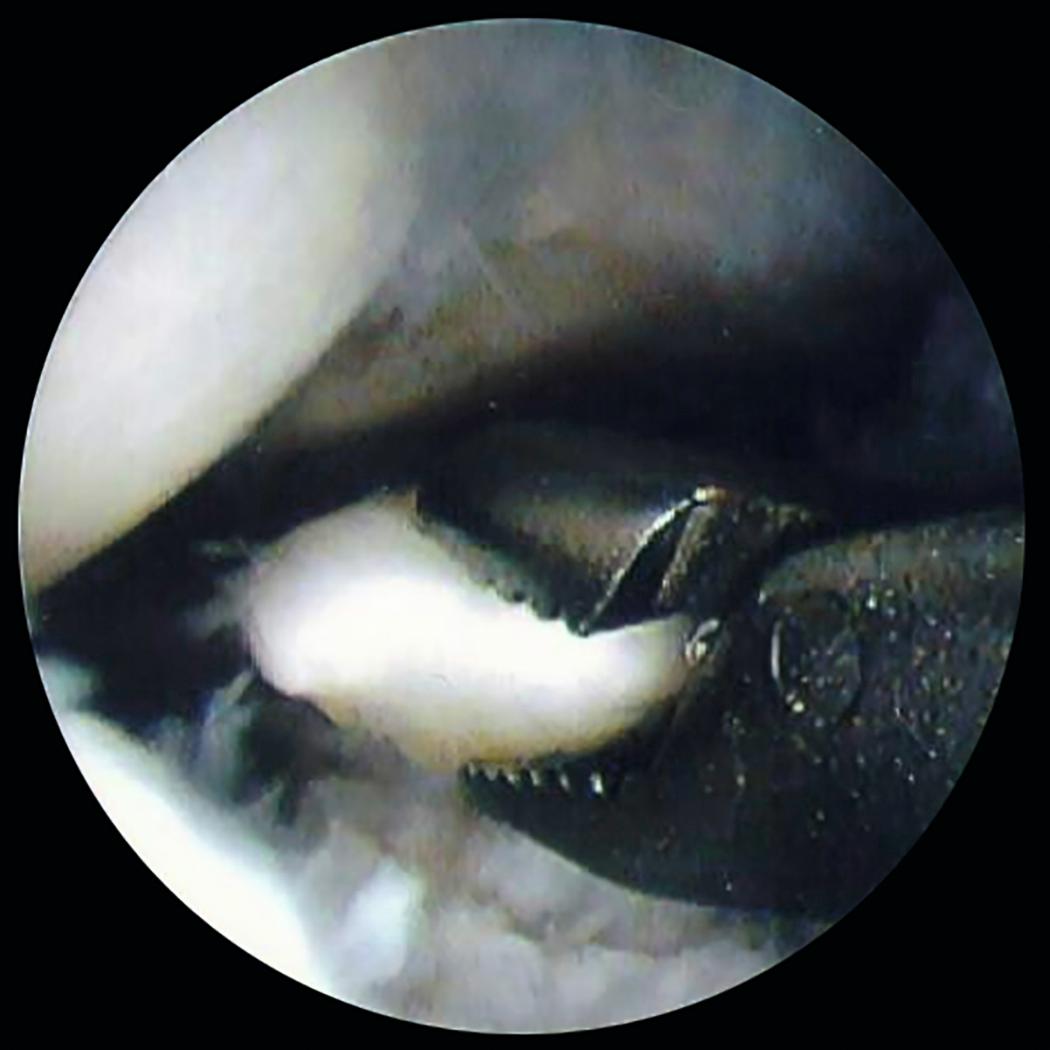
Wrist stiffness is a debilitating condition often secondary to trauma or prolonged immobilization and may have intraarticular and extraarticular etiologies. Arthrofibrosis may be localized or diffuse. Arthroscopic arthrolysis is an effective treatment for restoring range of motion and reducing pain. Carpal instability is a potential contraindication for capsular release since release of the volar and/or dorsal extrinsic ligaments may exacerbate the condition. Presence of significant posttraumatic arthritis or osteoarthritis would limit any potential gain. Patients who cannot comply with postoperative dynamic–static progressive splinting and intensive rehabilitation program are not appropriate candidates.
Verhellen and Bain described the use of combined volar and dorsal portals in performing arthroscopic release in two cases of severe posttraumatic capsular fibrosis and stiff wrist. All volar capsular ligaments except the ulnocarpal ligament complex and the volar radioulnar ligament were divided completely with a shaver, RF probe, or arthroscopic knife, followed by gentle manipulation under anesthesia ( ![]() ). The relationship of the major neurovascular structures to the volar capsule had been studied. The average distance from the radiocarpal joint capsule to the median nerve was 6.9 mm, 6.7 mm to the ulnar nerve and 5.2 mm to the radial artery. Release can also be performed for the dorsal radiocarpal ligament. However, risk to the closely related extensor tendons is significant. RF probe is contraindicated because of the risk of thermal injury to the overlying tendons. Arthroscopic knives need to be used with extreme caution even under experienced hands. The main difficulty in arthroscopic arthrolysis lies on the initial entry of the arthroscope and instrument into an already contracted joint space. The trick is to perform progressive gentle dilatation of the joint space using trocar of different sizes before the final introduction of the arthroscope. Also, a small-sized arthroscope of 1.9 mm facilitates the procedure. The joint usually becomes more spacious and visible after initial debridement of the intraarticular fibrosis. Luchetti et al. reported the result on 28 patients with postdistal radius fracture arthrofibrosis at an average follow-up of 28 months. Radiocarpal, midcarpal, and DRUJ portals were used under dry arthroscopy to avoid fluid extravasation into the soft tissues. Wrist flexion/extension increased from an average of 84 degrees to 99 degrees and mean pronosupination increased from 144 degrees to 159 degrees. Hattori et al. reported an improvement of 20 degrees in the flexion–extension arc of 11 patients after arthroscopic capsular release for a variety of posttraumatic arthrofibrotic conditions.
). The relationship of the major neurovascular structures to the volar capsule had been studied. The average distance from the radiocarpal joint capsule to the median nerve was 6.9 mm, 6.7 mm to the ulnar nerve and 5.2 mm to the radial artery. Release can also be performed for the dorsal radiocarpal ligament. However, risk to the closely related extensor tendons is significant. RF probe is contraindicated because of the risk of thermal injury to the overlying tendons. Arthroscopic knives need to be used with extreme caution even under experienced hands. The main difficulty in arthroscopic arthrolysis lies on the initial entry of the arthroscope and instrument into an already contracted joint space. The trick is to perform progressive gentle dilatation of the joint space using trocar of different sizes before the final introduction of the arthroscope. Also, a small-sized arthroscope of 1.9 mm facilitates the procedure. The joint usually becomes more spacious and visible after initial debridement of the intraarticular fibrosis. Luchetti et al. reported the result on 28 patients with postdistal radius fracture arthrofibrosis at an average follow-up of 28 months. Radiocarpal, midcarpal, and DRUJ portals were used under dry arthroscopy to avoid fluid extravasation into the soft tissues. Wrist flexion/extension increased from an average of 84 degrees to 99 degrees and mean pronosupination increased from 144 degrees to 159 degrees. Hattori et al. reported an improvement of 20 degrees in the flexion–extension arc of 11 patients after arthroscopic capsular release for a variety of posttraumatic arthrofibrotic conditions.
The conventional radiocarpal portals are used for arthroscopic arthrolysis, and the volar radioulnar portals may be utilized as necessary. Although less common, if the midcarpal joint is involved, standard midcarpal portals may be used. Arthrolysis starts from the radial side of the radiocarpal joint. The 3-4 portal is used for viewing and 1-2 is a working portal. The portals are used interchangeably under triangulation. Once fibrosis is completely removed from the radial side of the wrist, the shaver is transferred to the 6R portal. It is noted that, frequently, a fibrotic band is identified between the SL ligament and the interfacet ridge of the distal radius. This fibrotic band can be partial or complete and is incised using a small dissector through the 6R portal. Depending on the range of motion obtained from arthroscopic debridement of intraarticular adhesions, the volar and/or dorsal capsule may need to be released. Volar capsulectomy is usually easier than dorsal because the structures are immediately in the field of vision when viewing from the standard dorsal arthroscopy portals. A mini-banana blade can be inserted through the 1-2 portal. The RSC ligament is incised at its base and the procedure continues sequentially to the LRL and SRL ligaments until the ulnar aspect of the wrist is reached. Because of the preexisting stiffness and capsular contracture, the risk of ulnocarpal translation is minimal after the release. The ulnocarpal ligament complex and the volar radioulnar ligament should be preserved to avoid iatrogenic ulnocarpal and DRUJ instability.
To release the dorsal capsule, the arthroscope is placed through the 1-2 portal and the banana blade through the 6R portal. The dorsal central portion of the capsule is resected first. The arthroscope is then transferred to the 6R portal and the remaining radial side of the dorsal capsule is released with a banana blade inserted through the 1-2 portal. Extreme care needs to be exercised when using a banana knife in these areas. Good visualization of the structures is mandatory before release. Small open incisions can be used as needed to protect the extensor tendons. Bain et al. advocated the use of a nylon tape to be placed through the 3-4 and 4-5 portals and “railroading” it between the dorsal capsule and the extensor tendons. Resection of a portion of the dorsal rim of the distal radius with a bur alternating between the 6R and 1-2 portals may be helpful when wrist extension is restricted secondary to a malunion of the distal radius. Following capsular release the wrist is taken out of traction and gently manipulated. The procedure is complete when a functional passive range of motion is achieved. Postoperatively the patient is placed in a bulky splint for 2 to 3 days to reduce hematoma formation, followed by aggressive wrist mobilization.
Stiff wrist due to arthrofibrosis and capsular contracture
Rule out intraarticular malunion or a mechanical block.
Check nonarticular causes of stiffness such as tendon adhesion, scarring, carpal malalignment.
Check tendon function.
A 1.9 mm scope is preferred.
Use a needle to find the potential space in negotiating with the scar tissues inside the joint under arthroscopic view before inserting a shaver.
It is often difficult to fully appreciate the joint architecture at the beginning of the operation due to diffuse scarring and synovitis. It is imperative to proceed to shaving with a small shaver of 2 mm even with a restricted view, as long as the intraarticular position of the arthroscope can be ascertained. The space and visibility should improve progressively.
Resect fibrous septum at the interfossa ridge area.
Shaving the synovitis and fibrous formation on the volar and dorsal capsule helps to improve the pliability of tissue and gain motion.
Incise the volar radiocarpal ligaments with a banana blade when the ligaments are considered pathologic and too stiff. Preserve the ulnocarpal ligament and the volar radioulnar ligament in all cases.
Protect the extensor tendons with a sling if attempting to incise the dorsal capsule.
DRUJ capsule can be released through the perforation in the TFCC using a shaver.
For midcarpal joint release, inserting the arthroscope at MCU portal is often easier than inserting through the MCR portal.
Perform gentle manipulation under anesthesia to maximize the motion gain immediately after an adequate arthroscopic capsular release.
Overaggressive or inappropriate release of the ulnar-sided ligaments may cause ulnocarpal or DRUJ instability.
Overaggressive dorsal release may lead to extensor tendon injury.
Inadequate shaving and ligament release lead to suboptimal result.
Cartilage may be damaged by violent action of the arthroscope and instruments in negotiating through a tight space.
Too vigorous manipulation of the wrist can lead to fracture.
No stitch is required for wound closure.
Compressive bandaging for 2 days to reduce saline swelling.
Vigorous active and passive mobilization of the wrist supervised by therapist with dynamic splinting should commence 2 to 3 days postsurgery.
Turn-buckle splint is useful in maintaining the motion gained at operation.
Indications for arthroscopic bony resection include radial styloidectomy for rheumatoid and posttraumatic arthritis and the wafer procedure for ulnar impaction syndrome. Other useful clinical techniques include proximal row carpectomy for posttraumatic arthritis and advanced Kienböck disease, distal scaphoidectomy for symptomatic radioscaphoid joint arthritis in low demand patients, and total or subtotal scaphoidectomy as concomitant procedure for midcarpal arthrodesis in SLAC wrist, scaphoid nonunion advanced collapse (SNAC) wrist, as well as proximal hamate pole resection.
Radial styloidectomy is suitable for stage I SLAC and SNAC wrist conditions. Performing the procedure arthroscopically has the advantage of better visualization and can limit the potential injury of the RSC ligament, which is an important stabilizing structure in the wrist. Nakamura et al. recommended styloidectomy of no more than 3-4 mm as increased radial translation with ulnar and palmar carpal displacement had been demonstrated after 6-mm and 10-mm radial styloidectomy.
The dorsal rim of the radial styloid is a common site of occurrence of early SNAC and SLAC wrist changes and should be assessed in all cases at arthroscopic surveillance. It is best observed with the arthroscope inserted from the 4-5 or 6R portal. Frequently the associated synovitis in this area may obscure the visualization of the cartilage. This synovial growth needs to be eliminated by using a 2 mm shaver or RF probe inserted from 3-4 portal. When the synovitis is cleared, the arthroscope is directed toward the dorsal aspect of the radial styloid to confirm the chondral loss and arthritic changes. A 2.9 mm bur can be introduced from the 1-2 portal to bur on the arthritic articular surface of the styloid region. The origins of the RSC and LRL ligament on the distal radius mark the ulnar extent of the resection. Burring is continued at the radial border until a defect of even thickness of up to 4 mm is obtained. The depth of resection can be judged with aid of the sheath of the arthroscopic bur, or using a probe to measure. Volar aspect of the radial styloid can be spared as it is the important origin of the RSC ligament and impingement symptom seldom arises from this area ( ![]() ). Adequacy of radial styloidectomy can be confirmed by intraoperative fluoroscopy and by on-table manipulation of the wrist to ensure no impingement of the scaphoid with the distal radius ( eFig. 17.32 ). Radiologically the extent of resection always looks less compared with open styloidectomy as the volar rim of the distal radius would be preserved when the procedure is performed arthroscopically.
). Adequacy of radial styloidectomy can be confirmed by intraoperative fluoroscopy and by on-table manipulation of the wrist to ensure no impingement of the scaphoid with the distal radius ( eFig. 17.32 ). Radiologically the extent of resection always looks less compared with open styloidectomy as the volar rim of the distal radius would be preserved when the procedure is performed arthroscopically.
Stage 1 SLAC and SNAC wrist
As isolated procedure or adjunct procedure together with scaphoid nonunion or SL reconstruction procedures
Radiographs/MRI
Correlate with clinical signs and local tenderness
As an isolated procedure, it is very suitable to be performed under PSLA with no tourniquet. Usually bleeding is minimal.
At 3-4 portal, rotate the lens to 7 o’clock position to observe the radial styloid.
Always remove the synovitis first to uncover the site of chondral loss.
Resect no more than 5 mm depth of radial styloid.
Preserve the palmar rim of radial styloid so not to violate the RSC and LRL ligaments.
Just resect the area with chondral lesions due to arthritic change, normal cartilage should be preserved.
Radiologic depth of resection is often less compared with conventional open styloidectomy.
Use the 4-5 or 6R portal as viewing portal to get a full view of the radial styloid. Alternatively the volar radial portal can be employed.
Use the 1-2 portal to introduce shaver and bur.
Start with one area first adjacent to the normal cartilage of the rest of scaphoid fossa until the depth of resection is adequate, as measured by using the width of the arthroscopic sheath of a 2.9 mm bur, which is 3.9 mm as the reference.
Stepwise extending the area of resection taking reference of the depth of initial site of resection.
Test for impingement on movement upon completion of the procedure.
Overaggressive resection may cause injury to the RSC and LRL ligaments leading to instability.
Injury to the sensory branch of the radial nerve at 1-2 portal.
Inadequate resection leads to lack of improvement.
Become a Clinical Tree membership for Full access and enjoy Unlimited articles
If you are a member. Log in here